30 best places to visit on the Amalfi Coast, Italy
This post may contain affiliate links. If you use these links to buy something I may earn a small commission at no extra cost to you! Thank you for your support!
This is your ultimate guide to the best places to visit on the Amalfi Coast and in the surrounding area in Southern Italy! We spent around six months exploring this area and explored nearly every place on the map!
Known for its stunning nature, cliffside villas, panoramic views, and charming villages, the Amalfi Coast is a place like no other. From famous landmarks to hidden spots, I’ve compiled the ultimate Amalfi Coast list for you!
In this blog post, you’ll find all the best places to visit on the Amalfi Coast (and in the surrounding area!) with photos, descriptions, and locations on Google Maps. I hope you enjoy your time there as much as we did! Cheers!
1. Spiaggia di Positano
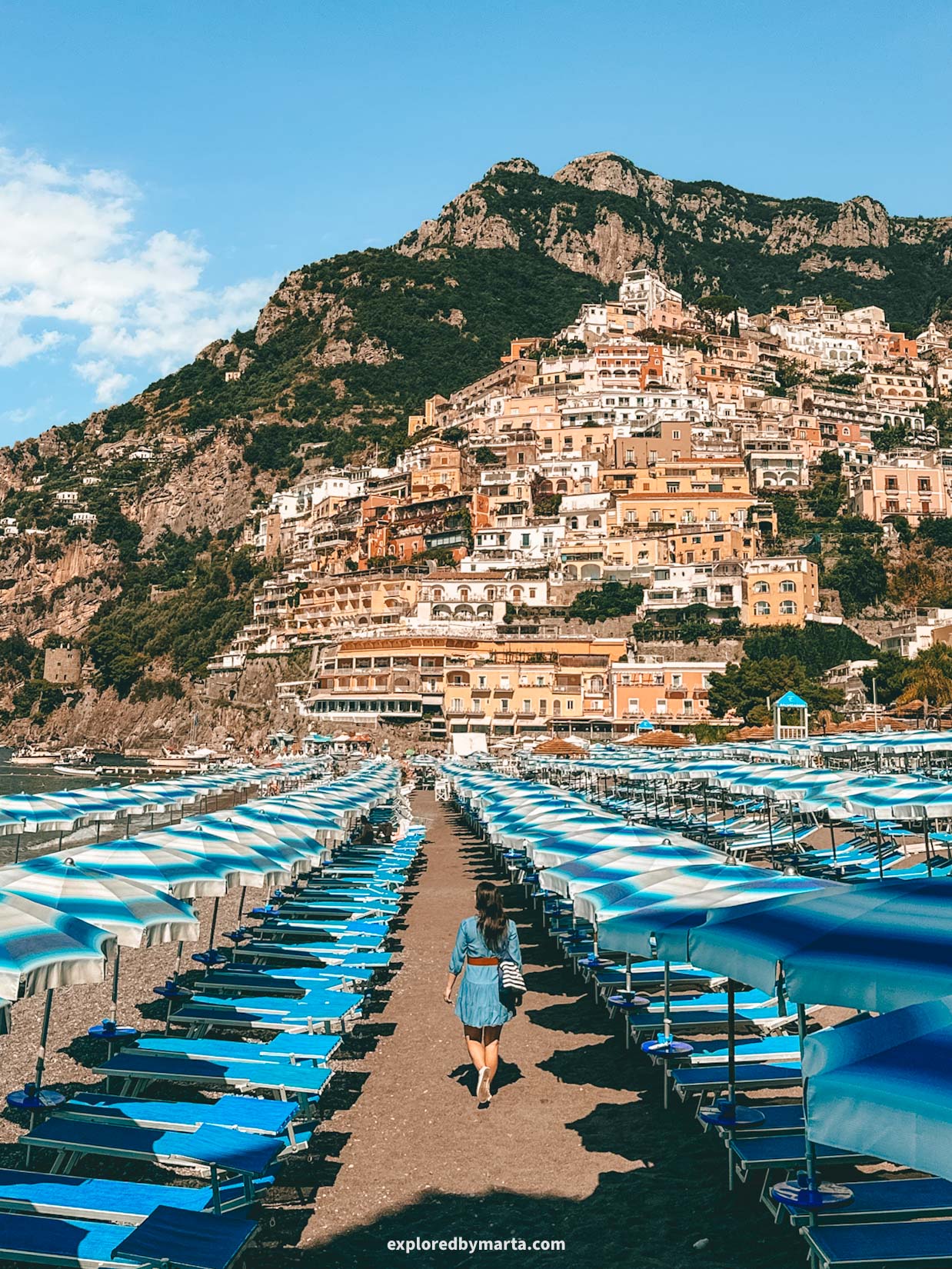
Positano is not only one of the best places to visit on the Amalfi Coast, but it is also known as one of the most iconic destinations in the world!
And I’m sure you have seen this postcard view of Positano beach, or Spiaggia di Positano, with its lines of beach umbrellas and the iconic Positano hill in the background, all over social media!
No wonder this is one of the most photographed places on the Amalfi Coast! Just look at those colorful houses built one on top of the other!
Apart from that, the main beach in Positano is also a fantastic place to go for a swim. The scenic location and the clear waters of the Mediterranean Sea make it a one-of-a-kind spot for a beach day.
Like everywhere else in the area, part of the beach is a paid section where you have to rent a beach chair and an umbrella, but there is also a smaller part of the beach that is accessible for free. Arrive early to grab the best spot!
Location: Spiaggia di Positano
2. Amalfi Cathedral
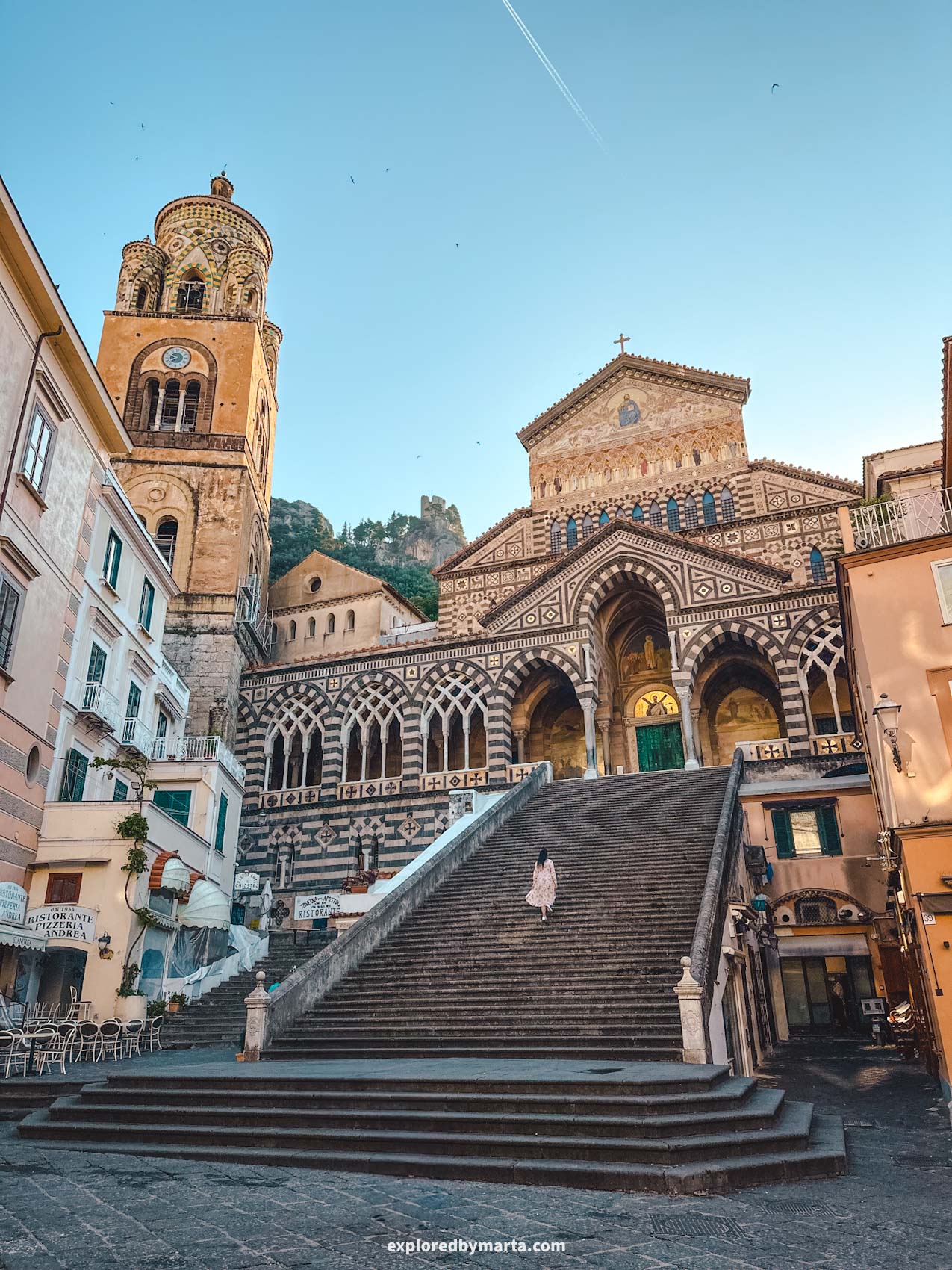
Now time for one of my favorite places to visit on the Amalfi Coast!
The majestic Duomo di Amalfi, or Cathedral of Saint Andrew, located in Piazza del Duomo in Amalfi town, is one of the most iconic landmarks and one of the most beautiful places on the Amalfi Coast.
The cathedral boasts an imposing staircase that leads to the entrance. Climbing these stairs is one of the must-do things when visiting this town! From the top, you get a great overview of the whole Piazza del Duomo square!
The Amalfi Cathedral dates back to the 9th century and is dedicated to Saint Andrew the Apostle, whose bones are buried in a crypt inside the cathedral. You can visit it for a small entrance fee.
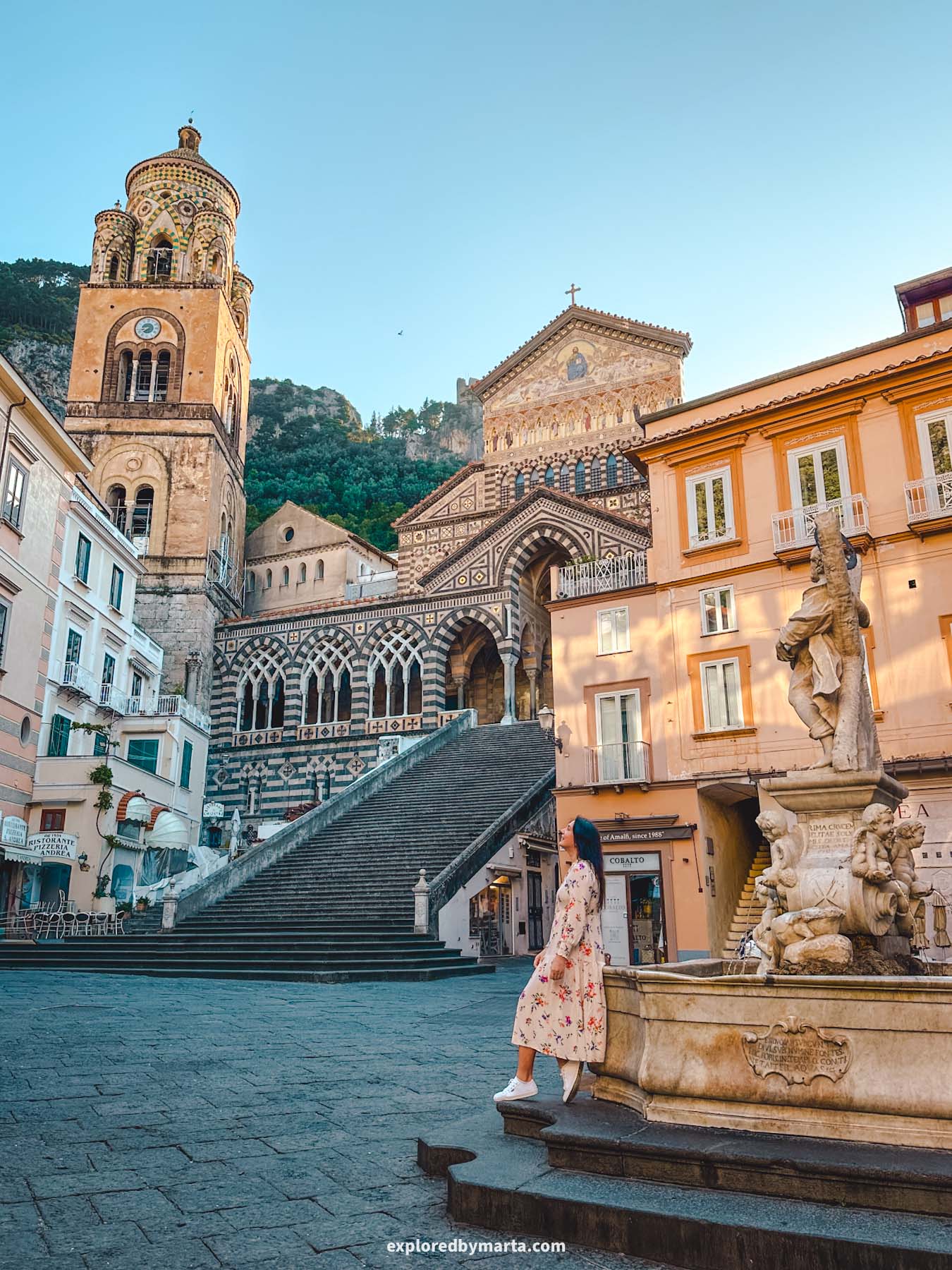

However, the most striking thing about this cathedral is its architecture – the striped façade, arches, and mosaics perfectly reflect Amalfi’s rich and diverse history.
As a powerful maritime republic, Amalfi traded with many nations, and the cathedral showcases that cultural blend – its architecture features a unique mix of Arab-Norman, Gothic, and Baroque styles.
Amalfi is one of the most popular towns on the Amalfi Coast, if not the most popular, so arrive early to explore all its beauty without crowds. This square in front of the cathedral is probably the most crowded place I have seen on the Amalfi Coast!
Location: Duomo di Sant’Andrea Apostolo
3. Spiaggia di Atrani


I will tell you a secret – despite its famous neighbors, Atrani was my favorite village on the Amalfi Coast. There is just something special, something unique about this place!
Known as the smallest town in Italy (only 0.12 square kilometers or 0.05 square miles), it gets completely overlooked by most travelers, and, to be honest, I’m not mad about it at all!
It is always nice to escape the buzz of Amalfi town and walk 10 minutes to the charming small town of Atrani and find it so peaceful, but equally beautiful.


The top thing to do in Atrani village is to enjoy the iconic Spiaggia di Atrani, or Atrani Beach, one of my favorite places on the coastline – largely thanks to its dramatic scenery with flanking cliffs and the iconic arcade lining the beachside.
No wonder this place has been a filming location for many TV series and movies. Did you also watch Denzel Washington live here in The Equalizer 3? Yeah, me too.
If you have some time to spare while visiting Amalfi town, I highly recommend walking over to Atrani to at least take a peek at this iconic place. It is just a 10-minute walk from Amalfi through a pedestrian tunnel.
Location: Atrani Beach
4. Path of the Gods, or Sentiero degli Dei
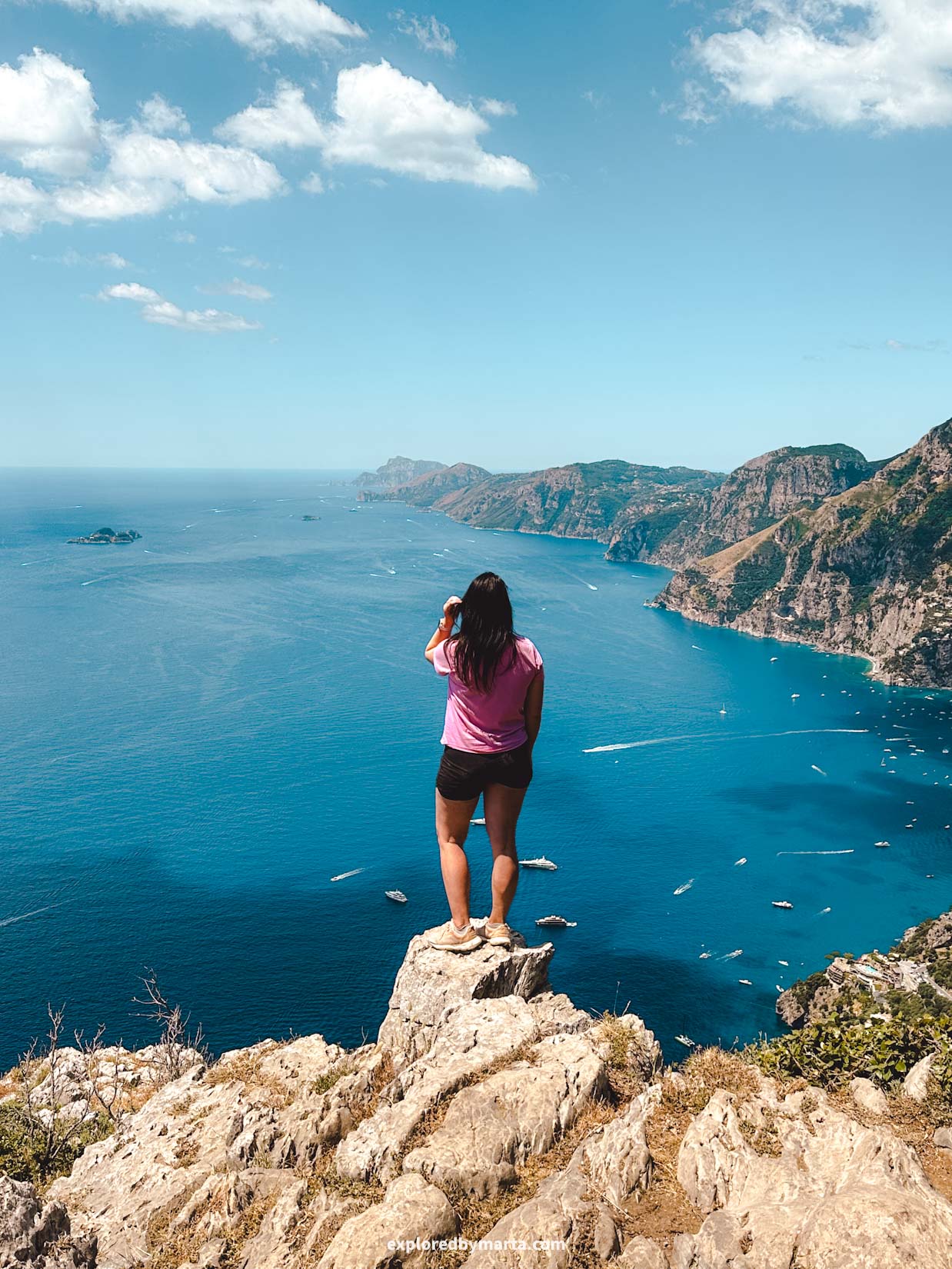
There are very few places on the Amalfi Coast that can compete with the beauty of the Path of the Gods, the most breathtaking hike on the Amalfi Coast, and one of the most beautiful hikes in Italy.
Did you even visit the Amalfi Coast if you didn’t hike this trail? If you don’t want to go solo, check some guided tours below!
I my opinion, there is no better way to see the natural beauty of the Amalfi Coast and the whole Sorrento Peninsula than by hiking the famous Path of the Gods hike.
The Path of the Gods is an ancient pathway in the mountains of the Sorrento Peninsula that connects two mountain towns: Agerola and Nocelle.
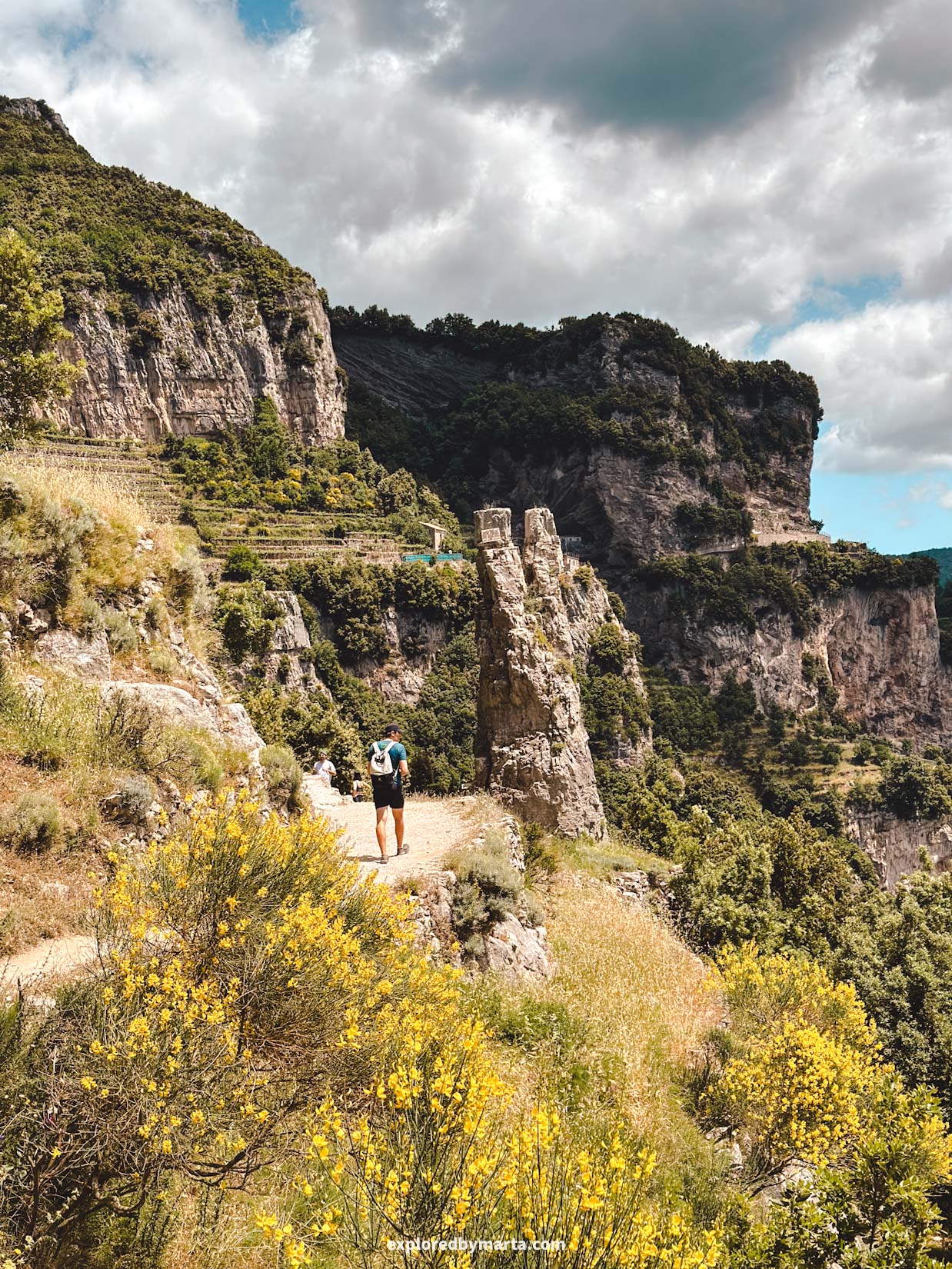
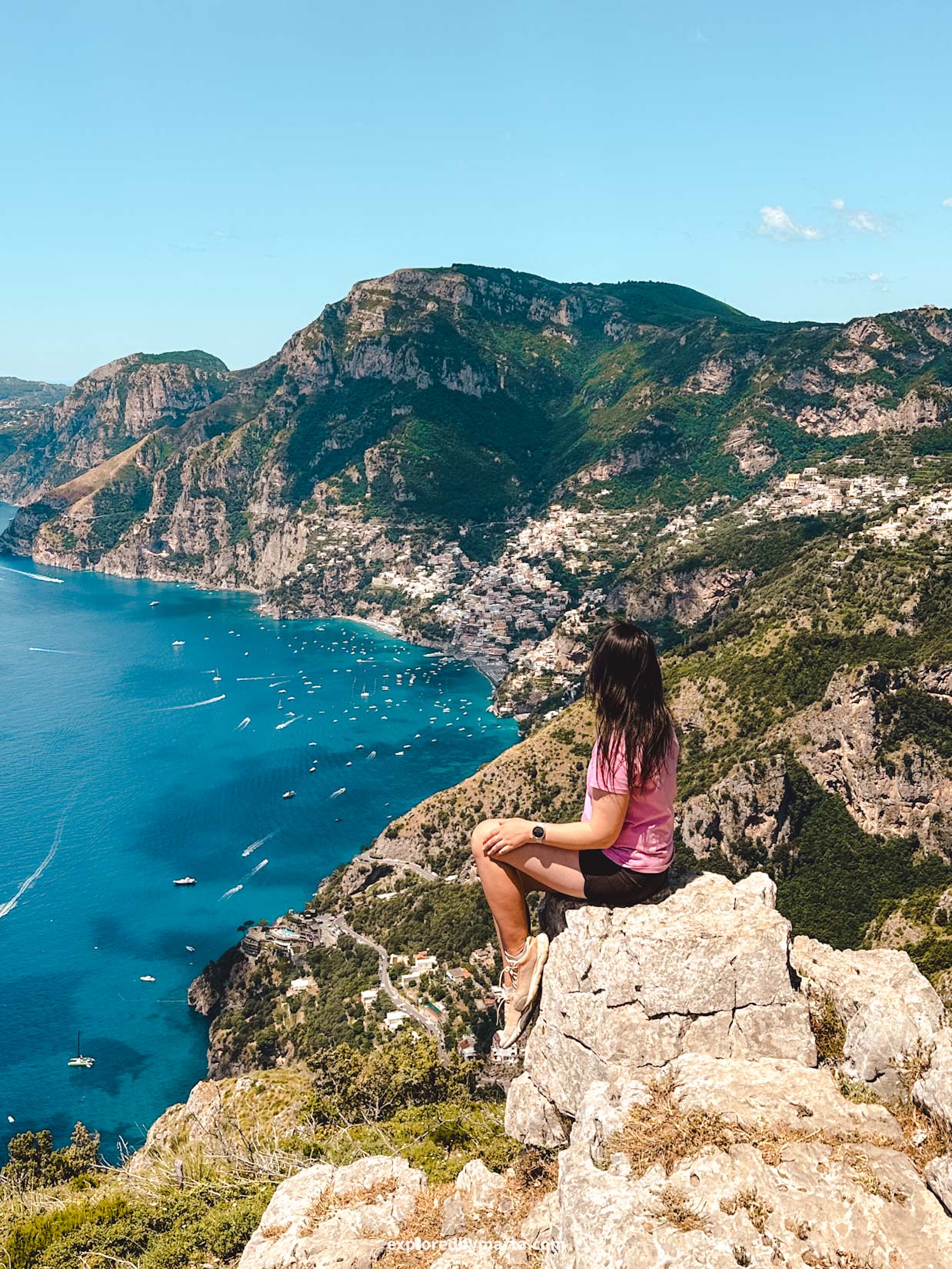
The hike starts in the center of Bomerano hamlet in Agerola and finishes in Nocelle village right above Positano. However, these days people hike different versions of this hike, like Agerola-Positano or Praiano-Positano, etc.
It depends on where you are staying, as well as your transportation possibilities.
For us, we had our own car, so we hiked from Agerola to Nocelle and then walked all the way back to get back to our car. Otherwise, I would have hiked from Agerola to Positano and then tried to get to my hotel by the local SITA bus.
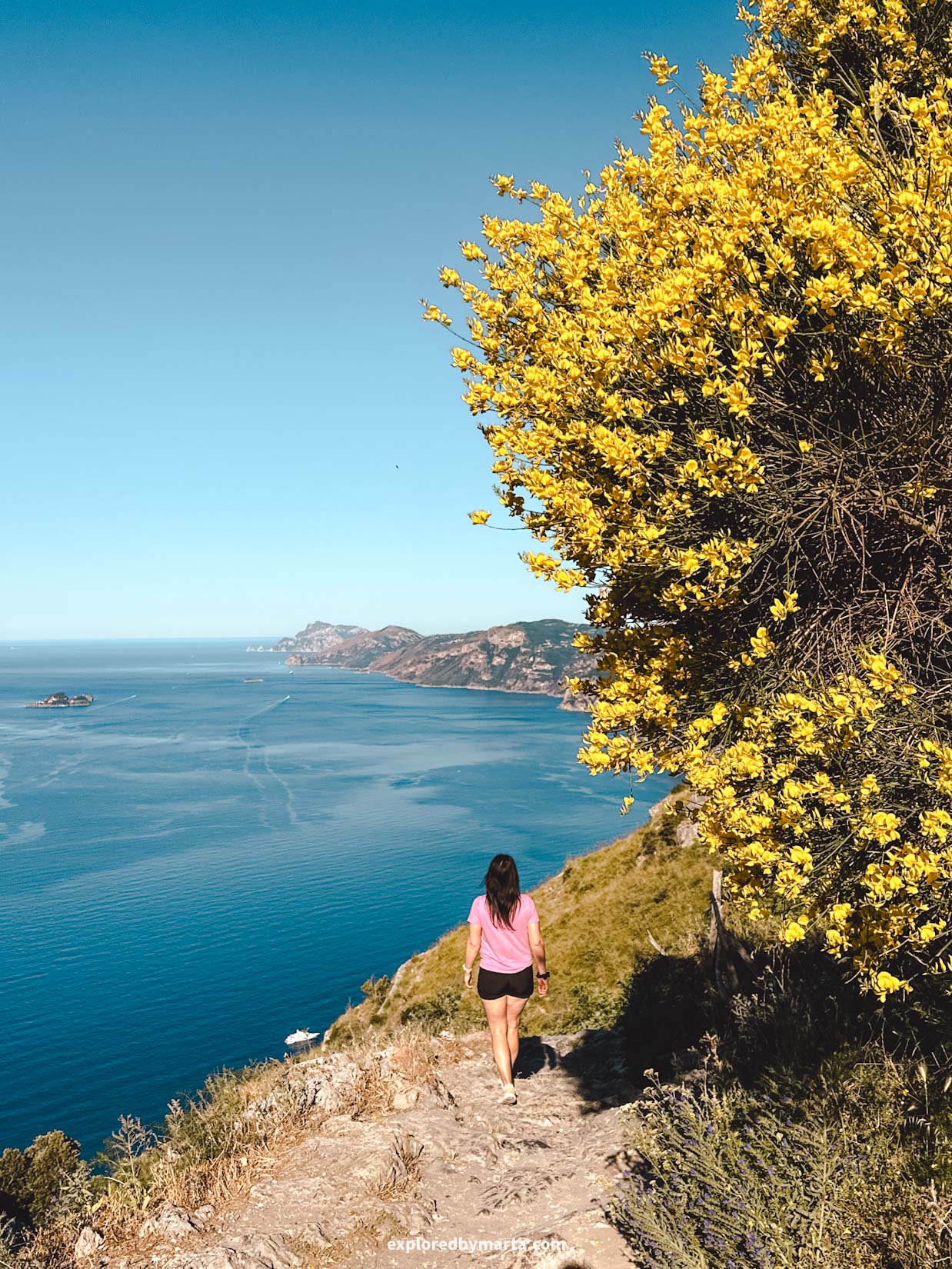
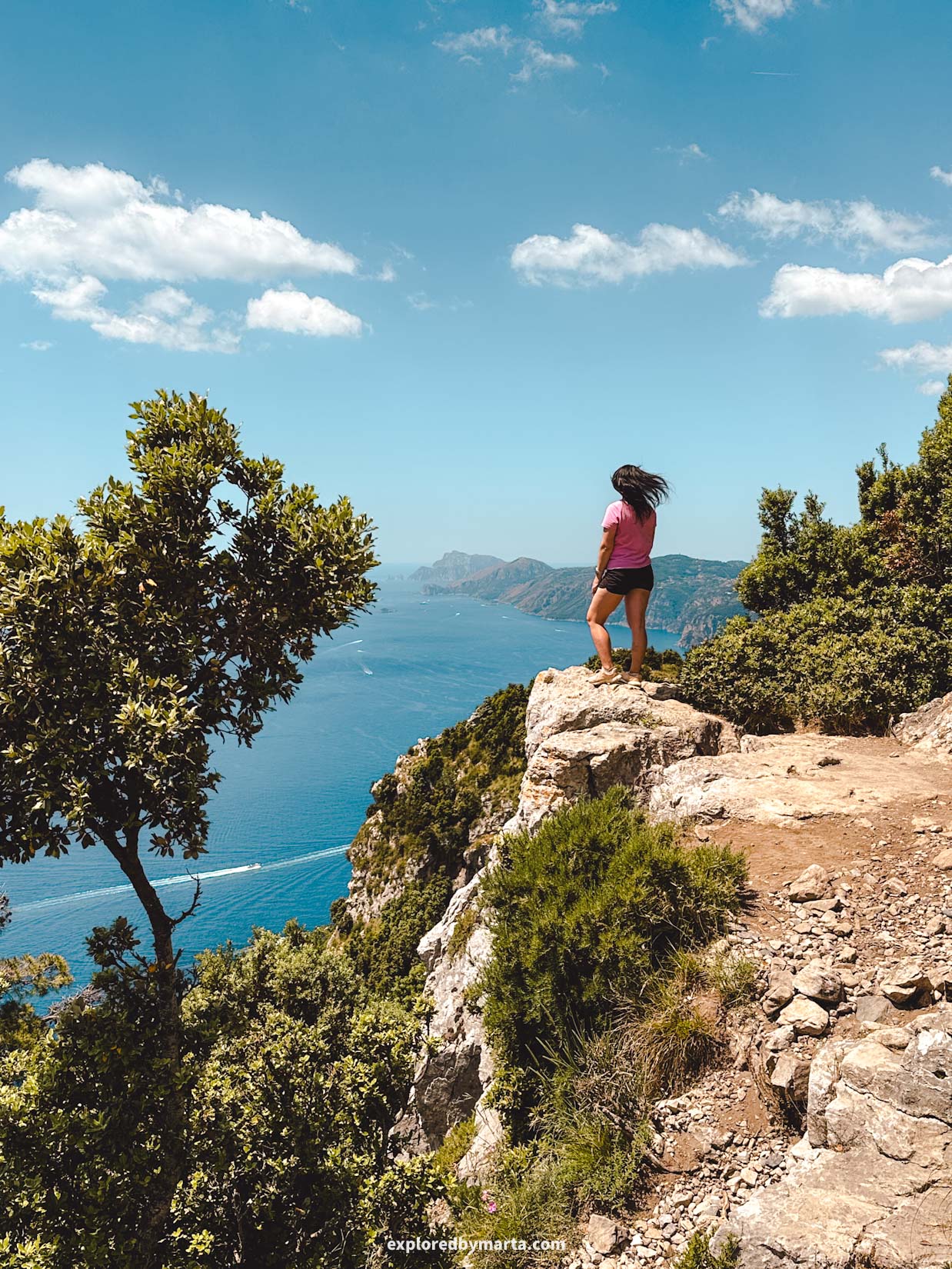
Our route was a moderate difficulty 12.3-kilometer or 7.6-mile out-and-back hike that took us 3h 30min. We did the hike in the morning to avoid the midday heat. Whichever route you decide to go, you need to plan how to get back to where you need to be.
If you want to finish in Positano, you’ll have to hike a steep climb down the stairs from Nocelle to the beach in Positano. But there is also an option to take a taxi or to wait for the public bus to take you down to Positano.
Either way, you have many options while hiking this trail!
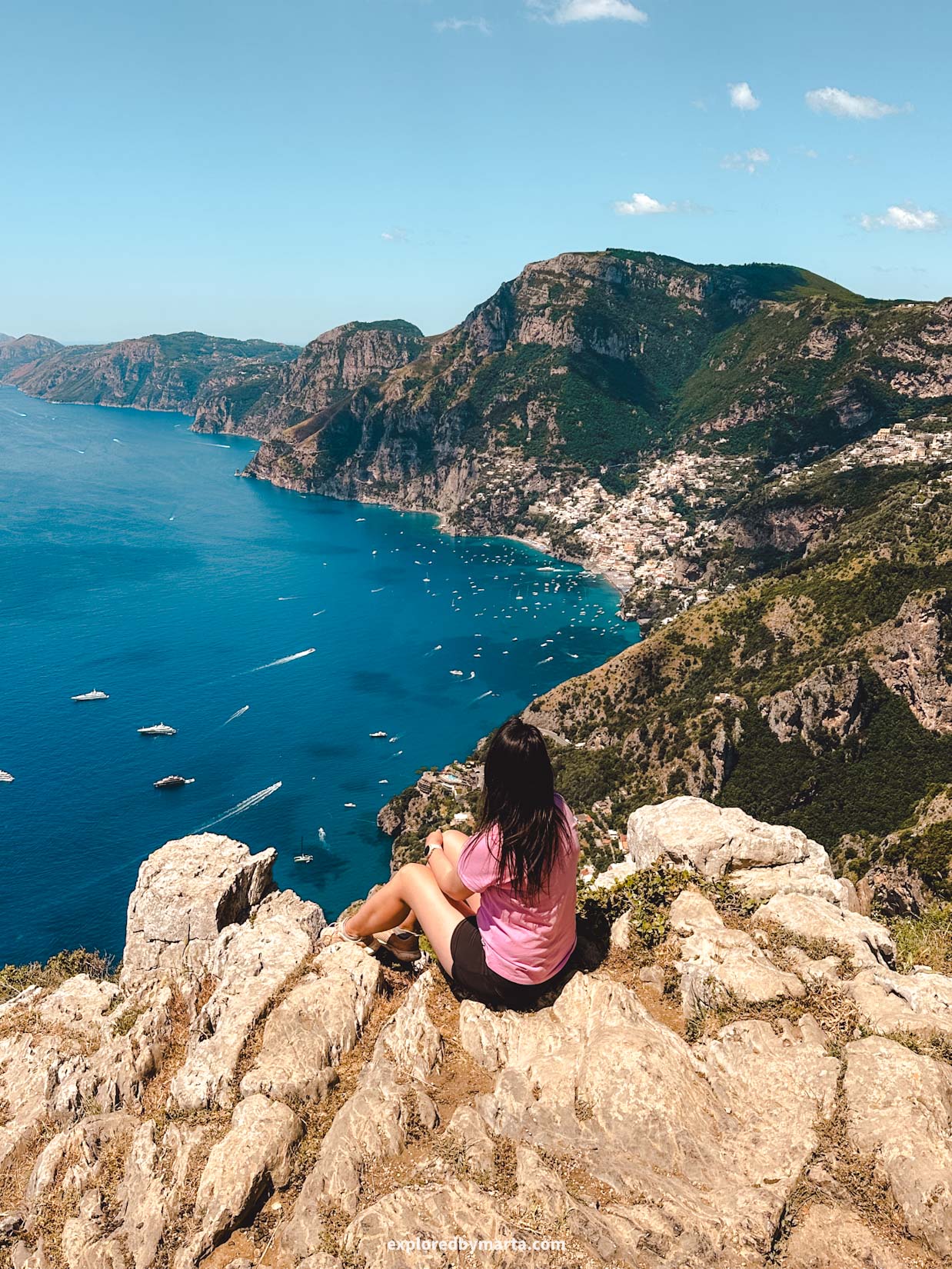
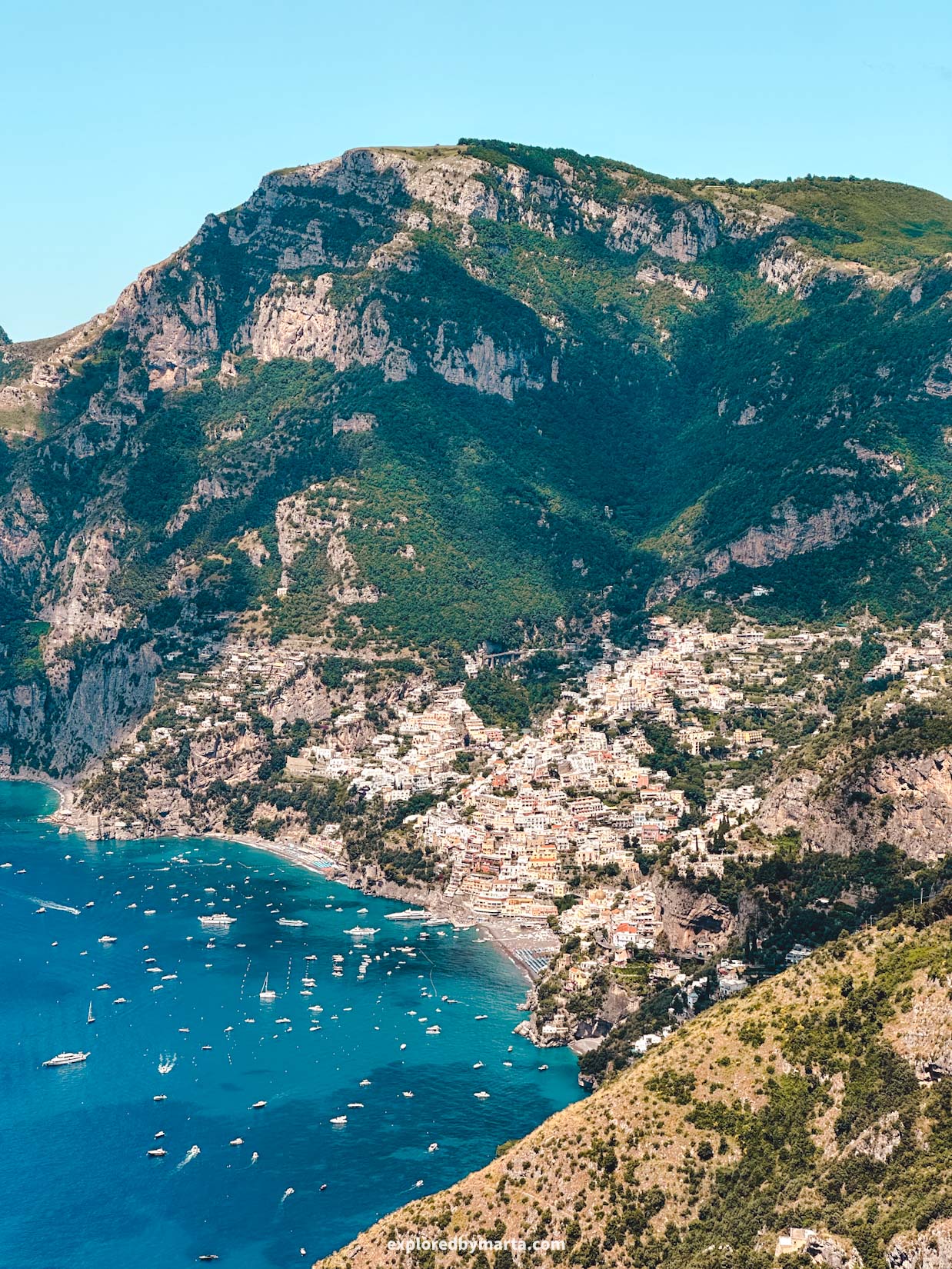
But can you tell from the pictures why this is one of the best places to visit on the Amalfi Coast? I actually didn’t expect much from it, but I was pleasantly surprised by these views. I had my phone out all the time, and I took way too many photos to post here, haha.
But I have to admit that the most beautiful part of the trail is closer to Positano, where you can see the majestic cliffside village in the distance and the dramatic mountains behind it.
To me, the section between Praiano and Nocelle was the best part of the whole hike! If you have a chance to walk the Path of the Gods, I highly recommend doing it! Those will be memories for a lifetime, that’s for sure!
Location: Start of the Path of the Gods
5. Fiordo di Furore
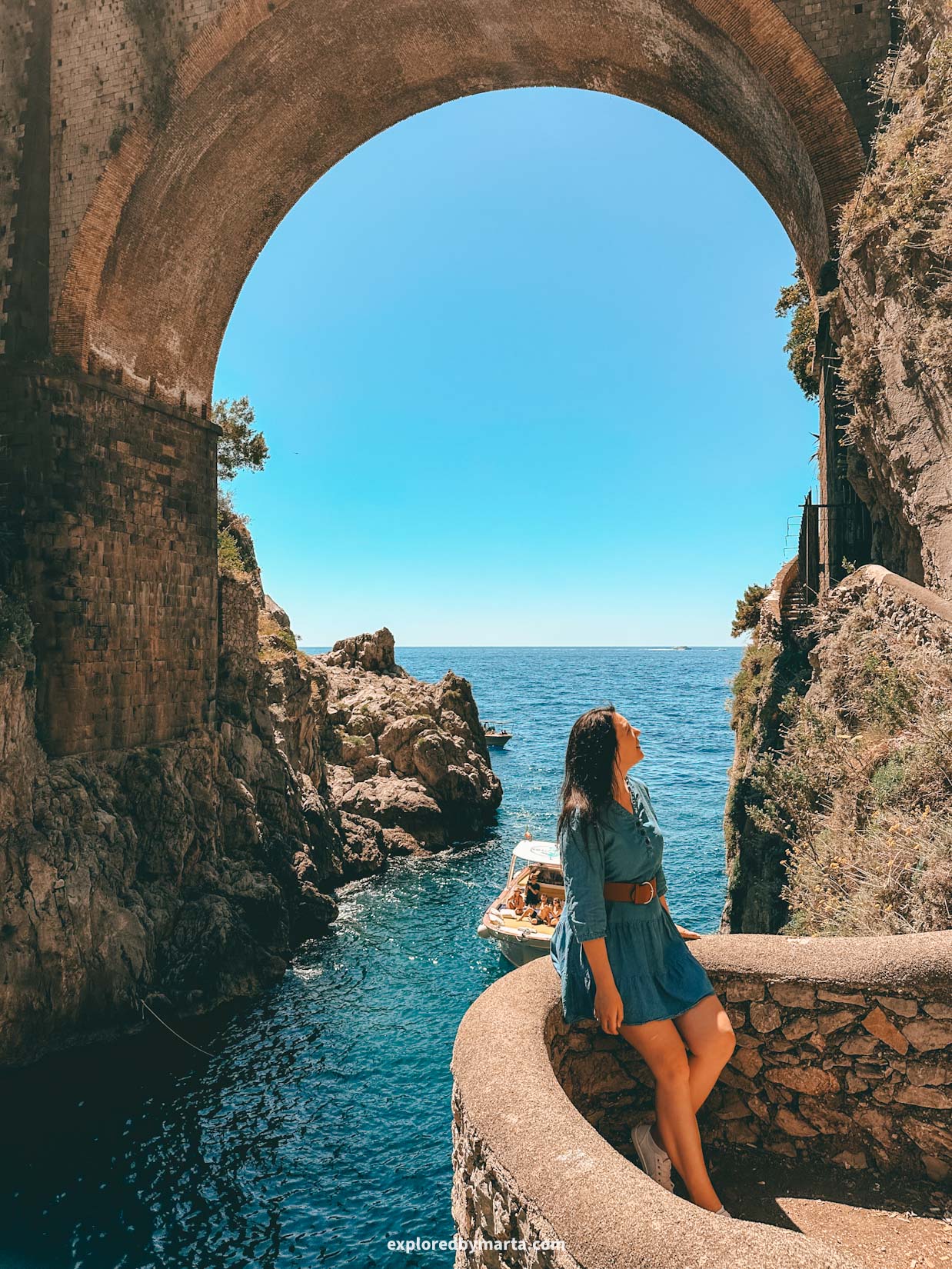
Say hello to one of the most unique places on the Amalfi Coast: Fiordo di Furore!
I’m sure you’ve seen this deep and narrow cove all over the internet – it is one of the most famous spots and one of the top places to visit on the Amalfi Coast.
Despite its name (fiordo=fjord), technically it is not a fjord, because fjords are formed by glaciers, but this fjord-like gorge was formed by a river. Nevertheless, this place is pure beauty!
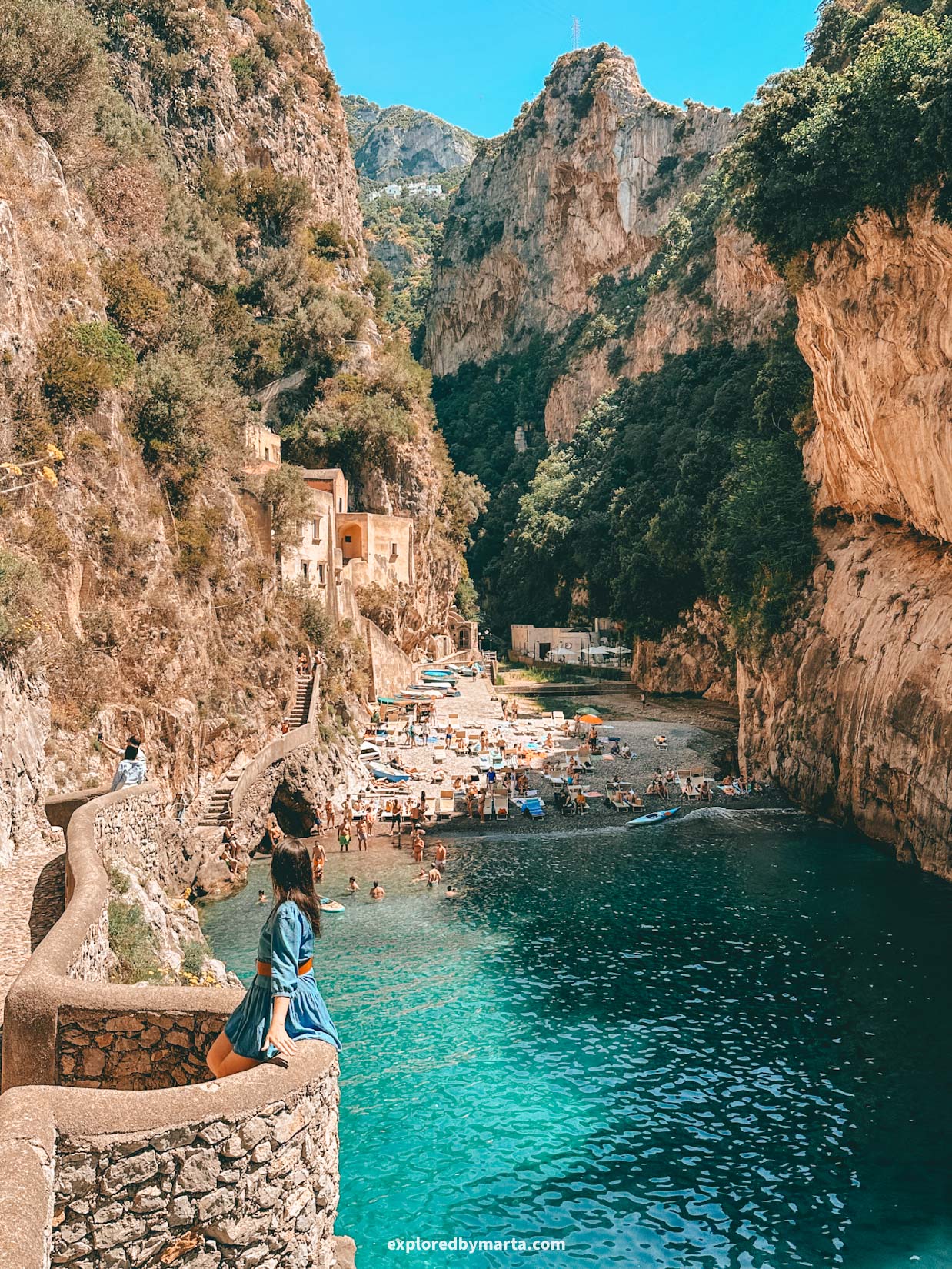
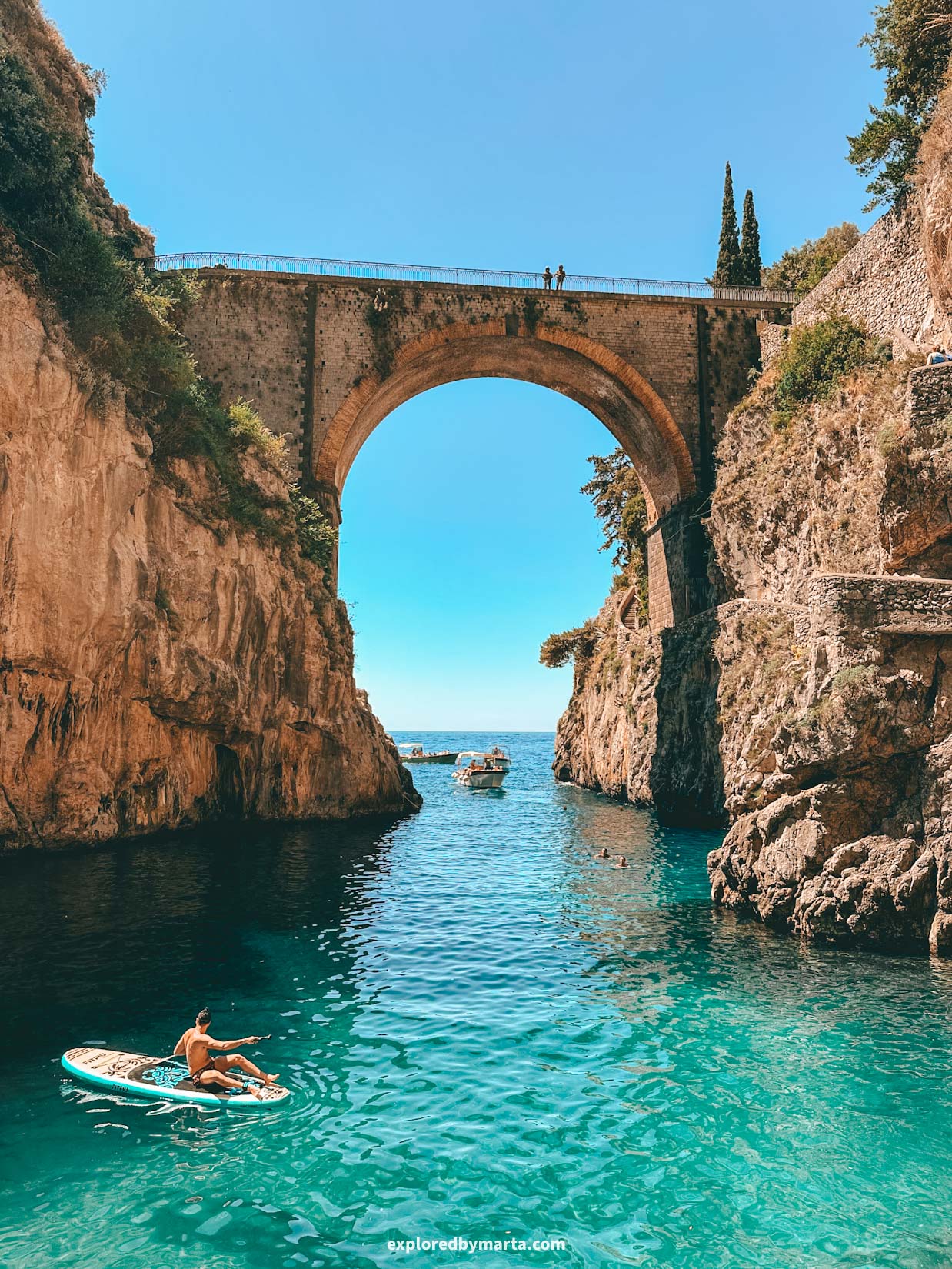
Thanks to its dramatic cliffs, 30-meter arched bridge, fishermen’s houses built inside the rock, and pristine waters washing the tiny pebble beach, Fiordo di Furore has become a landmark place to visit on the Amalfi Coast.
Because of its unique setting, Fiordo di Furore regularly hosts an extreme diving competition with athletes jumping from the iconic bridge! Wild!
The easiest way to get to Fiordo di Furore is by SITA SUD public bus – there is a bus stop right on top of the bridge. Then just follow a steep, narrow stairway down to the beach.
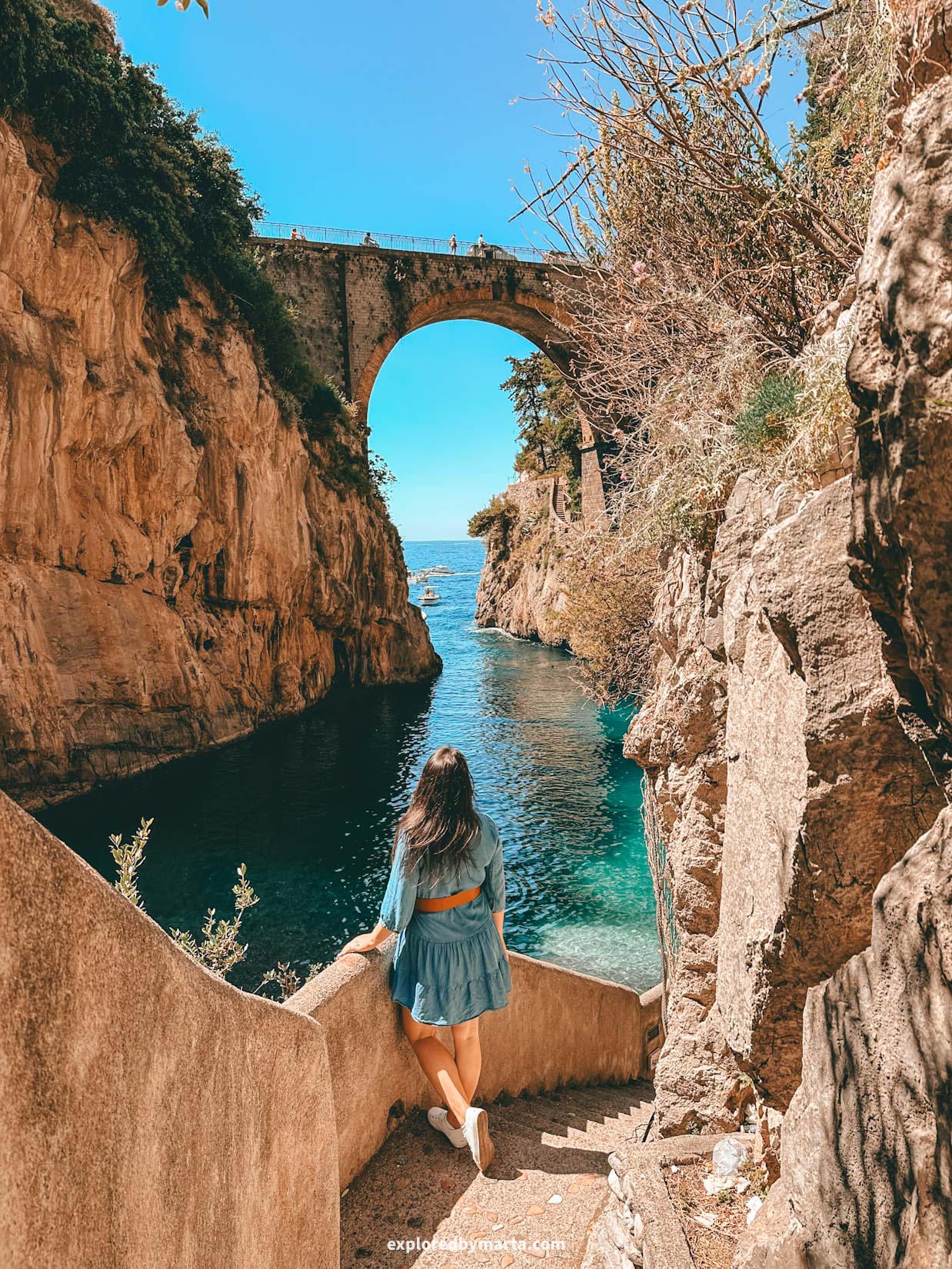
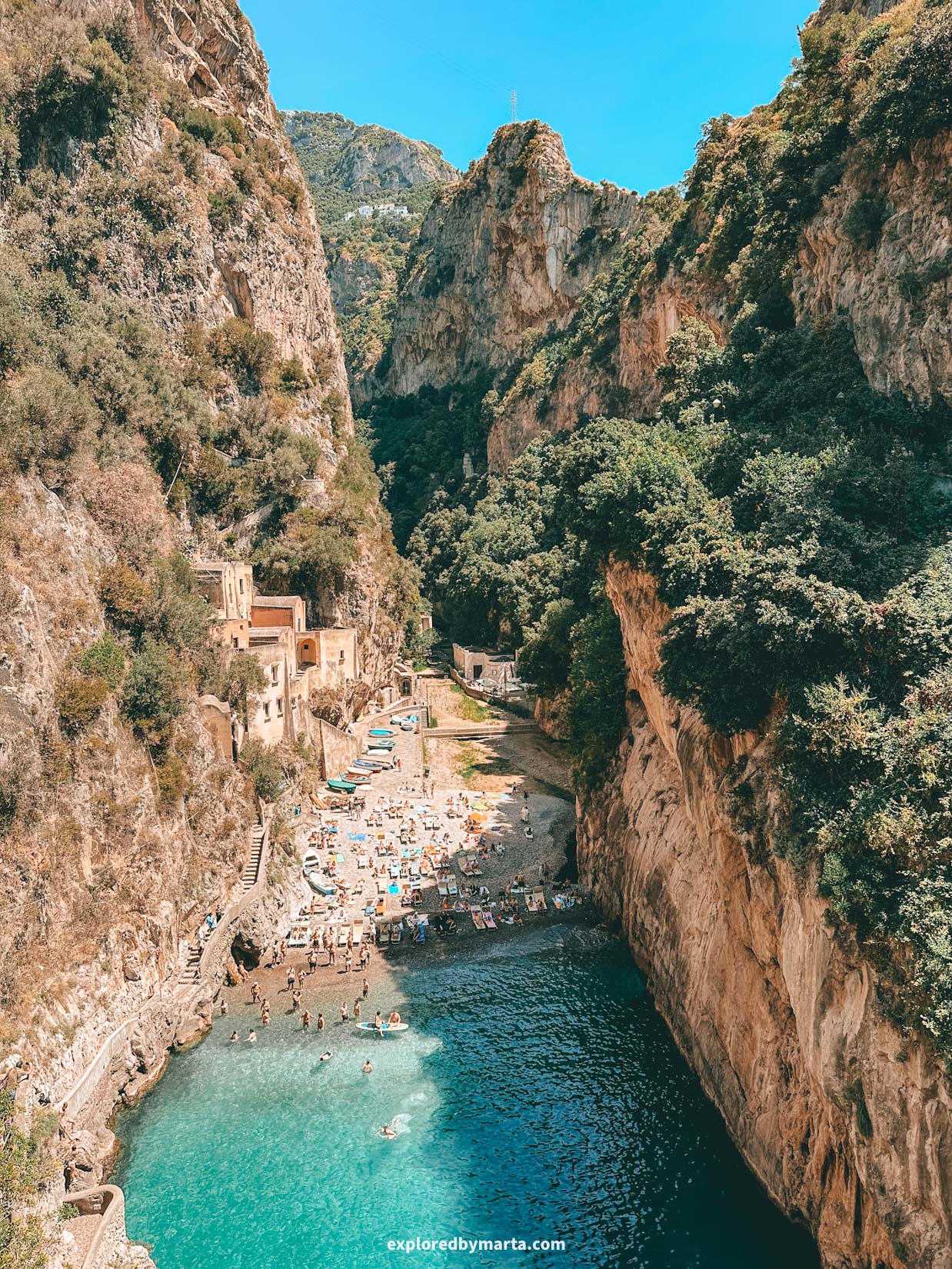
We had a rental car, so we drove to Marina di Praia, parked our car there, and then walked all the way to Fiordo di Furore (it’s a 10-15 minute walk). If you rent a scooter, you will definitely find some parking spots along the road, much closer to the fjord.
Because of its surrounding rugged cliffs, the sun only shines inside the fjord for a couple of hours during the day, so this place has a pleasant microclimate and offers nice shade during the summer heat!
Whether you visit Fiordo di Furore to spend the day by the beach or just come to check out its picturesque location and take some iconic photos, you will definitely be impressed by how beautiful this unique place is. I liked it a lot!
Location: Fiordo di Furore
6. Terrace of Infinity at Villa Cimbrone


Visiting Ravello should be on every Amalfi Coast bucket list for one reason: the Terrace of Infinity at Villa Cimbrone!
Everyone who visits this clifftop town on the Amalfi Coast comes to see the breathtaking historical Villa Cimbrone with its vast gardens, panoramic views, and, of course, the fairytale-like Terrace of Infinity with marble busts lining the cliffside.
It has to be one of the most photo-perfect places you will find along the coastline!


Originally built back in the 11th century, Villa Cimbrone has lived a truly eventful life.
Throughout its existence, it has been a residence for many different influential families until the 1970s, when it was turned into a luxury hotel.
Over time, the villa was rebuilt and extended, and very little remains of the original structure today. It features different architectural styles like Gothic, Moorish, and Venetian, combined with English-style landscaping.


You cannot tour the hotel unless you stay there as a guest, but the majority of the property is open to the public (for an entrance fee).
As a visitor, you can visit a cloister, a temple, multiple beautiful gardens, and the famous Terrace of Infinity. It is not the cheapest attraction on the Amalfi Coast, but it is totally worth it!
You don’t have to book anything in advance. We arrived in Ravello early in the morning and came to Villa Cimbrone as soon as it opened so we could explore the famous estate without crowds.

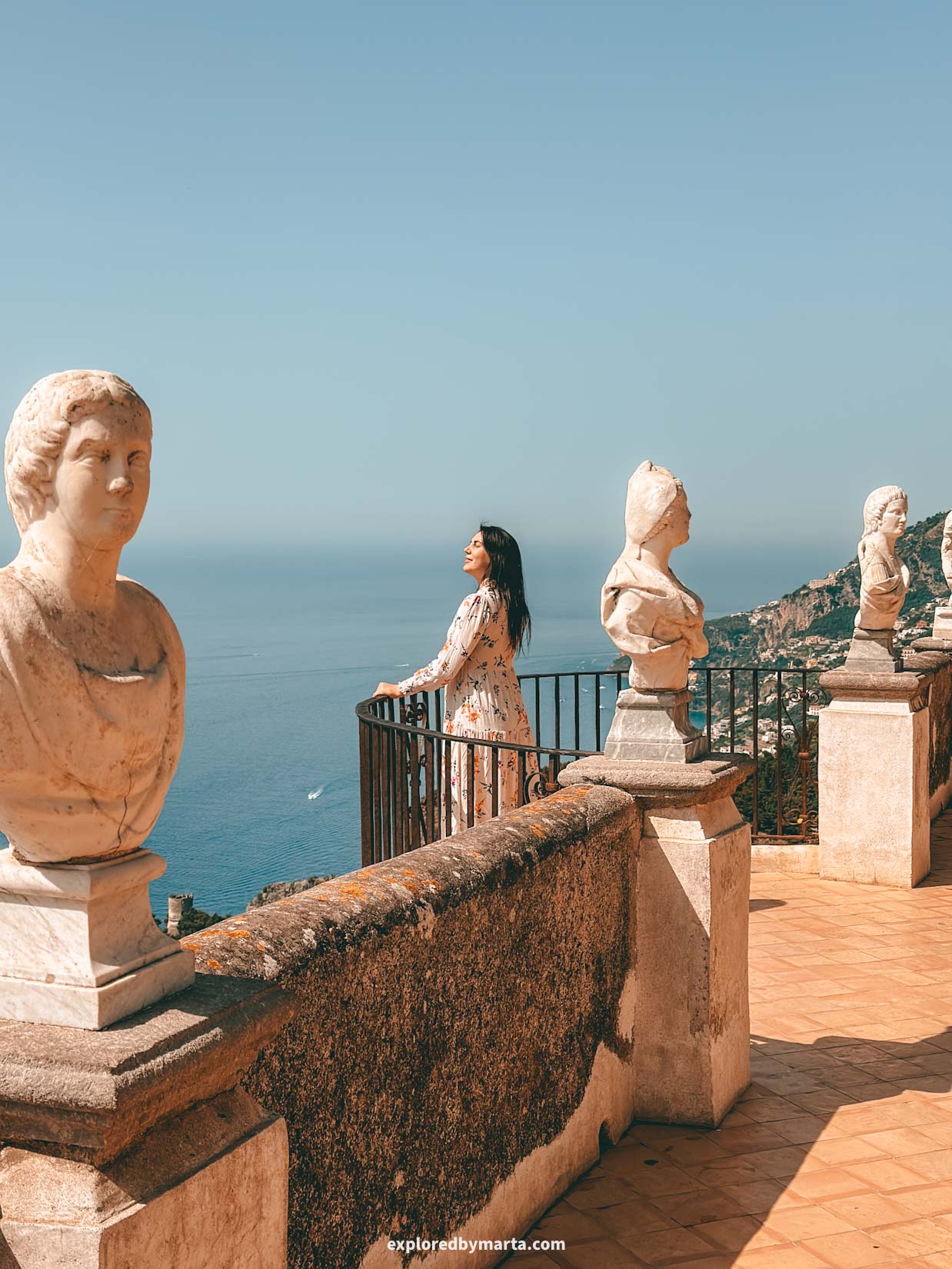
Villa Cimbrone has hosted many celebrities and international dignitaries, and many regard the terrace as one of the most stunning places in Italy.
People like Jacqueline Kennedy, actor Denzel Washington, actress Greta Garbo, as well as Winston Churchill, some members of royalty, and even the surrealist artist Salvador Dalí have all visited this place.
It is absolutely breathtaking, especially the panoramic views of the Mediterranean Sea from the famous terrace. I hope my photos do some justice to the beauty of Villa Cimbrone! There is truly nothing like this place on the Amalfi Coast.
Location: Villa Cimbrone – Terrace of Infinity
7. Belvedere Cimitero in Amalfi

Talking about places with amazing views, you should also add the Belvedere Cimitero viewpoint right next to Amalfi’s cemetery on your list of the top places to visit on the Amalfi Coast!
I love seeing places from above, so exploring the breathtaking views this viewpoint offers was one of my favorite things to do in Amalfi town. You can reach this viewpoint on foot by climbing the stairs behind the cathedral or the ones by the beach.
The Belvedere Cimitero viewpoint offers beautiful views of the whole town, the Amalfi port, as well as the mountains and the rugged coastline. The area is surrounded by lemon trees and plants. Possibly the best view in Amalfi town!
Location: Belvedere Cimitero
8. Sentiero dei Limoni, or Path of the Lemons
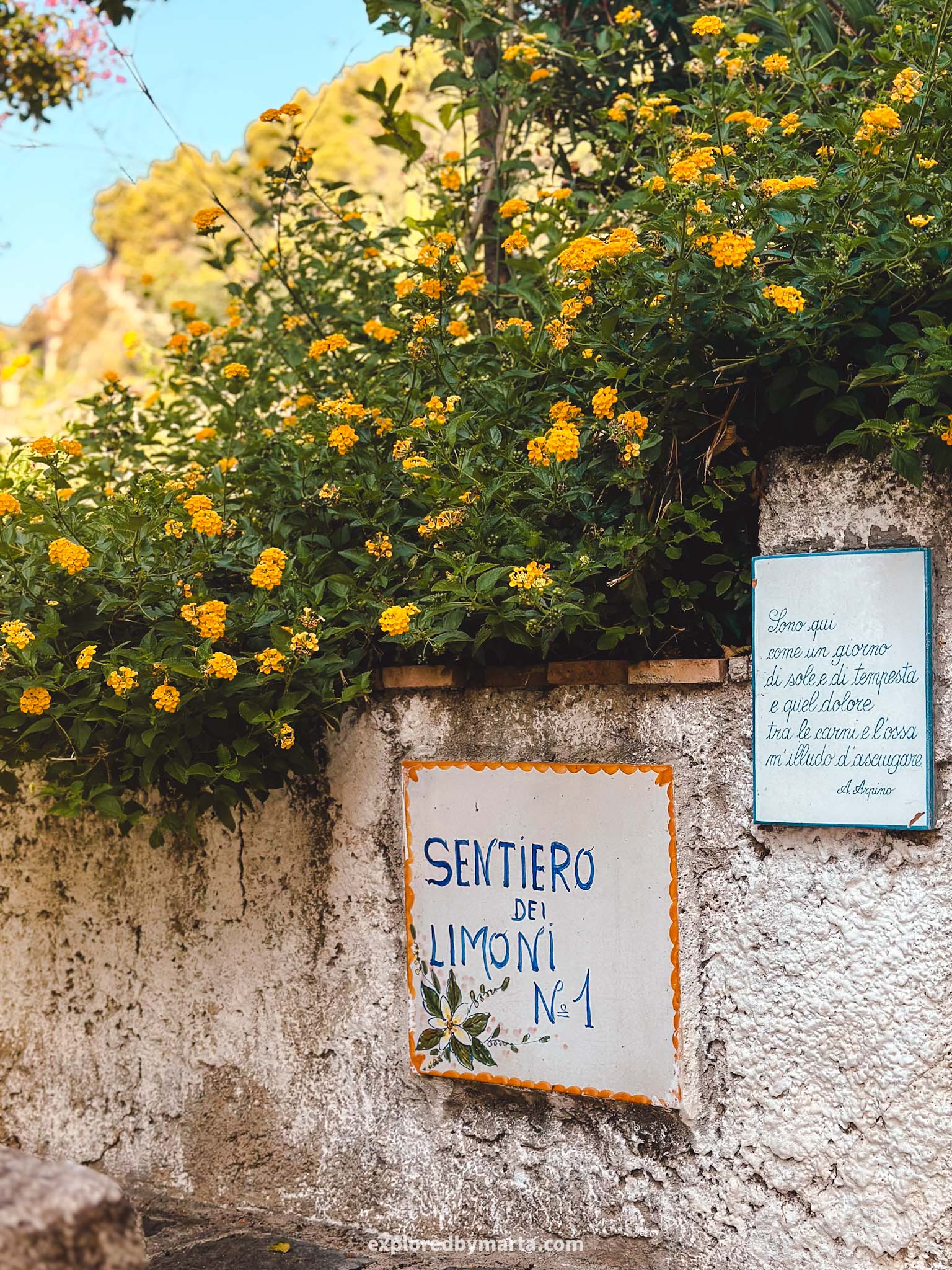
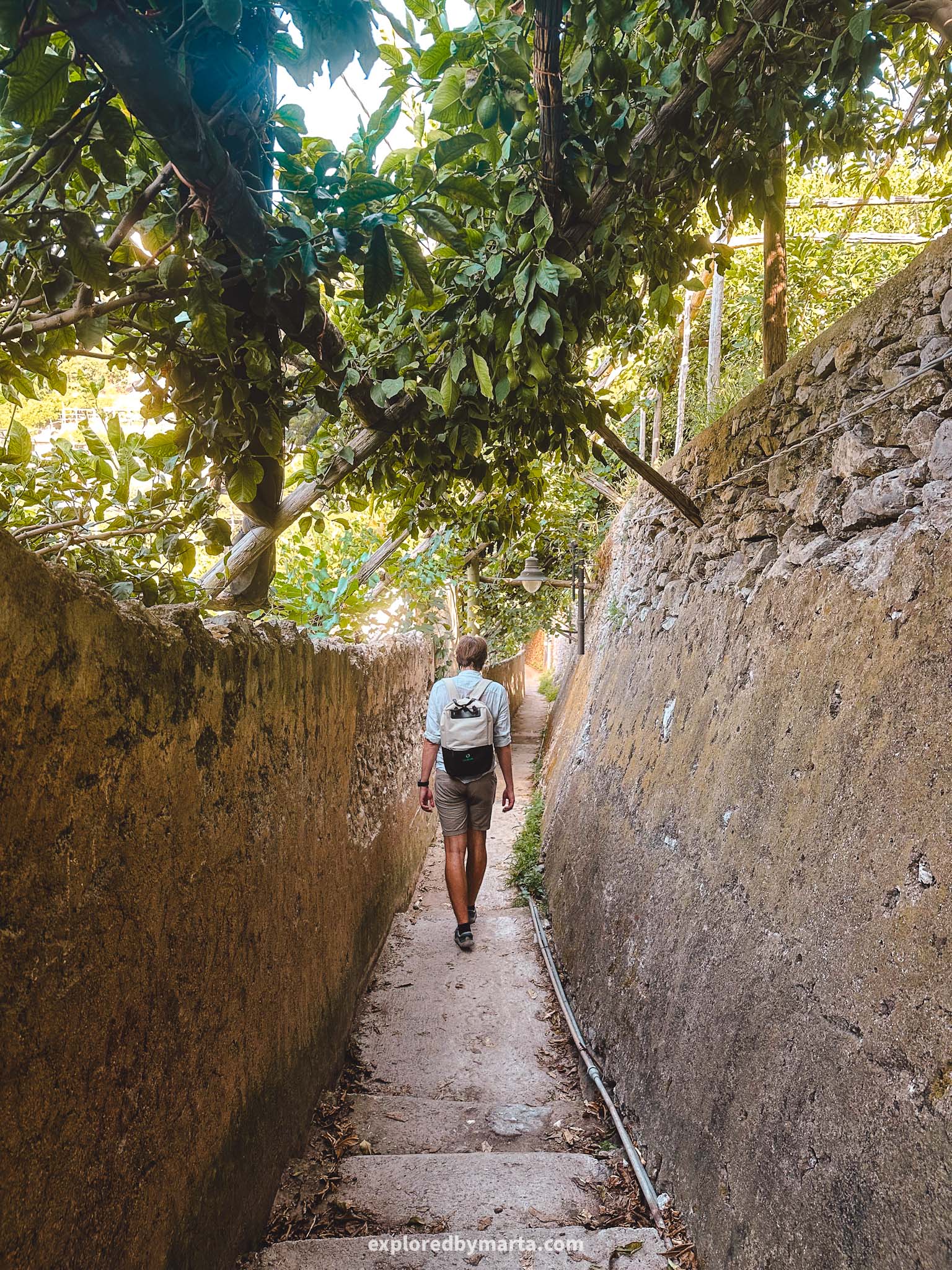
Sentiero dei Limoni, or Path of the Lemons, is one of the most famous Amalfi Coast trails. It is a historical path connecting two nearby towns – Minori and Maiori.
The path is only 2 kilometers or 1.2 miles long (one way), making it one of the easiest hikes on Italy’s Amalfi Coast – totally manageable for kids and travelers of different fitness levels! So, if you love shorter hikes, then this is the one for you!
However, the path goes over a 100-meter-high hill between the two towns, so there will be some climbing involved, but that’s the hardest part. If you don’t want the hassle of planning, you can also join a guided tour to the Path of the Lemons!
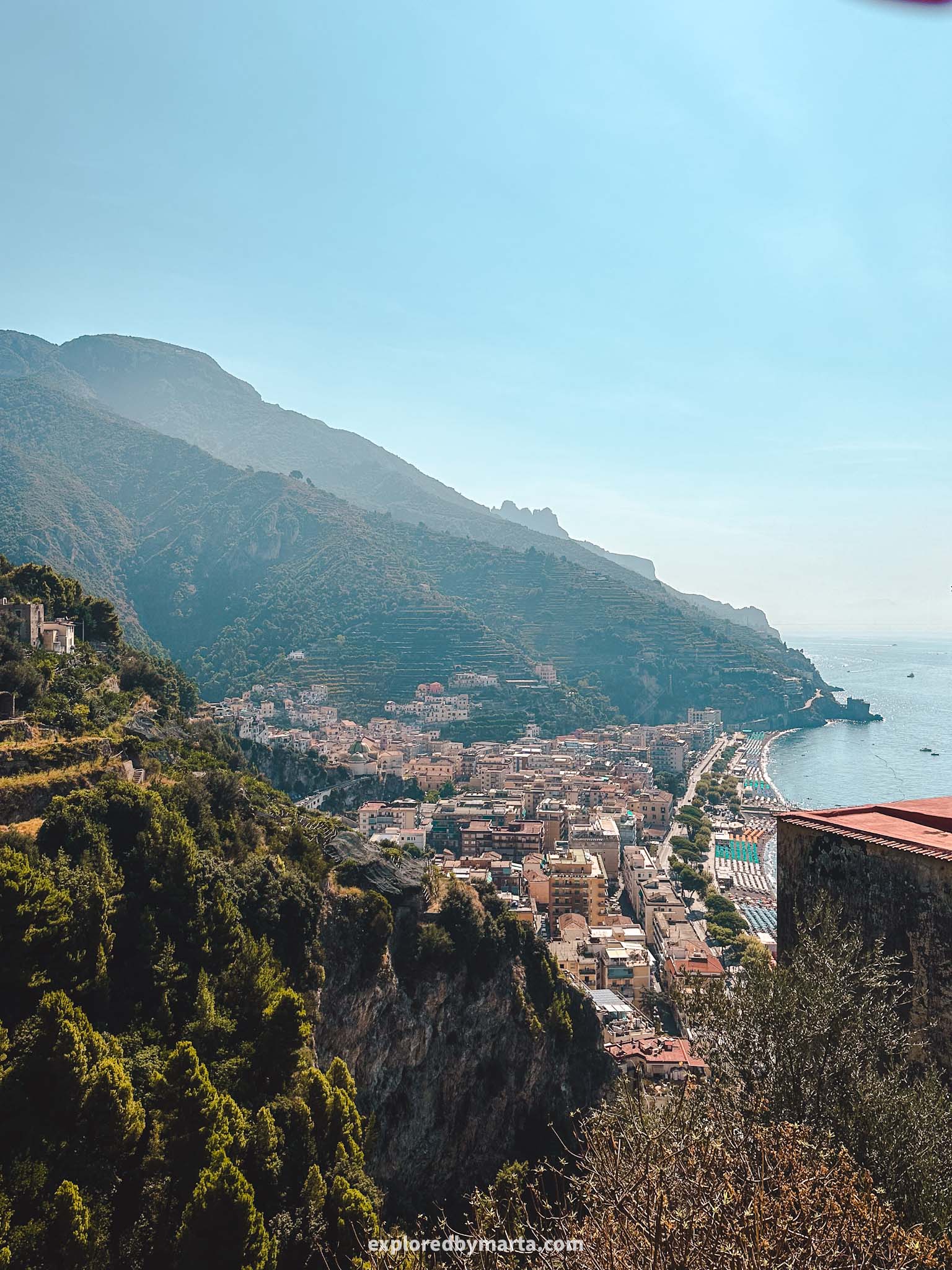
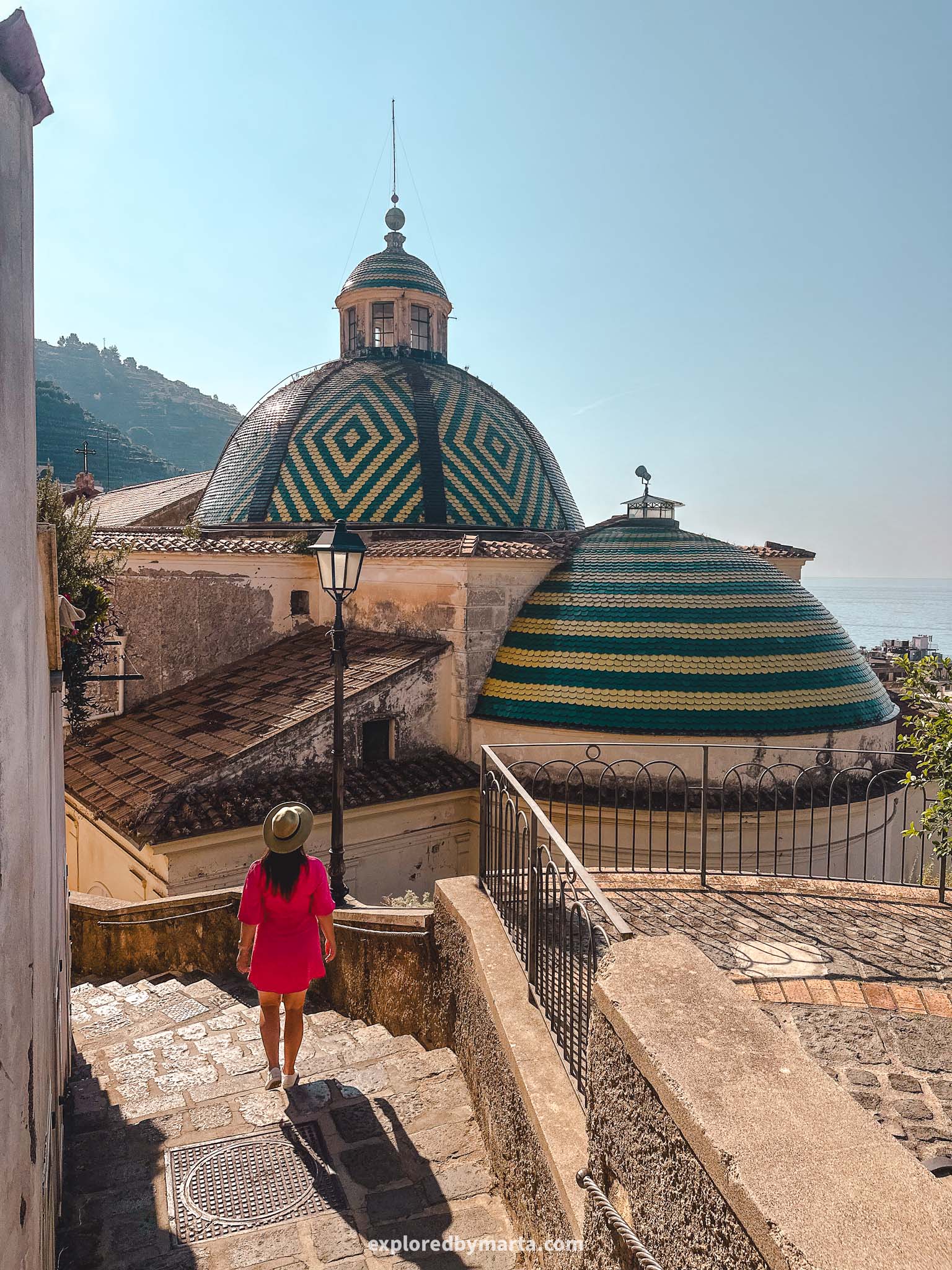
We did this hike starting from Maiori town. The hike starts next to the Santuario Santa Maria a Mare church in Maiori and finishes down in Minori town. We then explored Minori for a bit and walked by the coastal road back to Maiori.
This hike is known for its panoramic views of the coastline and the Tyrrhenian Sea, as well as the surrounding lemon groves where you can see the local pride and joy – the famous Amalfi lemons (sfusato amalfitano).
The path is mostly paved, and there’s no need to have special clothes or footwear to do this hike, but do grab some water bottles with you, as it can get pretty hot during the day.
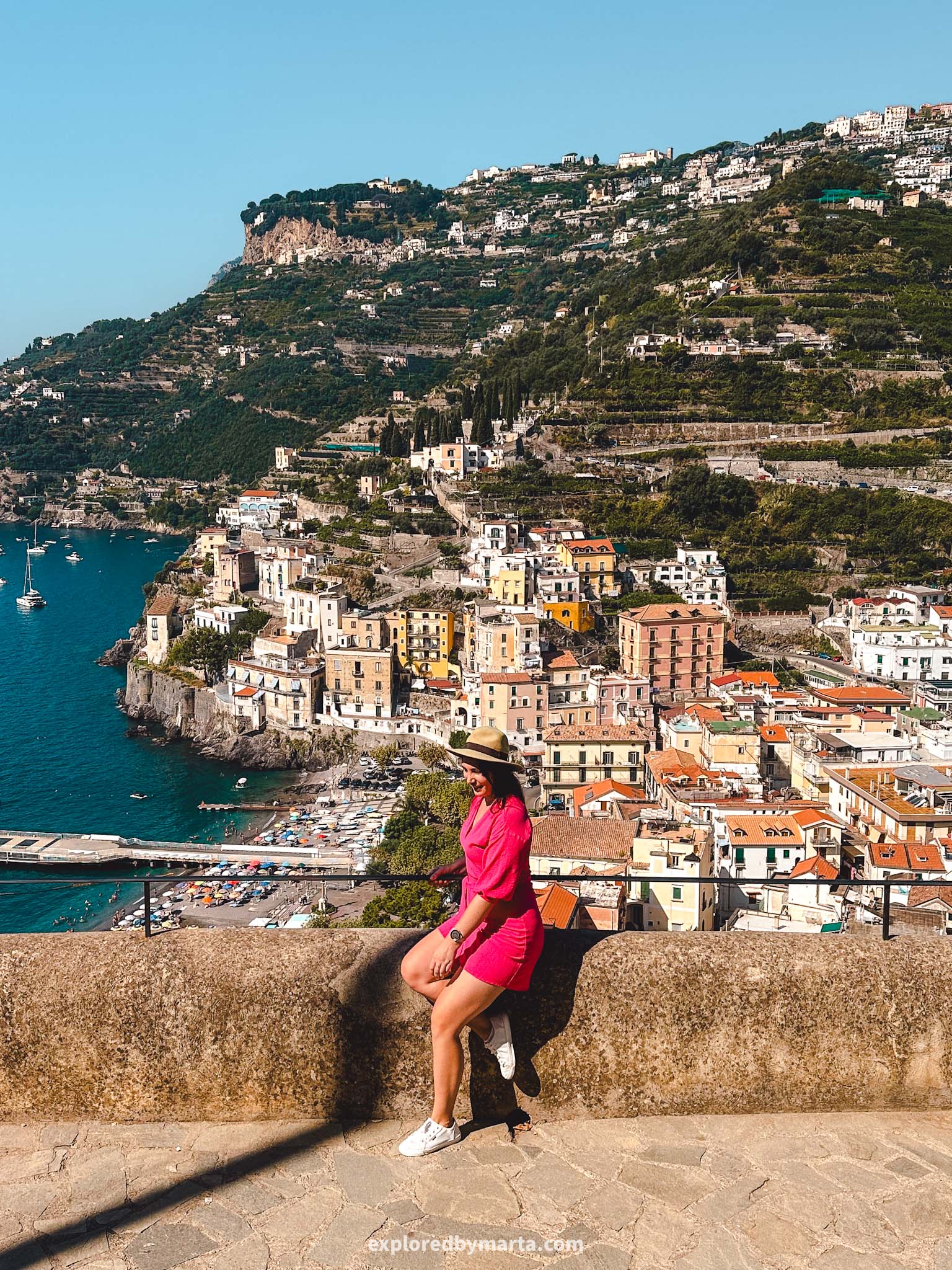
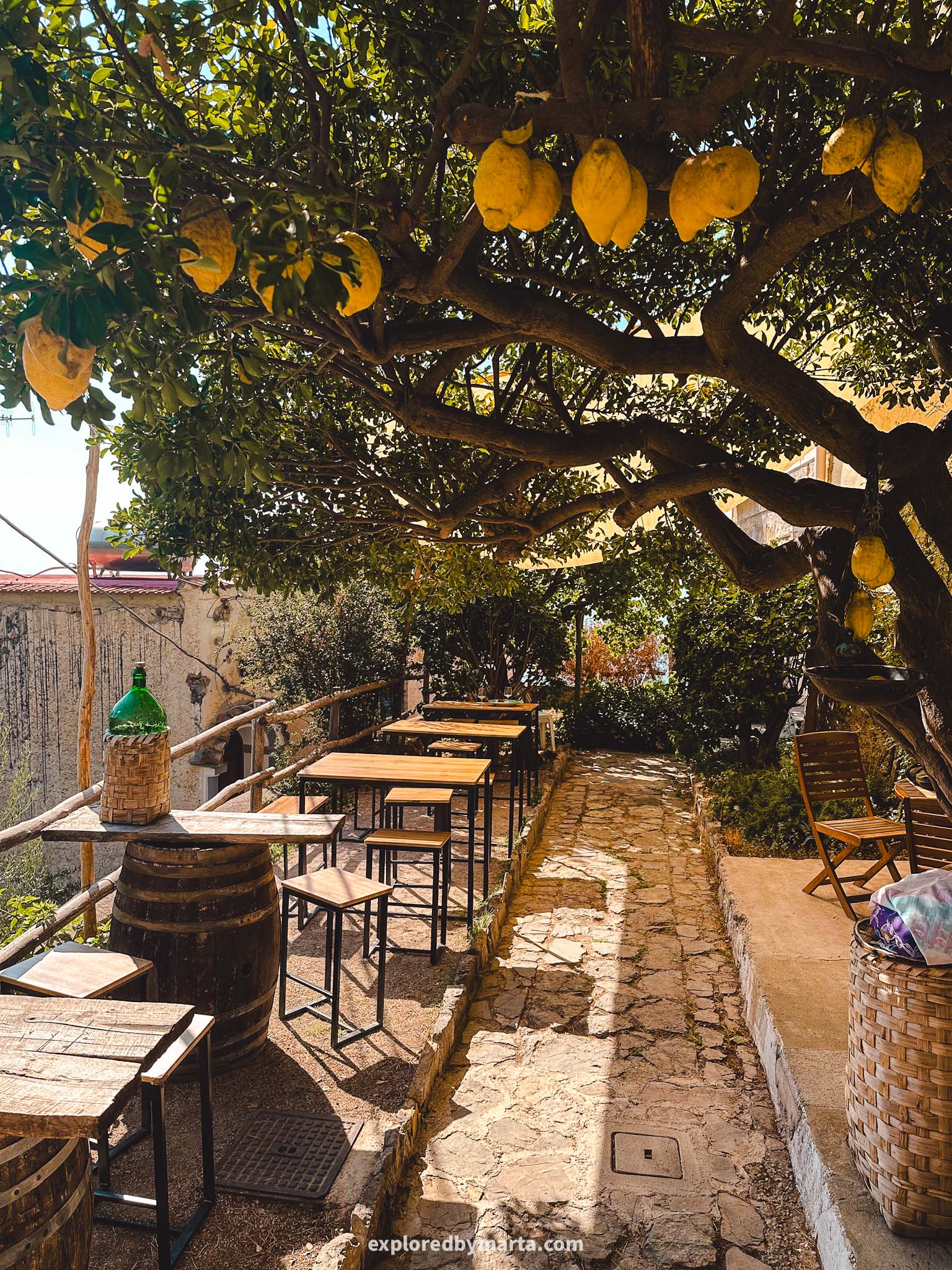
Historically, this path was created to transport lemons and other goods between the two twin towns. Even today, donkeys are used as a means of transportation along the path. And we saw them during our hike!
Around the midway point, there was a small lemon farm with a bar where they offered lemon granita and lemonade. We stopped here to sit down under the lemon trees to have a glass of each.
For those of you who love longer hikes, you don’t have to stop in Minori. Minori village is connected to Ravello by a steep staircase, so you can walk all the way up to Ravello if you want. However, you’ll have to manage some steep stairs to get there.
Location: Path of the Lemons
9. Villa Rufolo in Ravello


In case you actually end up in Ravello, there might be one more place worth checking out: Villa Rufolo!
Villa Rufolo is a vast 13th-century estate built by the wealthy Rufolo family, who were influential merchants in this area. Today, this estate is open to the public (for an entrance fee) and hosts different local events.
Villa Rufolo is one of the main sites for the famous Ravello Music Festival, which takes place every year during the summer months. Apart from that, it is known for its breathtaking postcard views of the Amalfi Coast!


We got to explore the vibrant terraced gardens with panoramic Amalfi Coast views, saw the cloister, and climbed the medieval Torre Maggiore tower. But there is one especially unique place in Villa Rufolo.
Located inside the gardens is a small viewpoint that overlooks an iconic view – the towers of the Church of Saint Mary of Grace, with an iconic pine tree and the scenic view of the Amalfi Coast in the background.
This is one of the most famous and recognizable postcard views of the Amalfi Coast. While I loved Villa Cimbrone more, this medieval villa truly was worth one hour of our time and should definitely be among the best places to visit on the Amalfi Coast!
Location: Villa Rufolo
10. Via Cristoforo Colombo in Positano
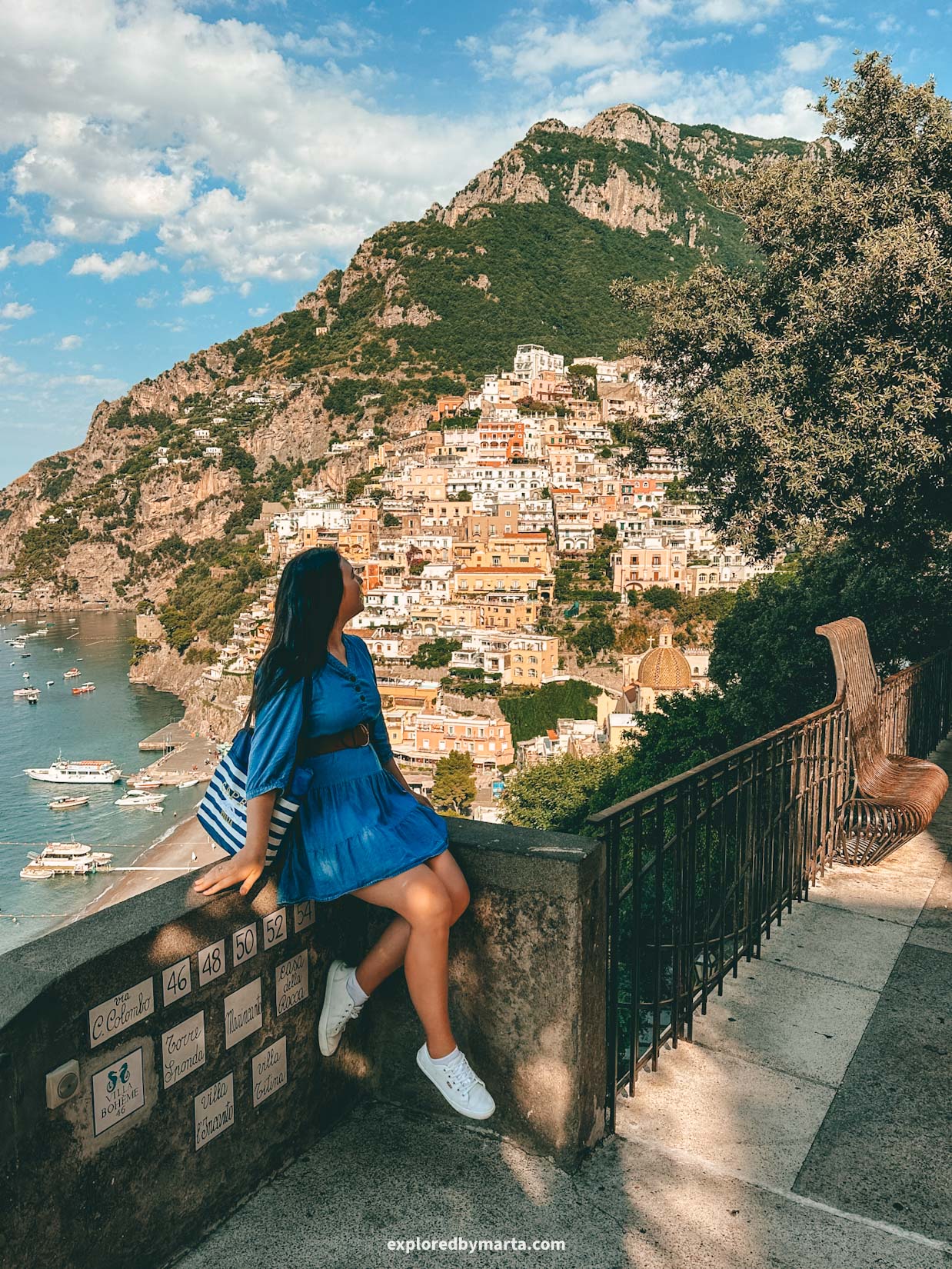
Positano is all about the views. With its colorful houses famously perched on a seaside cliff and stacked one on top of the other, this charming town attracts visitors from all over the world to its unique setting.
There’s no better way to truly soak in Positano’s beauty than finding a scenic restaurant or bar and enjoying a cocktail or lunch with breathtaking views of the town. However, you don’t necessarily have to pay for those views.
You just need to be fit enough to walk up to Via Cristoforo Colombo! Much of this cliffside street offers some of the best views of Positano, including that iconic photo spot you see above (exact GPS coordinates below).
And I have to say, this street was my favorite place in Positano! I loved admiring all this beauty away from the busy beachside and narrow streets packed with tourists down below, haha.
Location: Via Cristoforo Colombo
11. Pasticceria Sal De Riso in Minori


The famous pastry shop Pasticceria Sal De Riso in Minori has become a culinary landmark, and this is one of the top places to visit on the Amalfi Coast!
There are a couple of things that must be on your Amalfi Coast bucket list, and trying Delizia al Limone, Amalfi Coast’s famous dessert, should be one of them.
You will find this dessert in basically every restaurant along the coastline, as it is one of the must-try foods when visiting the Amalfi Coast.
So why come to Pasticceria Sal De Riso in Minori? Well, the pastry shop was created by one of Italy’s most celebrated chefs, Salvatore De Riso, who is actually a local and grew up in Minori.
And here’s the bombshell – he created this famous dessert!
Delizia al Limone or Lemon Delight is made of Limoncello-soaked sponge cake and lemon cream. It is soft, not too sweet, and very light – the perfect dessert with a cup of coffee in the morning!
Location: Pasticceria Sal De Riso
12. Ceramics Street in Vietri sul Mare
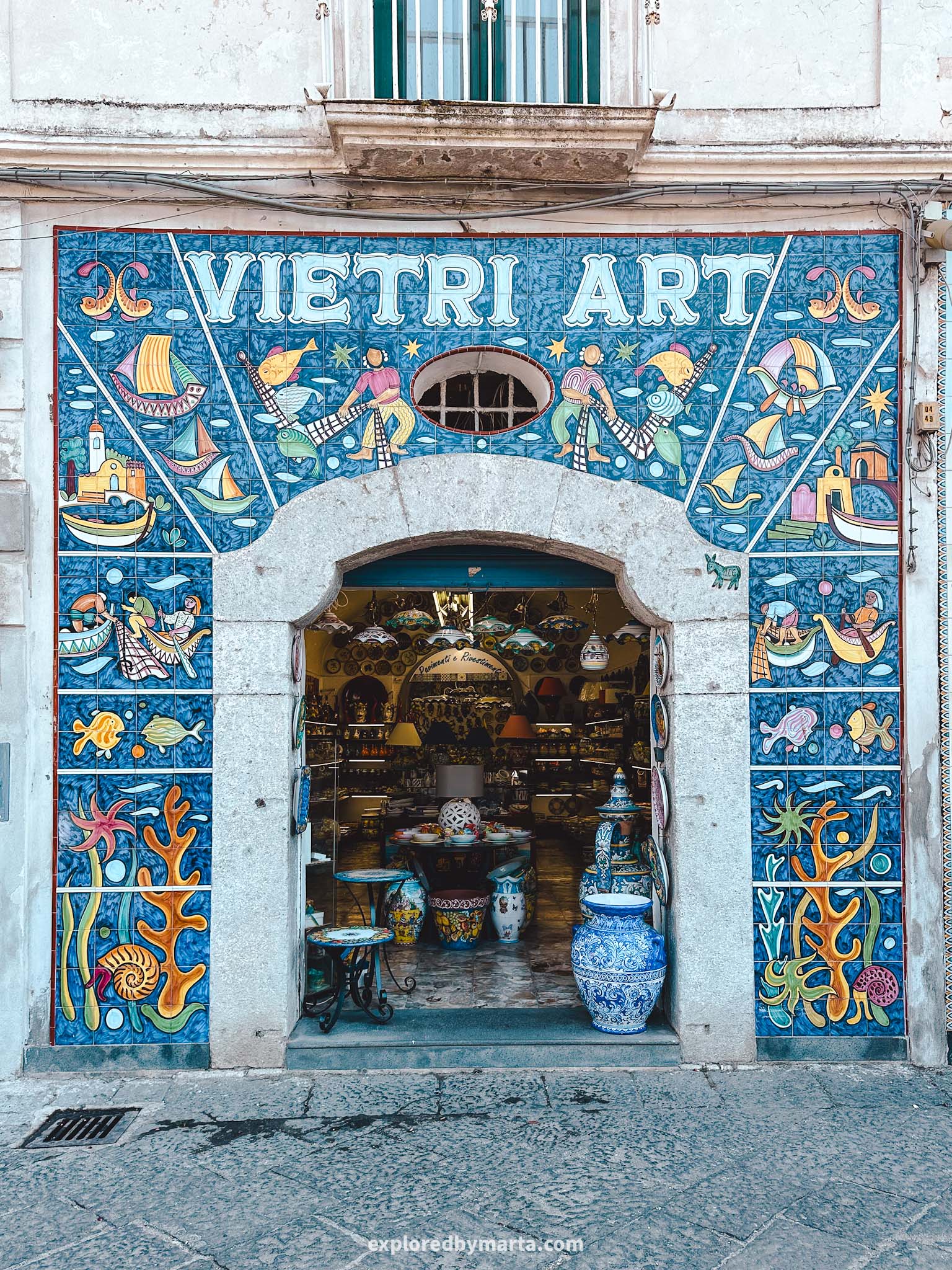
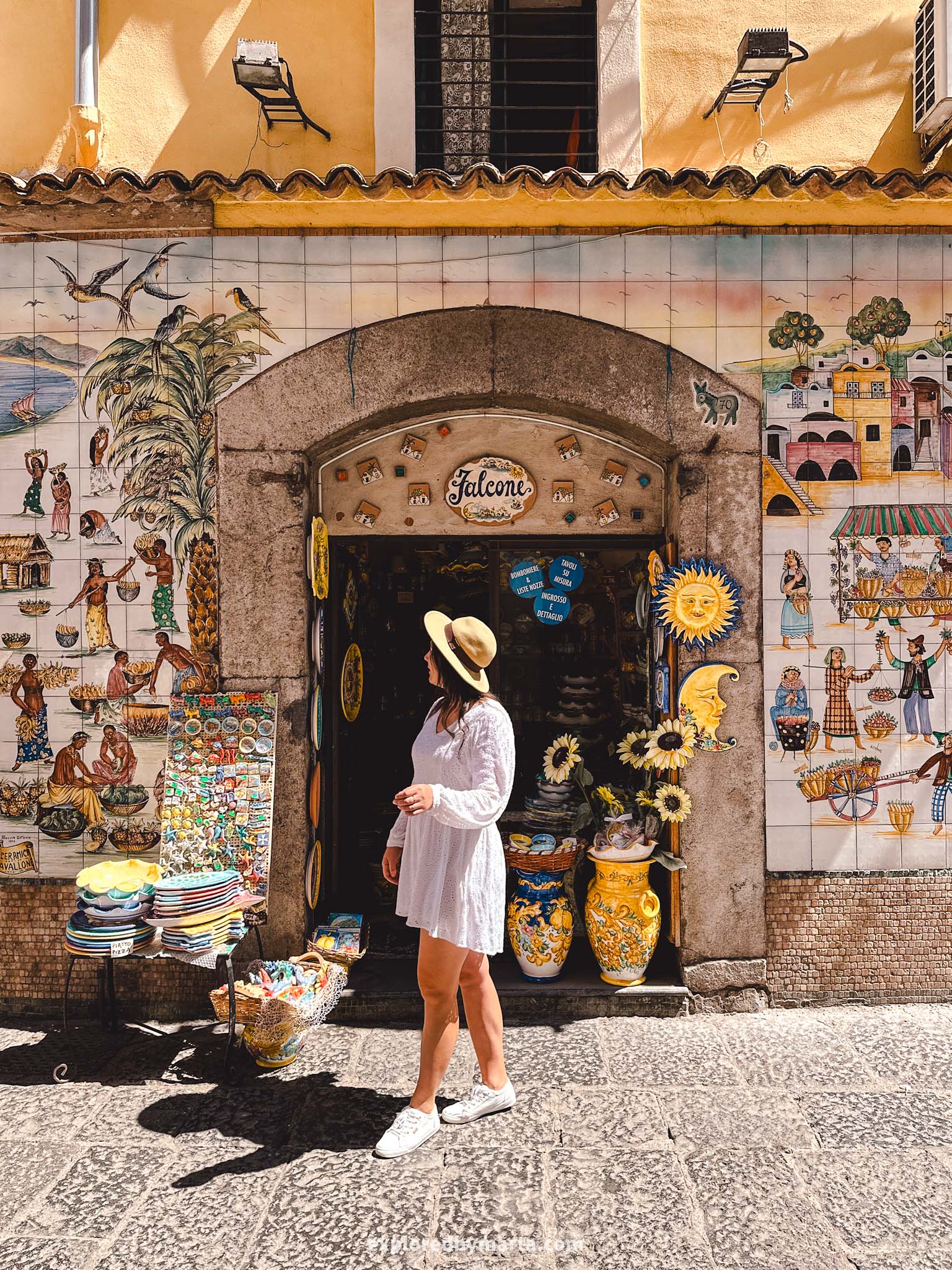
Every traveler to the Amalfi Coast knows (or at some point realizes) that buying local handmade ceramics is one of the bucket list things to do on the Amalfi Coast.
But only a few of them know this special spot along the coastline – Vietri sul Mare, for centuries known as the capital of ceramics production on the Amalfi Coast.
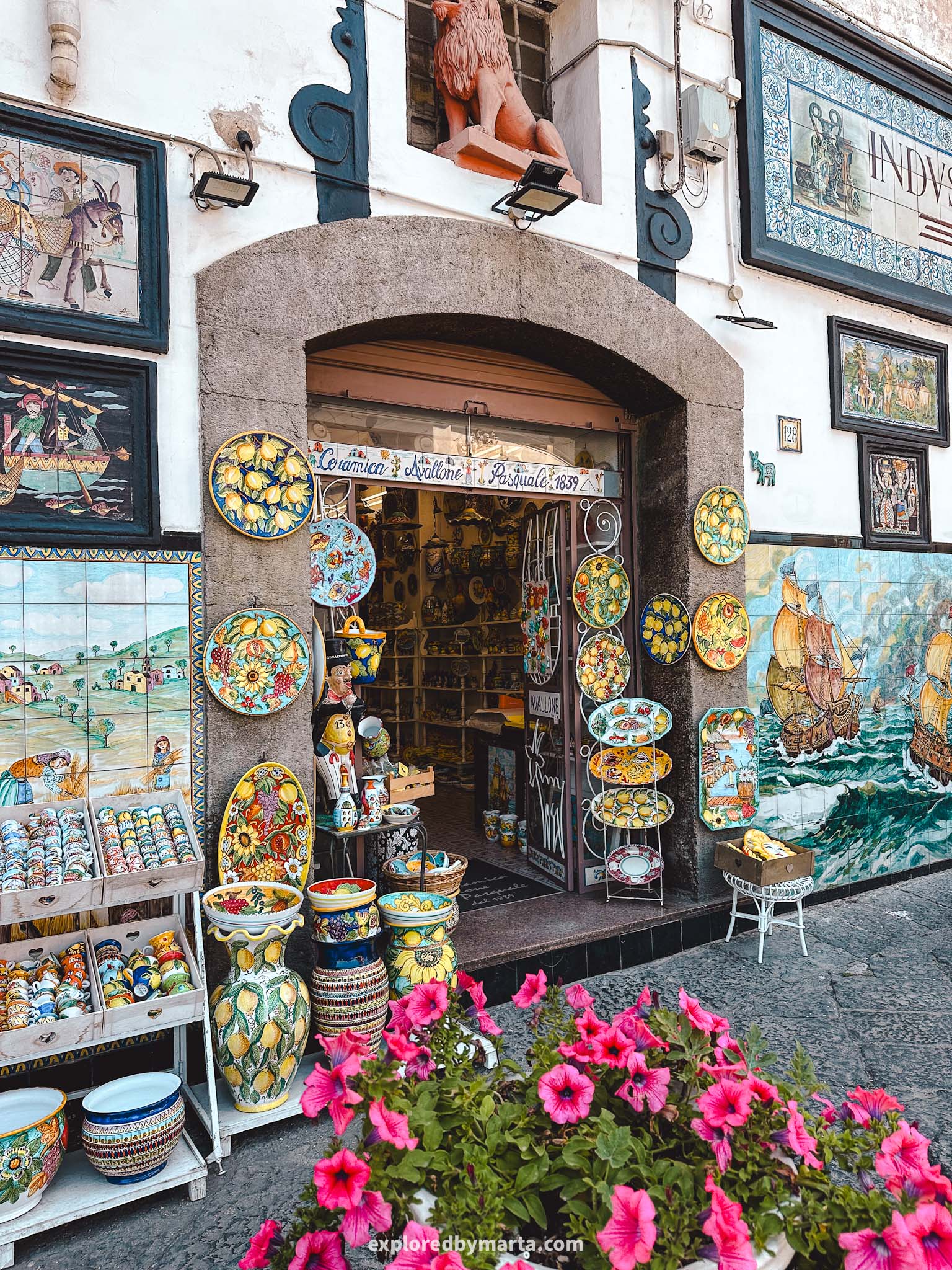
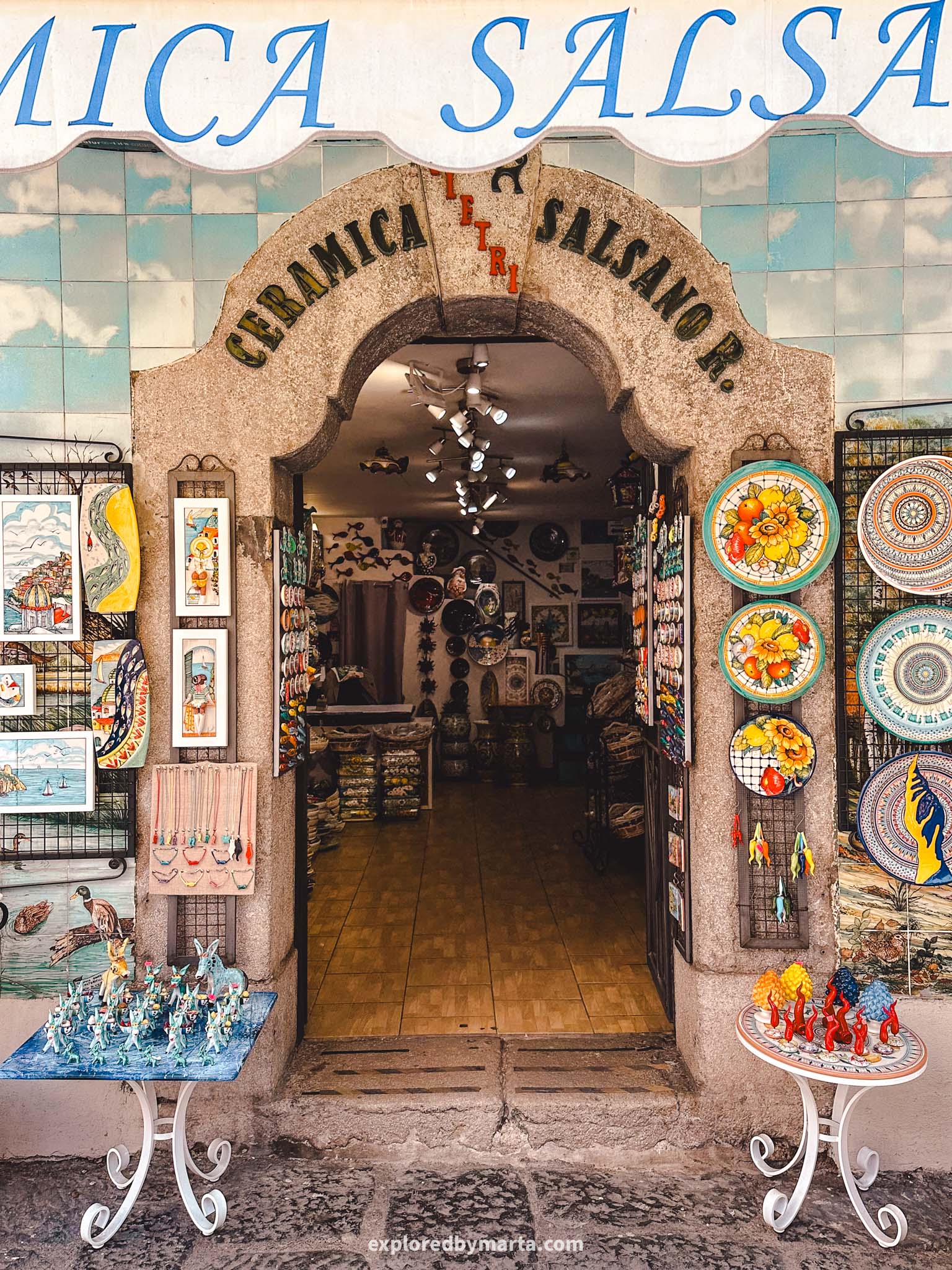
Most travelers to the Amalfi Coast only spend 3 to 7 days here and visit only the famous locations like Amalfi, Positano, and Ravello, so, despite its status as the capital of ceramics production, Vietri sul Mare has long remained under the radar.
I have visited basically every village along the Amalfi Coast, and I know very well that you can buy ceramics everywhere. However, nothing can compare with Vietri sul Mare, and I hope you have the time and the ability to visit and explore this village.
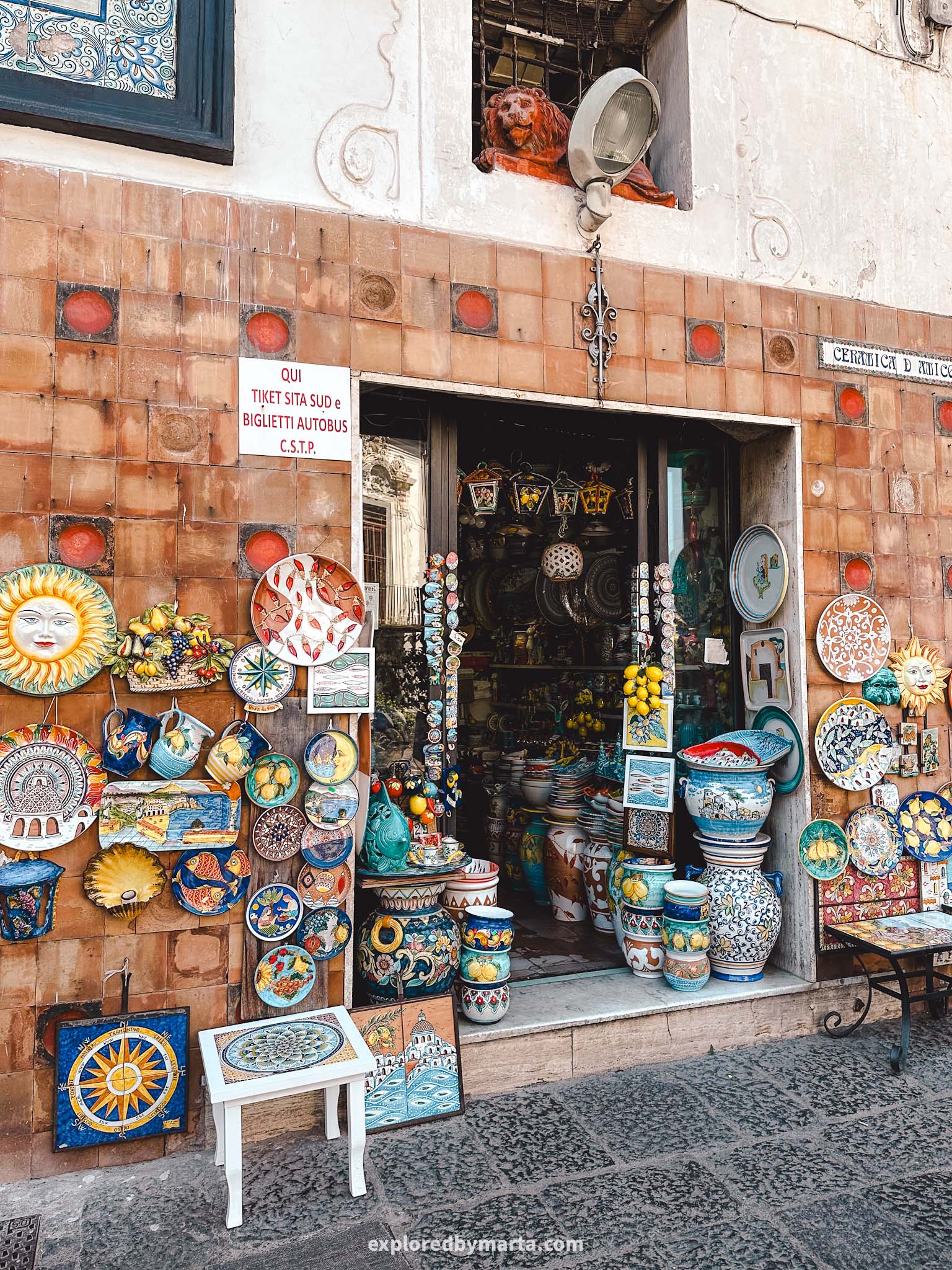
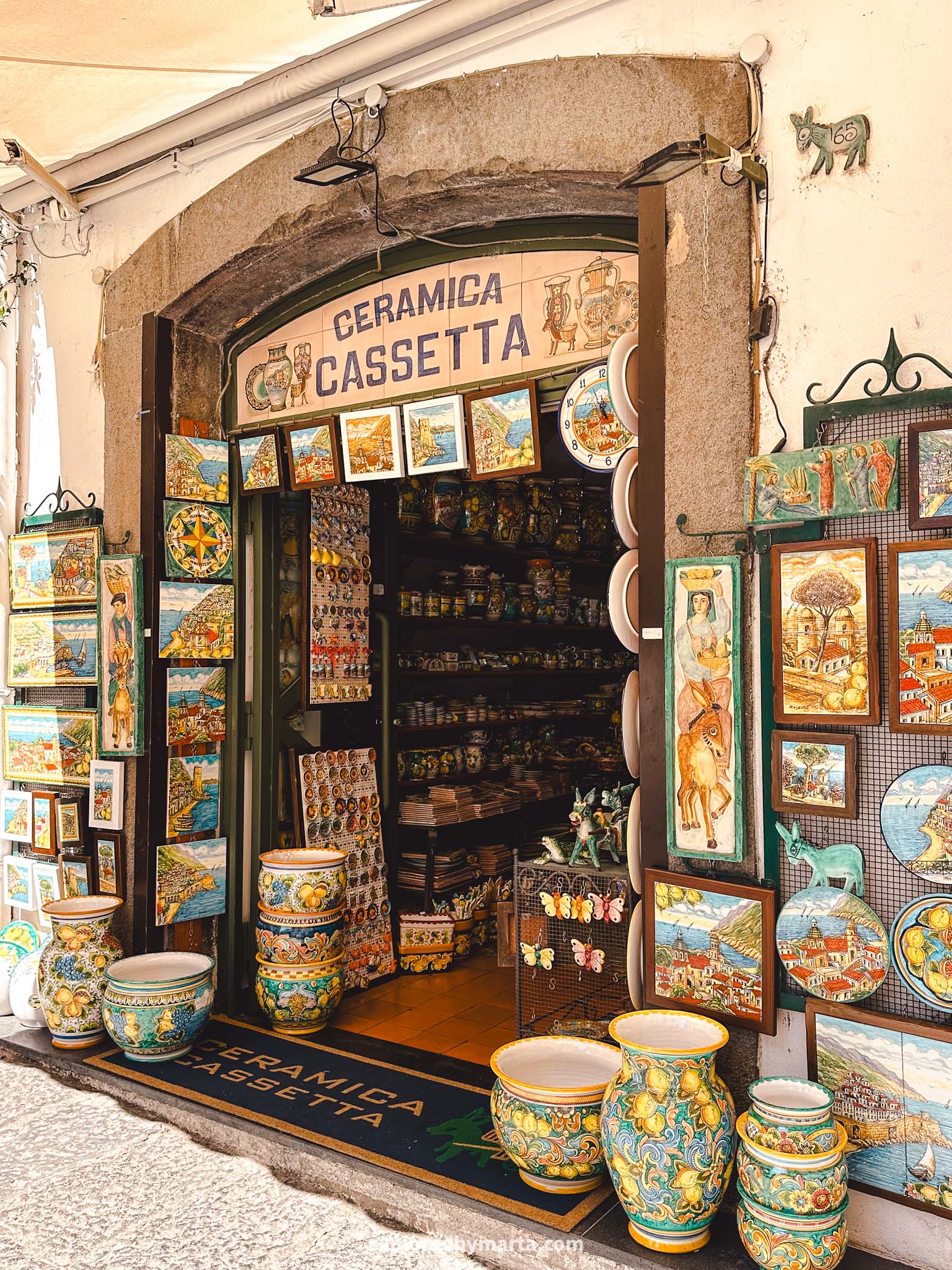
If you only do one thing in Vietri sul Mare, it has to be strolling along Corso Umberto I, the main ceramics street in the village, filled with countless independent manufacturers’ ceramic shops. I couldn’t even count all of them – there are so many of them!
I noticed that all of them had the most beautiful shop entrances! Like, how stunning are they? These stores are adorned with painted ceramic tiles, pots, plates, flowers, and other ceramic design elements, making the whole street a joyful spectacle.
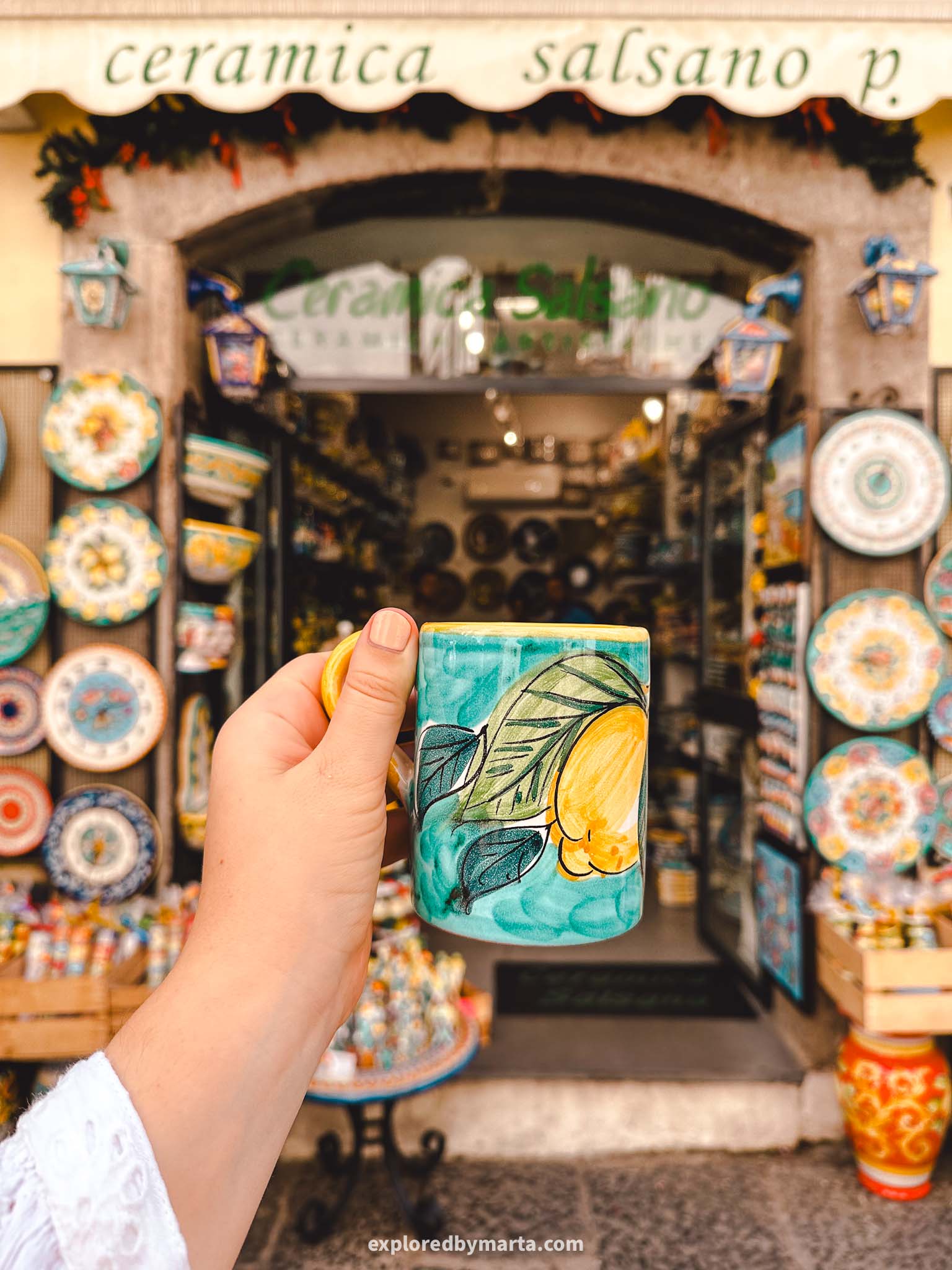
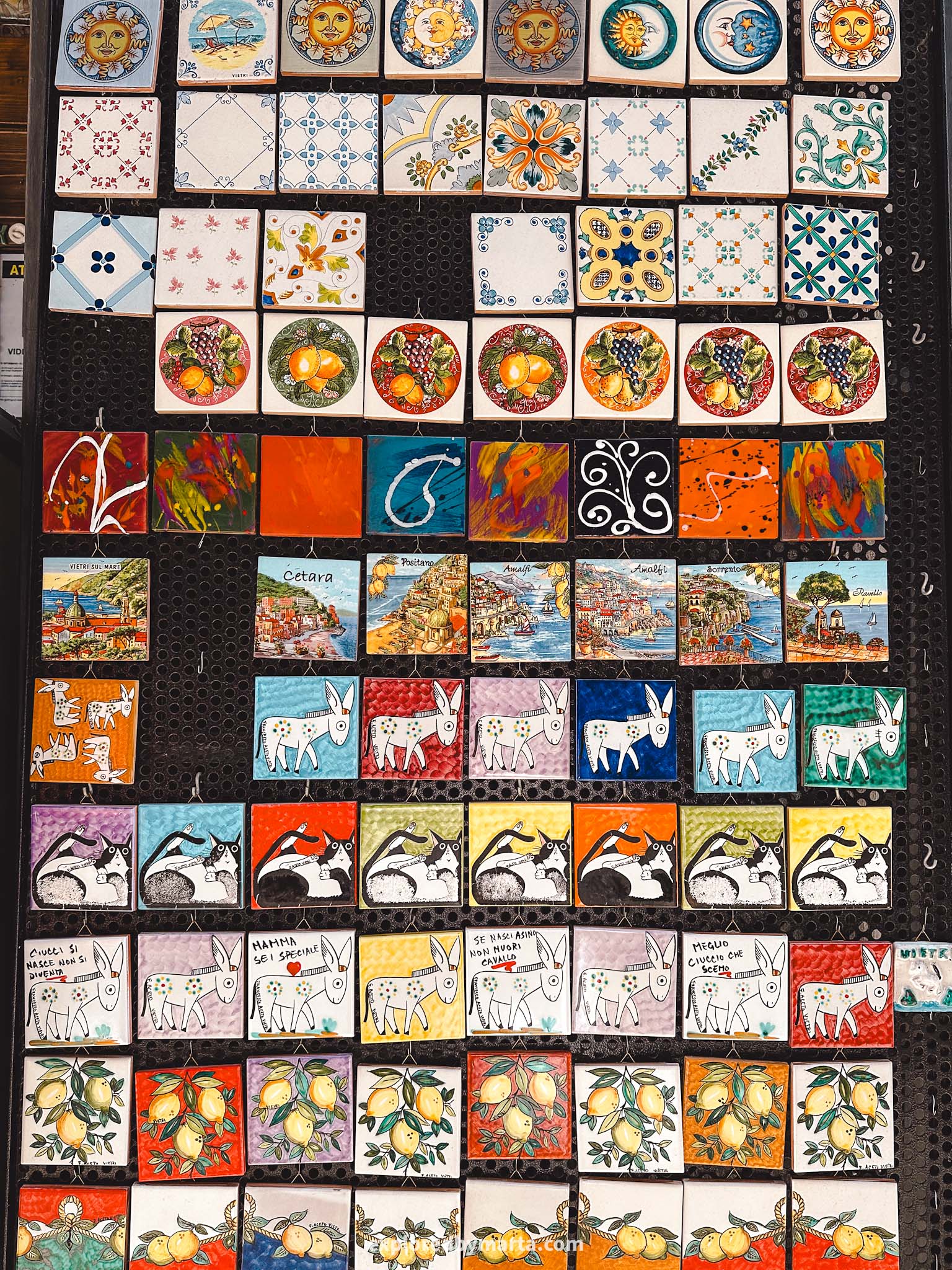
Not only shop entrances, but entire walls around the doors and some houses in the village are all adorned with these beautiful ceramics. This street is one of my favorite hidden gems on the Amalfi Coast!
Here they sell everything from Christmas ornaments to every possible kitchen item – all made of ceramics. Of course, the most popular items are mugs, plates, and bowls. I hope you won’t only take pictures, but also buy something!
The Corso Umberto I street is not long, so I highly recommend walking all the way from one end to the other. We walked the street there and back. The first time we checked everything out, and the second time we bought some goodies to take home. I got a lemon mug!
Location: Corso Umberto I
13. Traditional limoncello factory in Amalfi


Limoncello is a traditional Italian lemon liqueur that originated in the area of the Amalfi Coast and the Sorrento Peninsula. If there are any foods and drinks you should try when visiting the Amalfi Coast, then limoncello is definitely one of them!
Limoncello was created by the monks who used it for medicinal purposes, but later people started making it at home (and still do!), and mostly used it to help with digestion after meals. Some restaurants will serve it to you for free!
The best place to go for anything related to limoncello is Antichi Sapori d’Amalfi in the heart of Amalfi town, just a few steps from the main square.
Antichi Sapori d’Amalfi is a small shop as well as a small limoncello factory belonging to a family for many generations. Of course, you can simply go there to shop for local products and everything lemon (soap, cosmetics, sweets, etc.), including all types of limoncello.

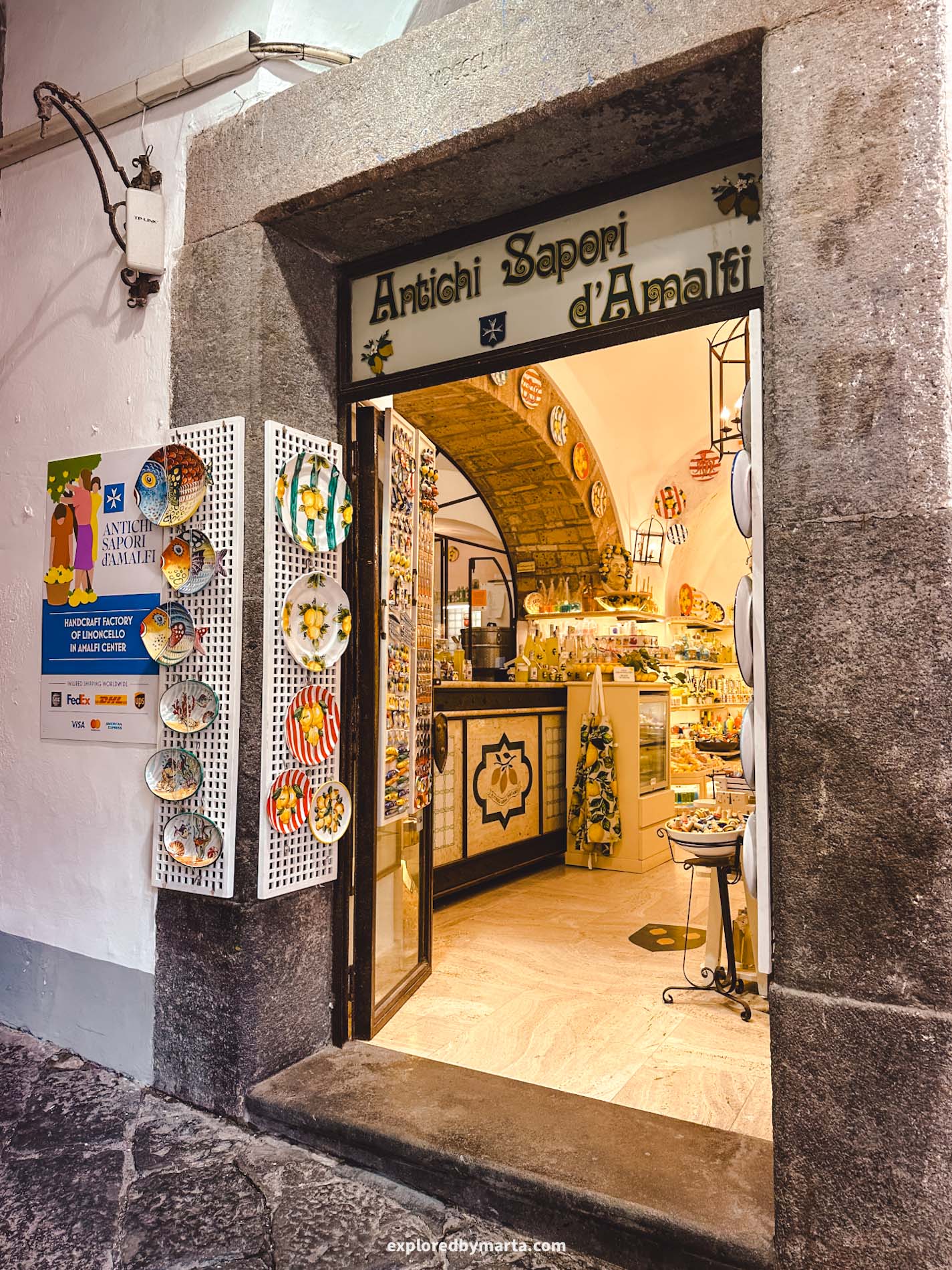
But you can also join guided limoncello tours (this is the exact one we did!) and find out everything about this iconic drink.
I am not into strong drinks and wasn’t sure I even wanted to visit this place in Amalfi; however, I was interested to find out how the limoncello was made, especially the traditional way of making it.
We got to see how it was made, how the lemons were peeled, how they marinated in massive glass jars for two weeks, and we got to taste different kinds of liqueur – including mango, strawberry, and even pistachio!
We ended up buying small limoncello bottles for our family back home. You only need to drink a tiny amount, so it’ll last a while. I absolutely loved this tour – it was one of my favorite things to do in Amalfi town!
Location: Antichi Sapori d’Amalfi – Guided tour with limoncello tasting (the one we did!)
14. Maiori Beach, the longest beach on the Amalfi Coast
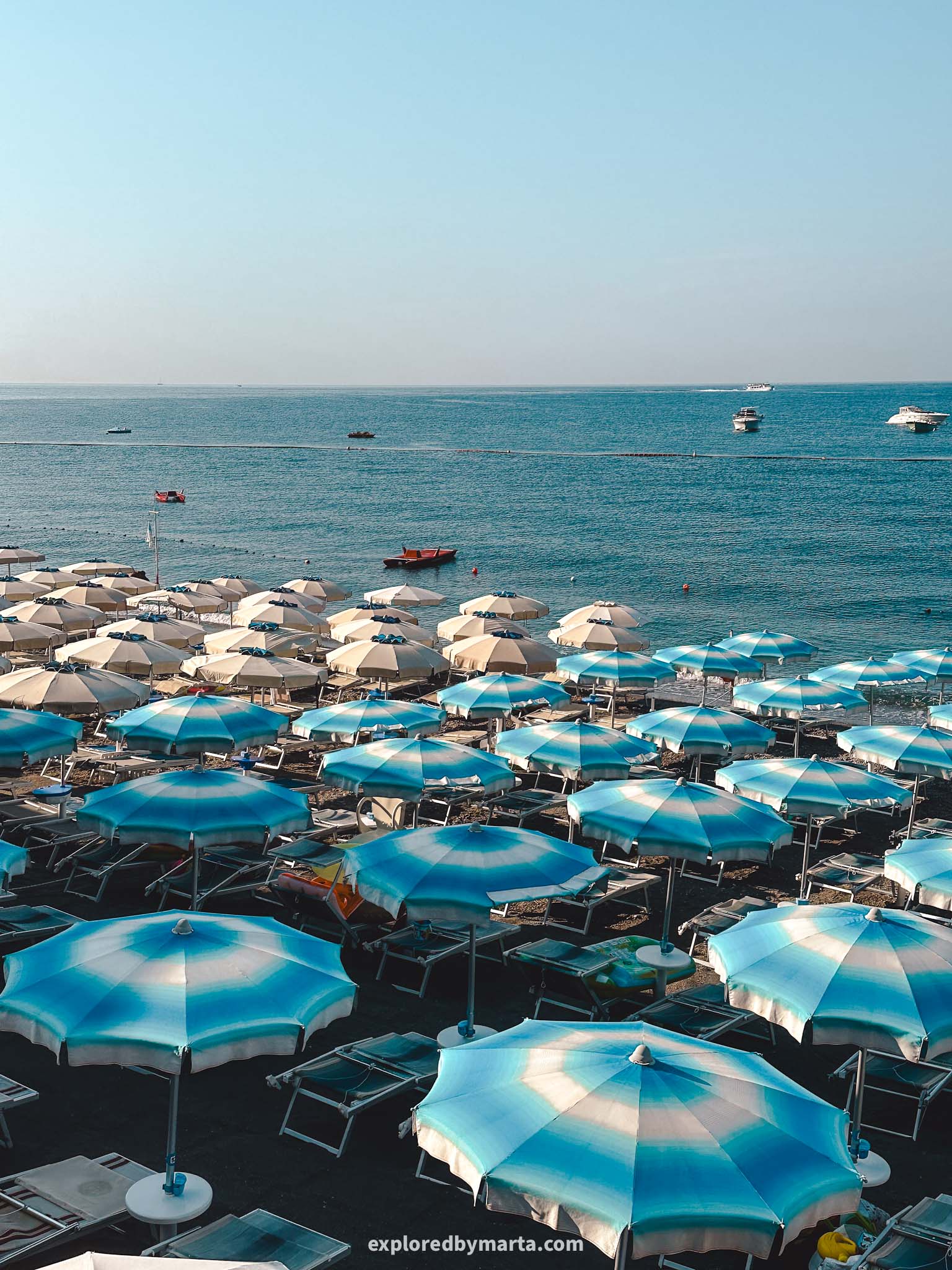
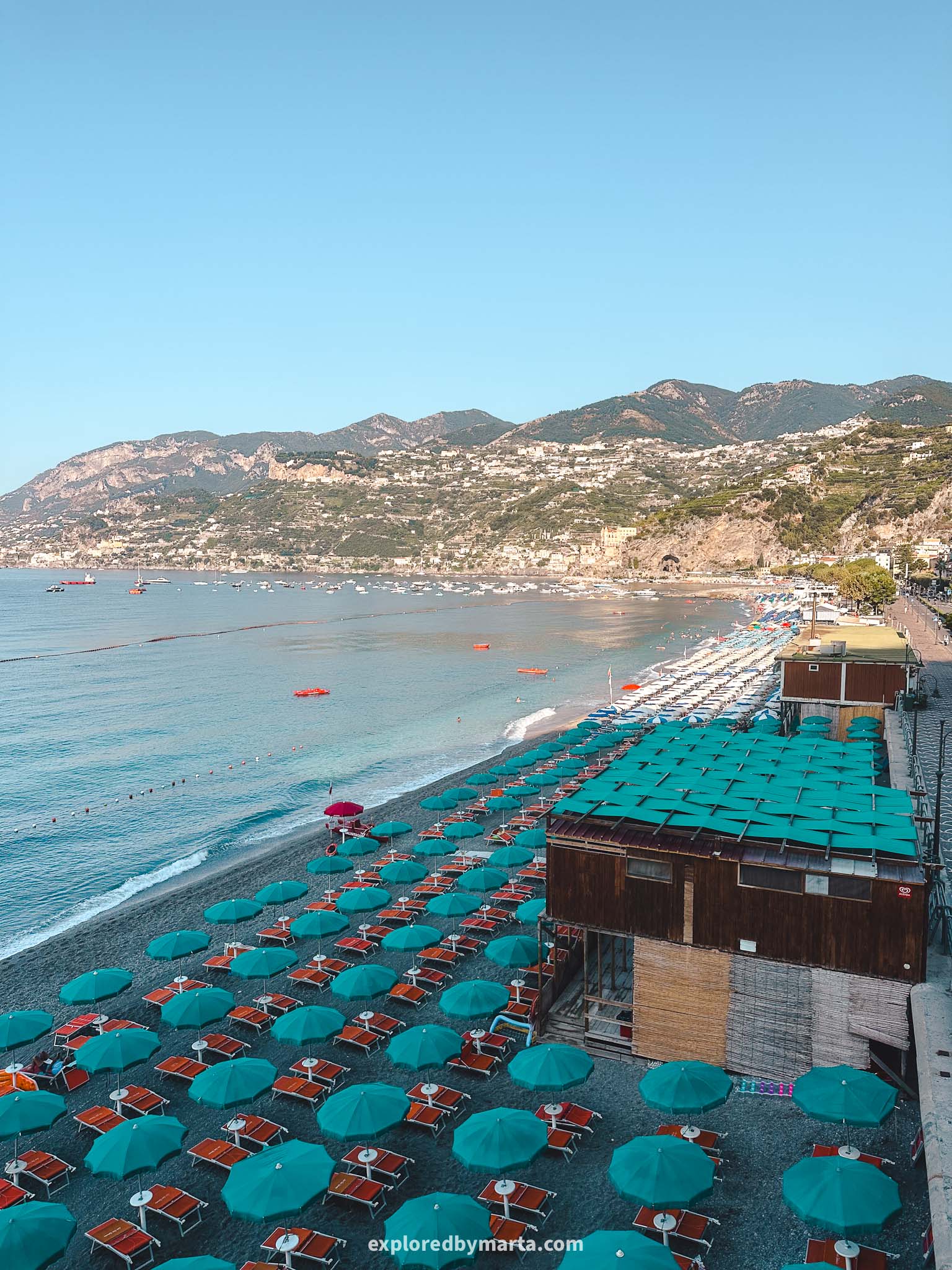
Maiori Beach, along with its seaside promenade or lungomare, as they say in Italy, is the pride and joy of Maiori. Out of all the towns along the Amalfi Coast, Maiori has the largest beach and the longest beachside promenade.
Due to its size, Maiori is often favored by travelers as the place to settle down during their travels around the Amalfi Coast. And having a nice beach is an added bonus for Maiori! It is the main attraction of Maiori!
I love seaside promenades. They are my favorite places where I love to go to relax and spend time outside. Lungomare di Maiori has the perfect length for an easy walk in the morning or a leisurely afternoon stroll.
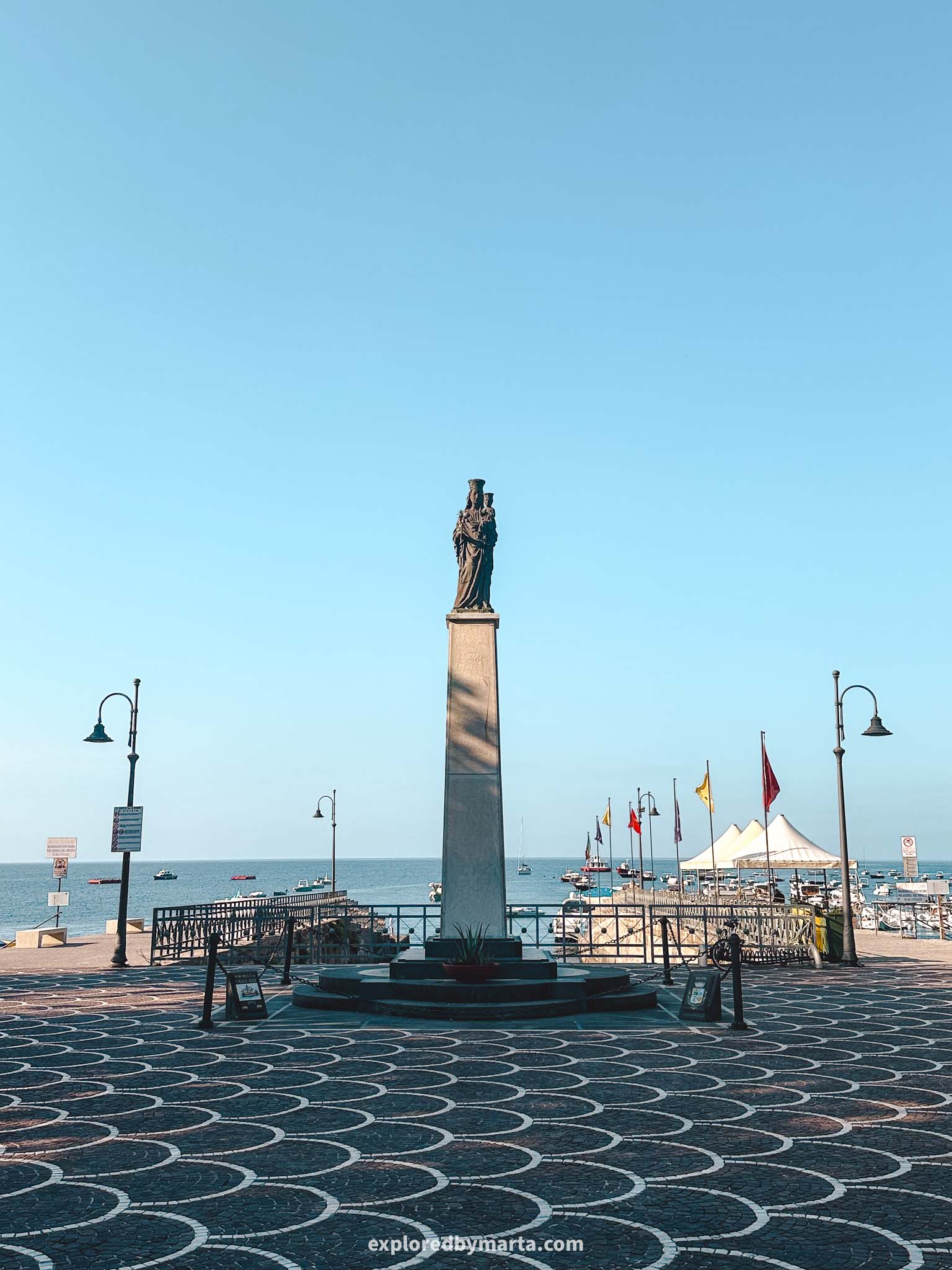
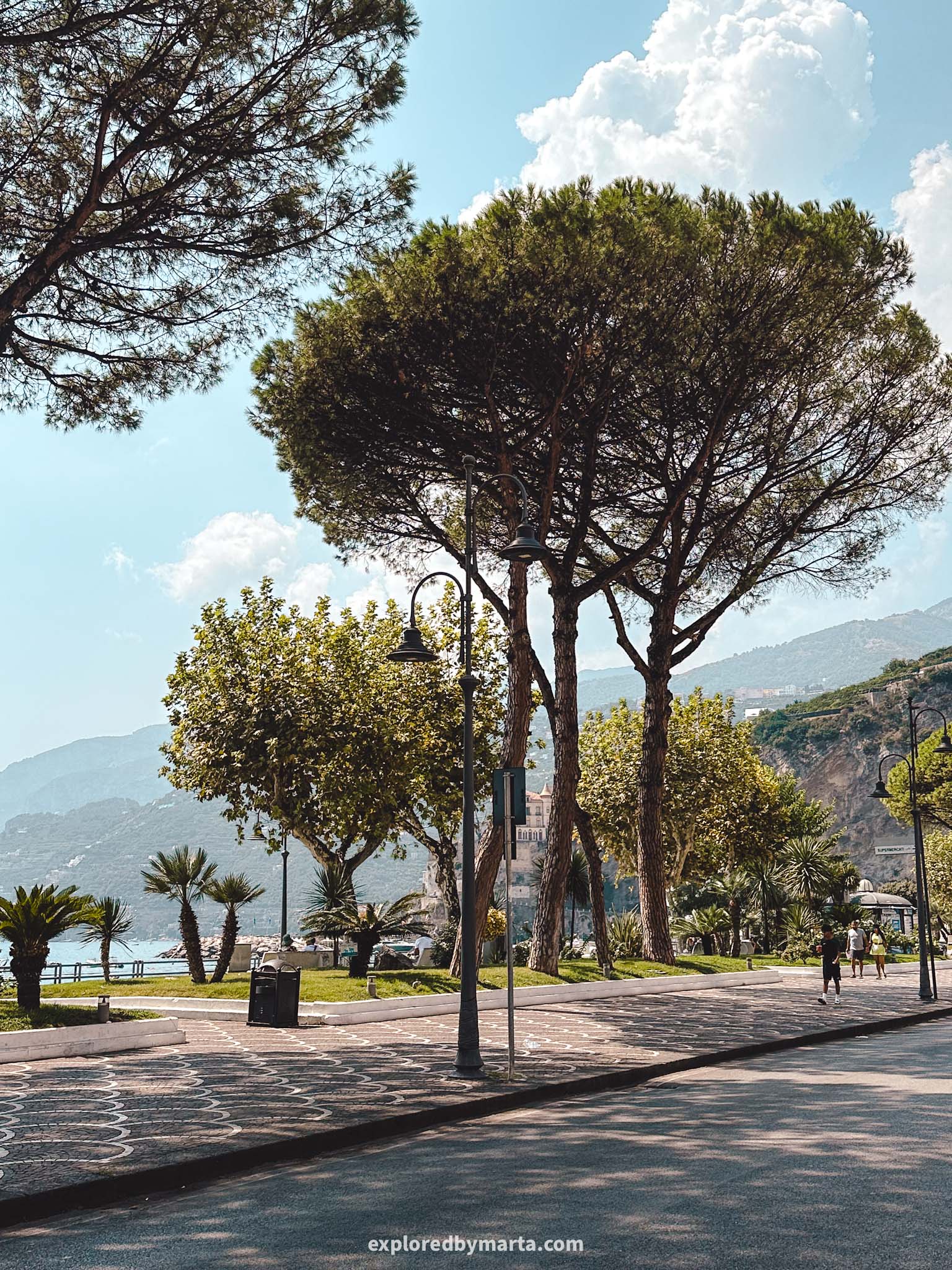
The beachside features some beach clubs, cafes, and restaurants, as well as benches under trees, and play areas for kids. It is THE place to go to watch people do their day-to-day things.
As for the beach, Maiori Beach is divided into two parts, just like every town along the Amalfi Coast. One part is accessible for free, but the other part is dotted with umbrellas and beach beds that you can rent out for the day.
We came here numerous times during our stay. For a while, we lived uphill from Maiori and used to drive down for a morning jog along the beach. Maiori Beach was definitely one of my favorite places to visit on the Amalfi Coast.
Location: Maiori Beach – Lungomare di Maiori
15. Capri Island
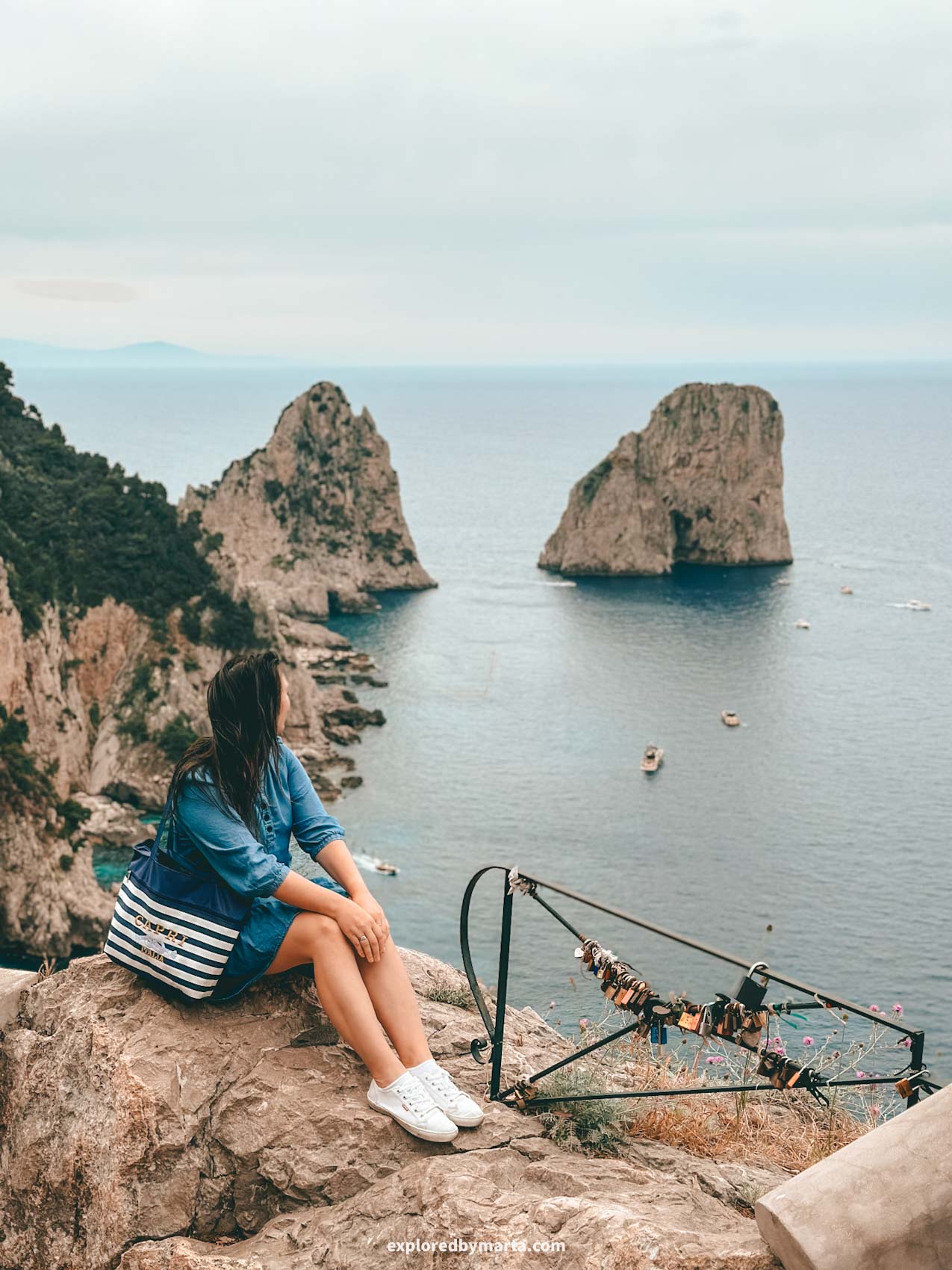
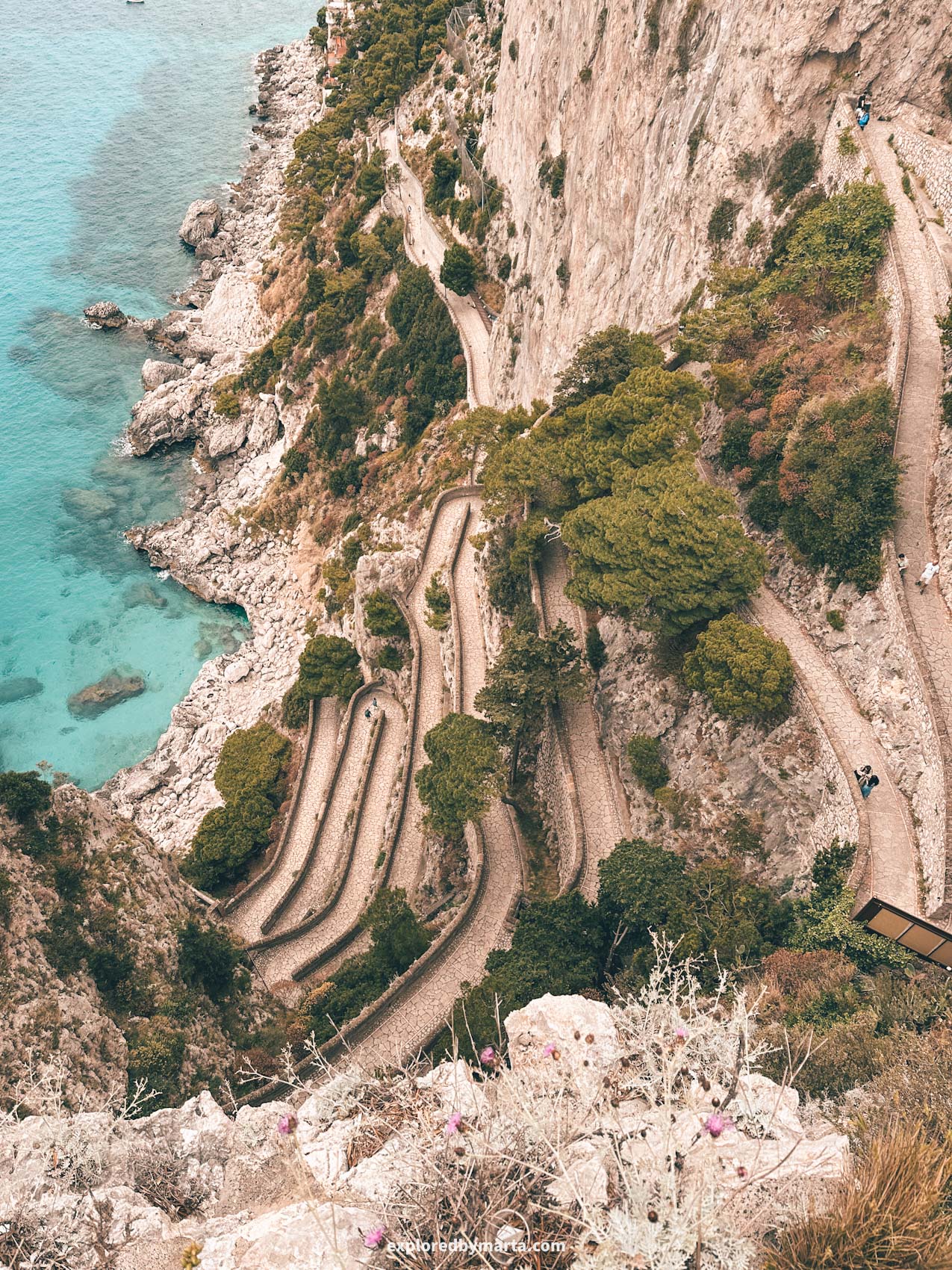
Capri Island is one of the most beautiful places in Italy, and a visit to the Amalfi Coast wouldn’t be complete without a day trip to the iconic Capri.
You can reach Capri from many places in this region, including from Naples, from Amalfi, from Maiori, from Salerno, as well as from Castellammare di Stabia, and, of course, Sorrento, which is actually the closest port to Capri. You can see the island from the shore!
So, because you will be so close, a trip to the wonderful Capri is a must!
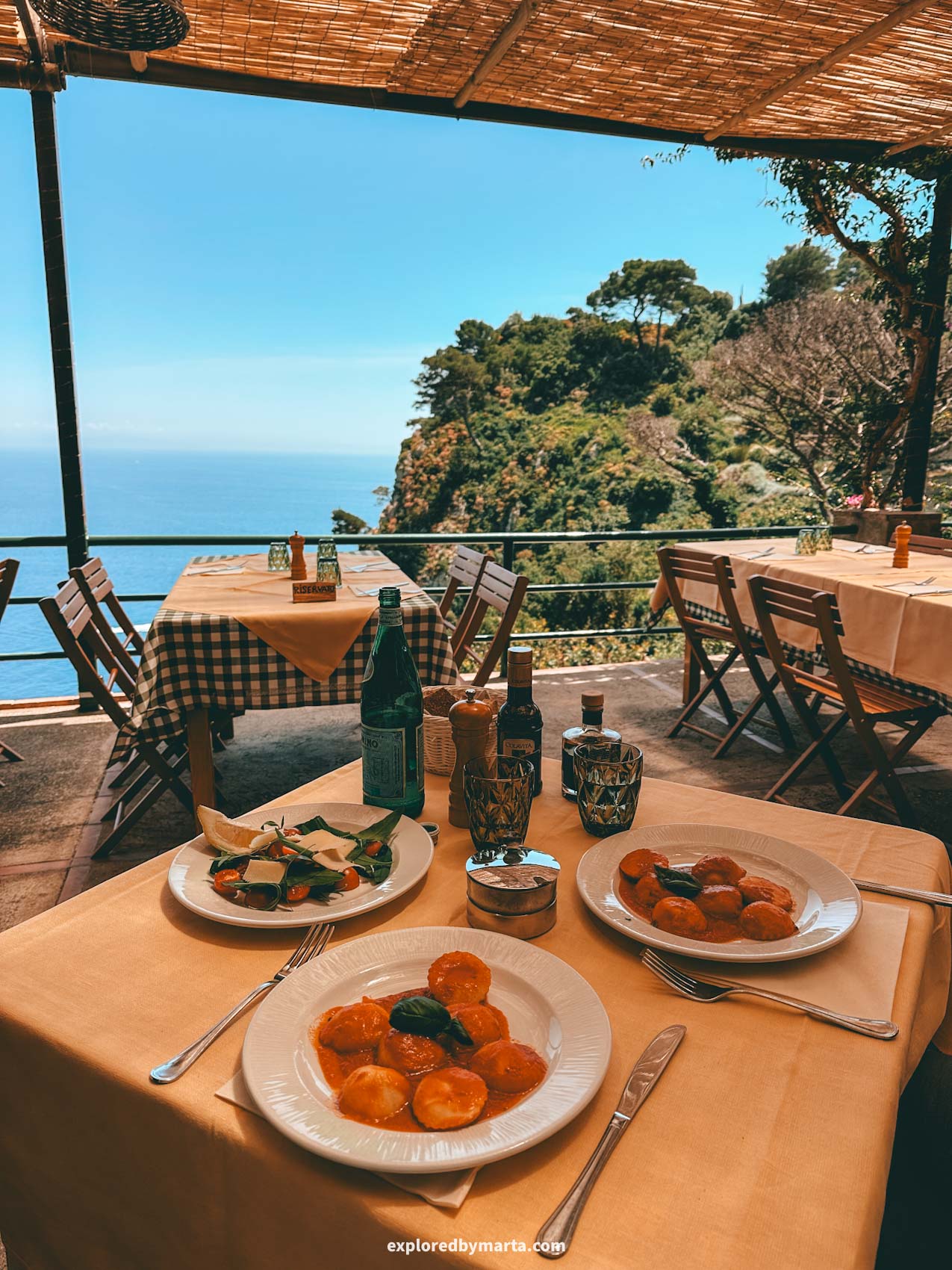
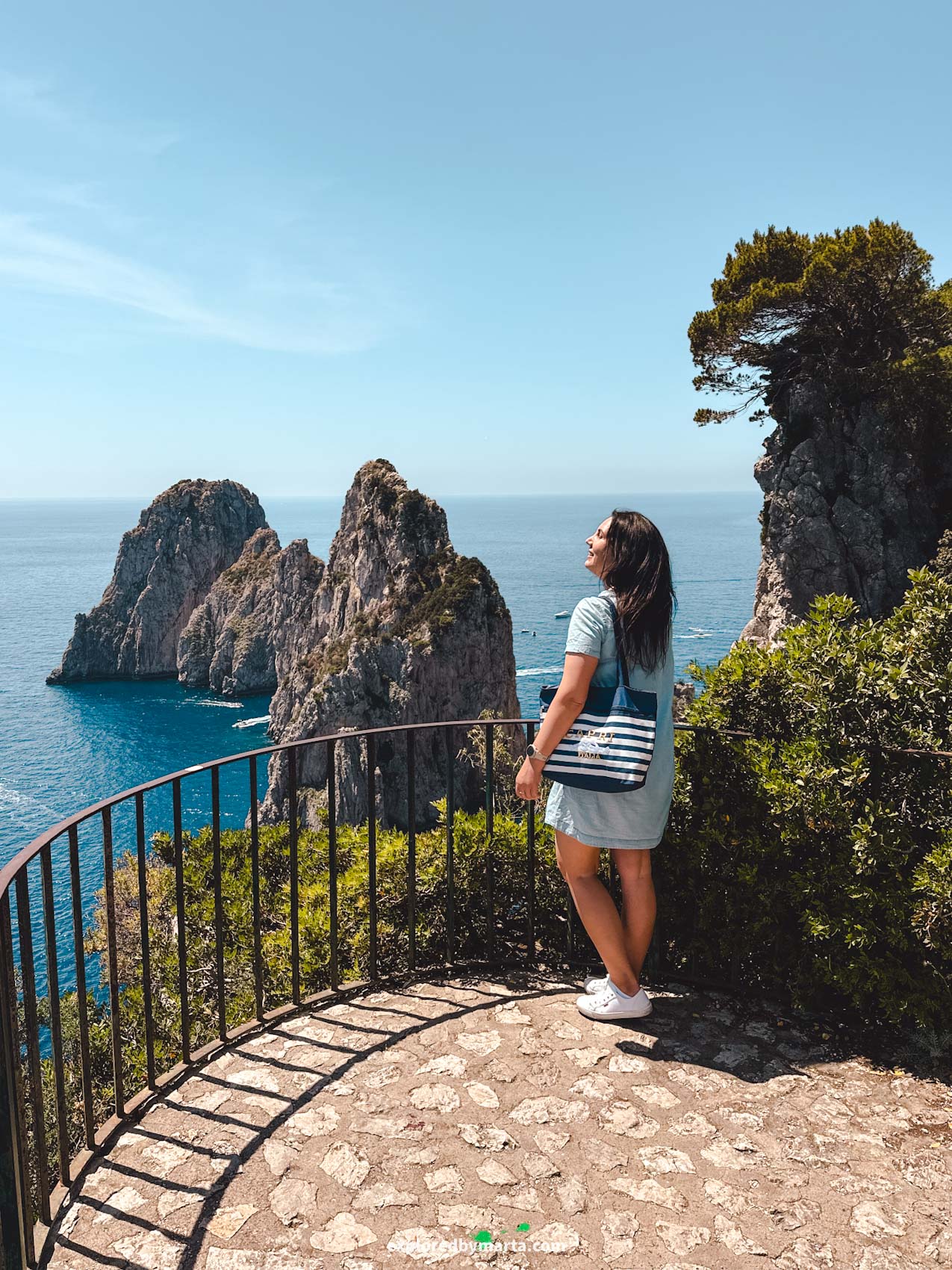
Known for its world-famous 350-feet-high (100-meter-high) Faraglioni di Capri sea stacks, Blue Grotto sea cave, and, of course, the popular Caprese salad, this island has long been a favorite for the rich and famous as well as regular travelers alike.
We actually spent a couple of days in Capri (including our honeymoon!) trying to soak in everything this beautiful place had to offer.
And those were some of our favorite memories from our trip to this part of Southern Italy. I see why people love this island so much! I’d love to return there one day!
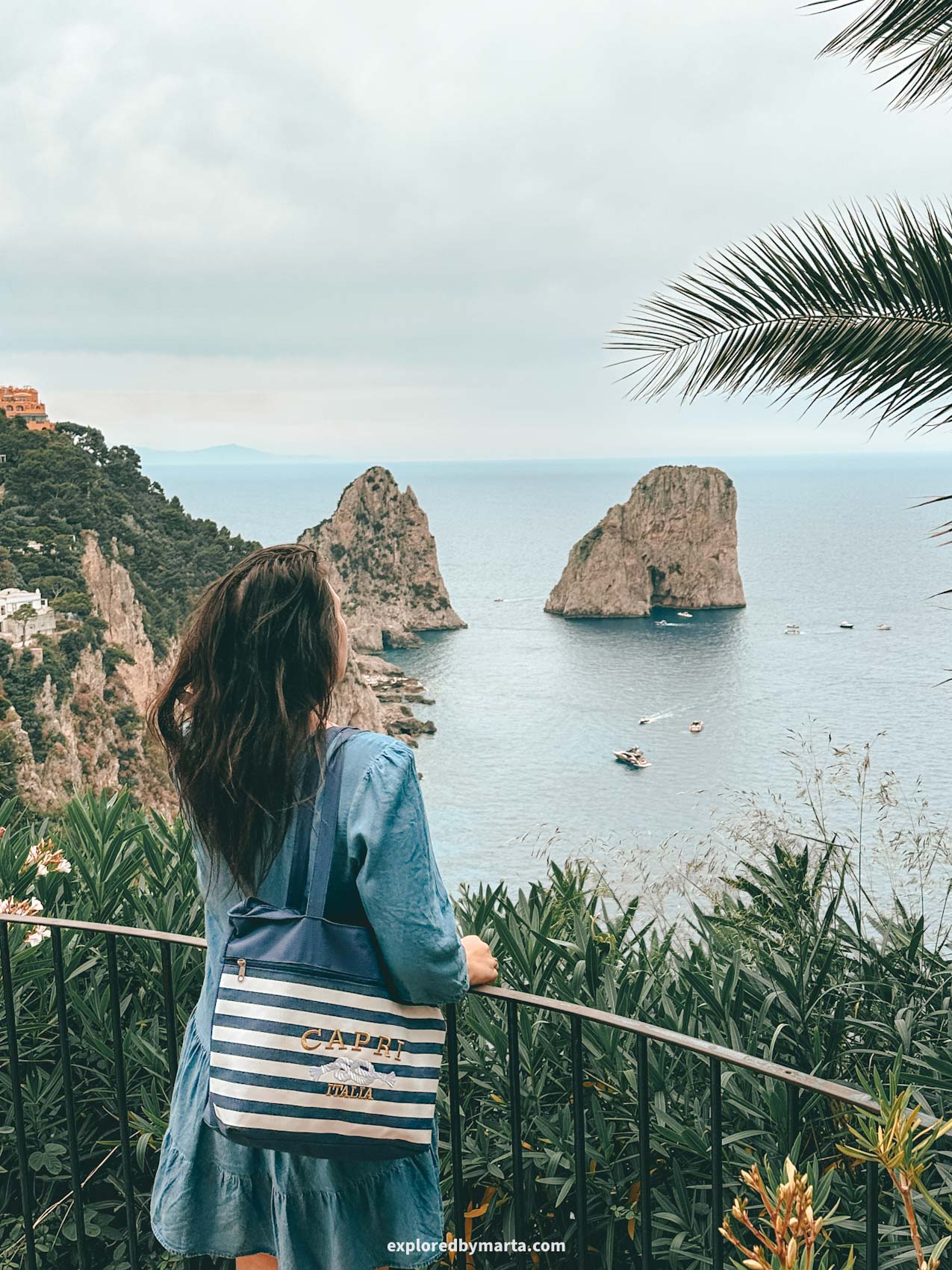
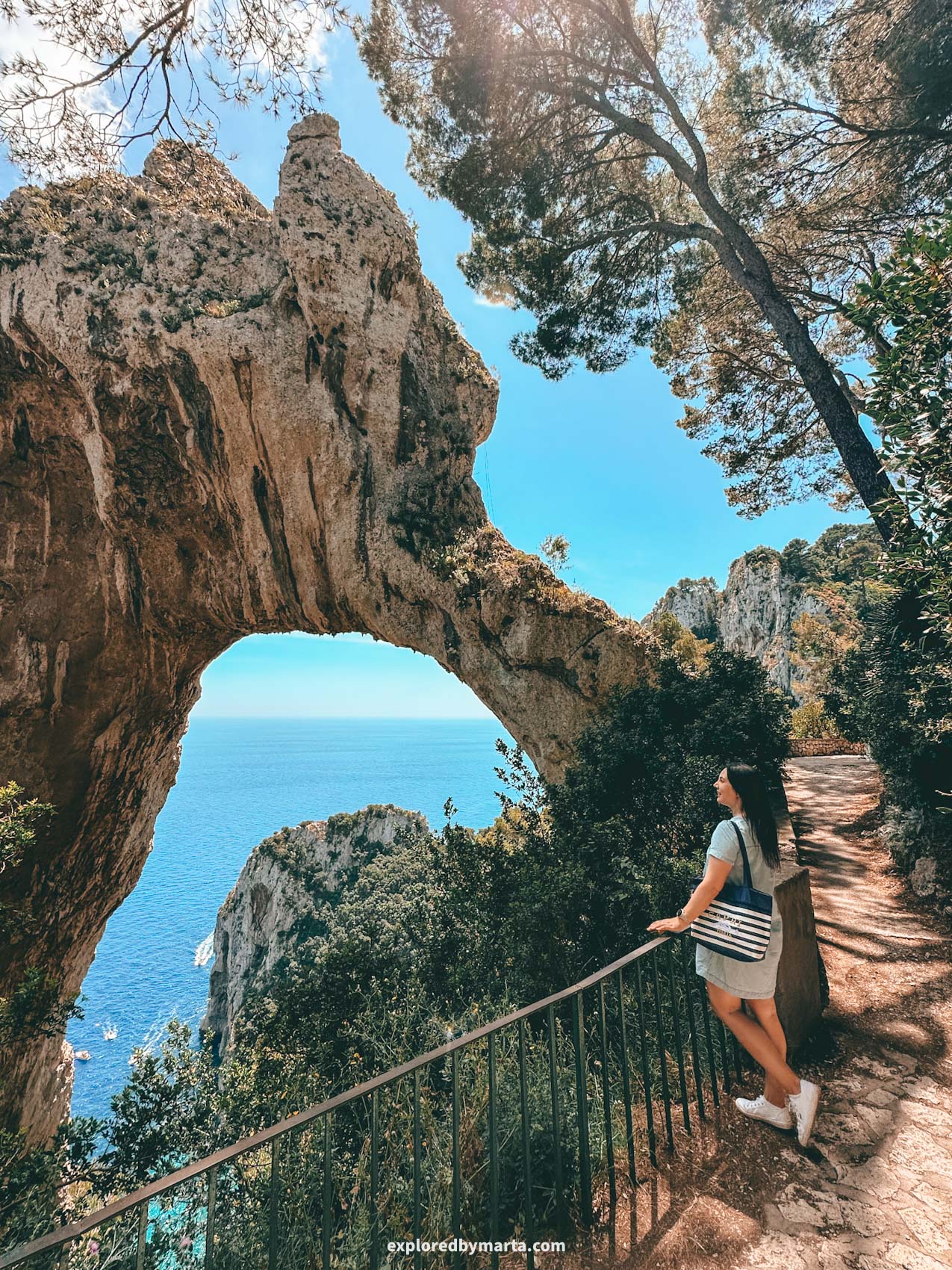
If you can, I recommend spending the night on the island.
Most of the island’s visitors are daytrippers, so those quiet evenings after all the ferries have left, as well as the tranquil mornings before they arrive, were quite magical! The island was suddenly so empty and peaceful!
Yes, those mid-day crowds CAN be a bit off-putting, but if you wander away from the busy squares, you’ll find the island’s tranquil beauty! We certainly did when we did the scenic Pizzolungo trail with panoramic views of the Faraglioni rocks.
16. Valle delle Ferriere, the waterfall valley in Amalfi


If you are into hiking, there is one special place you need to visit on the Amalfi Coast, and it is Valle delle Ferriere waterfall valley in Amalfi.
Amalfi town sits by the coast at the mouth of a river and is surrounded by lush mountains, lemon groves, and green forests, making it the perfect place to enjoy a peaceful hike along a gurgling river.
And this hike from Amalfi to Valle delle Ferriere is the best way to experience the natural beauty of this area.


You can start the hike from the beach, the main square, or pretty much anywhere in town. At first, the trail follows the main street, Via Lorenzo D’Amalfi, heading deeper into the valley.
Once you reach the Paper Museum, turn right and follow Via Paradiso, a smaller path that leads toward the mountains.
The path eventually turns into a forest trail, continuing alongside the river and passing several abandoned water mills and waterfalls.
The section along the river with the abandoned mills has its own name, the Valley of Mills, and some hikers only walk this far to check out the mills. Those ruins are pretty cool, but we continued on.


The trail officially ends at a waterfall deep in the valley. What’s left is to go all the way back to Amalfi the same way you came, or choose a different route (like we did) and walk back through Pontone village and then down the stairs from Pontone to Amalfi.
It was one of my favorite hikes we did on the Amalfi Coast, and you can tailor the hike to your needs – you can make it shorter by turning around sooner (by the mills) and walking back, or doing a loop like we did and passing by Pontone.
By the way, the stairway from Pontone to Amalfi was spectacular. The stairs bend around a cliff, and you have the best views over the lemon valley and olive groves below!
There are a couple of signposts along the way, but I recommend downloading an offline map and following directions there. The best offline trail maps I’ve used are the Organic Maps app and MAPS.ME app.


The total distance of the hike was between 7 to 8 kilometers (4.5 to 5 miles), and it took us a little over 2 hours, including plenty of photo stops. This hike is very doable at any time of day, as the trees provide lots of shade and protect you from the direct sun.
I should mention that the last 200 meters of the trail at the end of the valley (including the final waterfall) are in a restricted area in a nature reserve. There may or may not be guides there controlling access to it.
That said, even if you’re not able to reach the very end, it won’t take away much from the experience. The waterfall is pretty tall, but quite dry, to be honest. I’d guess that it is almost non-existent during the summer months. But see for yourself!
Location: Valle delle Ferriere
17. Mount Vesuvius

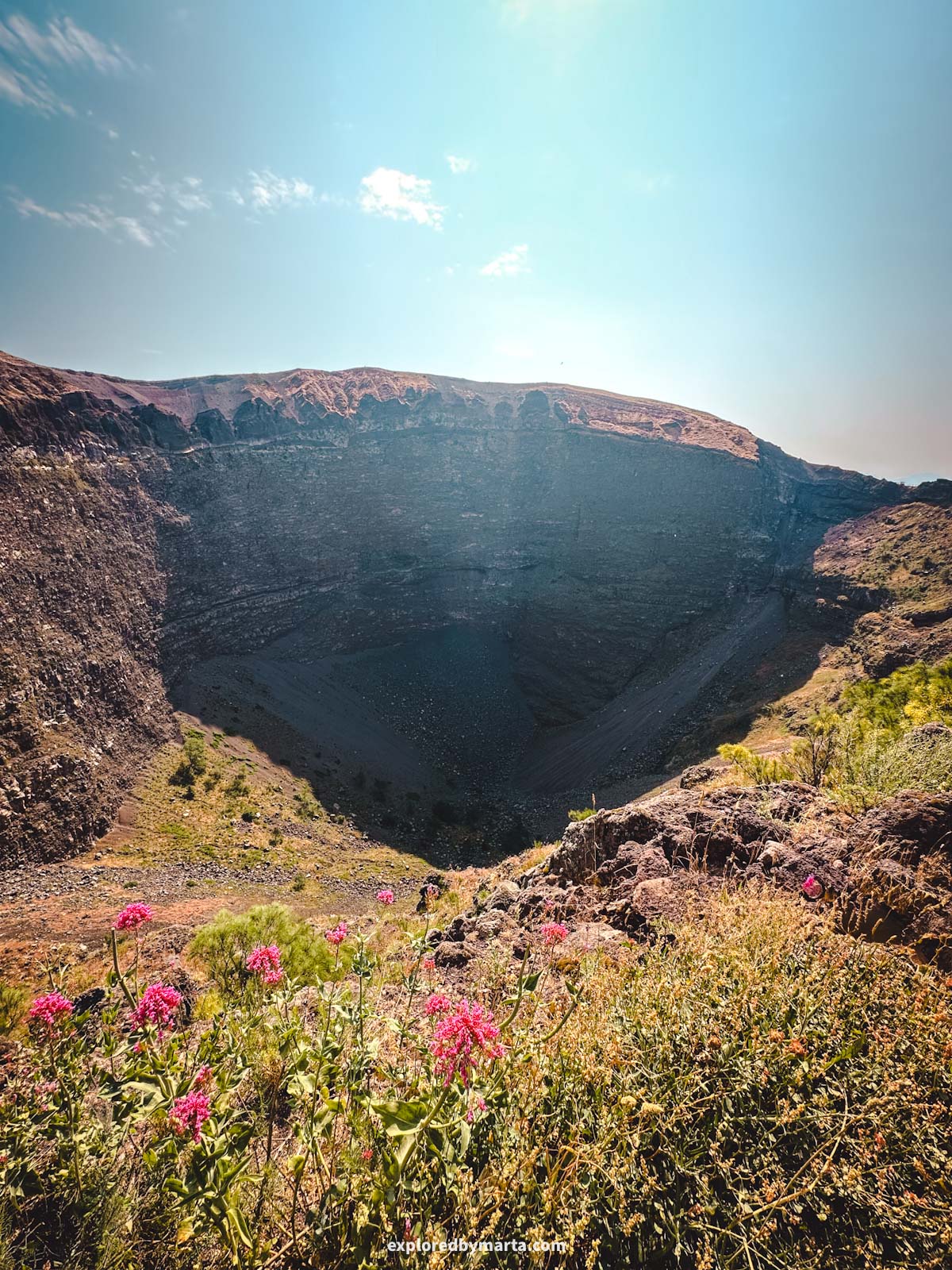
Talking about iconic hikes..Who remembers the notorious volcano from history lessons that buried a whole town and its inhabitants under layers and layers of volcanic ash?
That’s Mount Vesuvius for you, and the doomed city of Pompeii. And I can’t be the only one who remembered the horror story of the Pompeii eruption from history lessons!
But did you know that you can actually hike to the top of this volcano and peek inside the crater? Yes. Now that I’ve seen it up close, it doesn’t seem so scary anymore, haha.
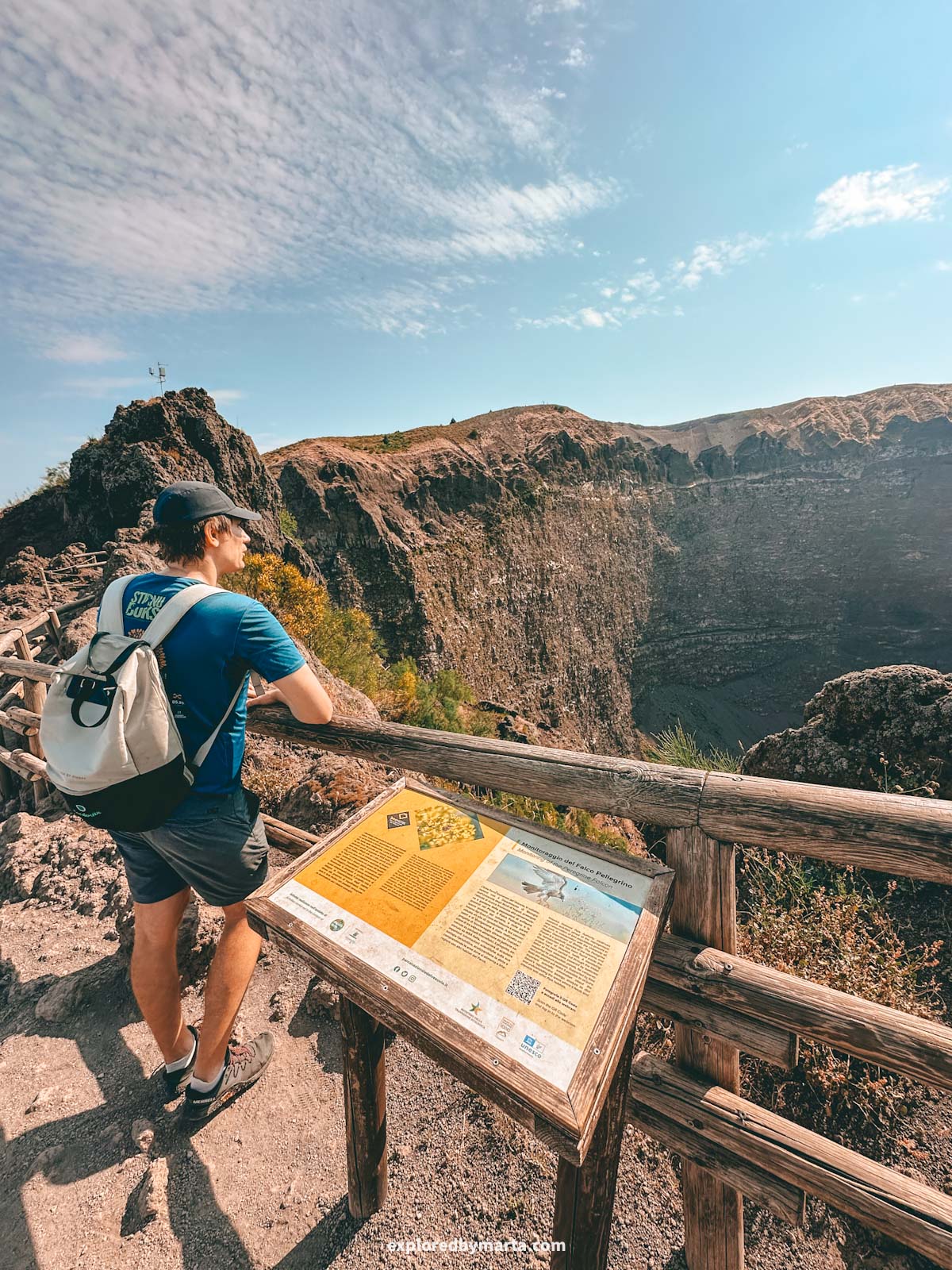
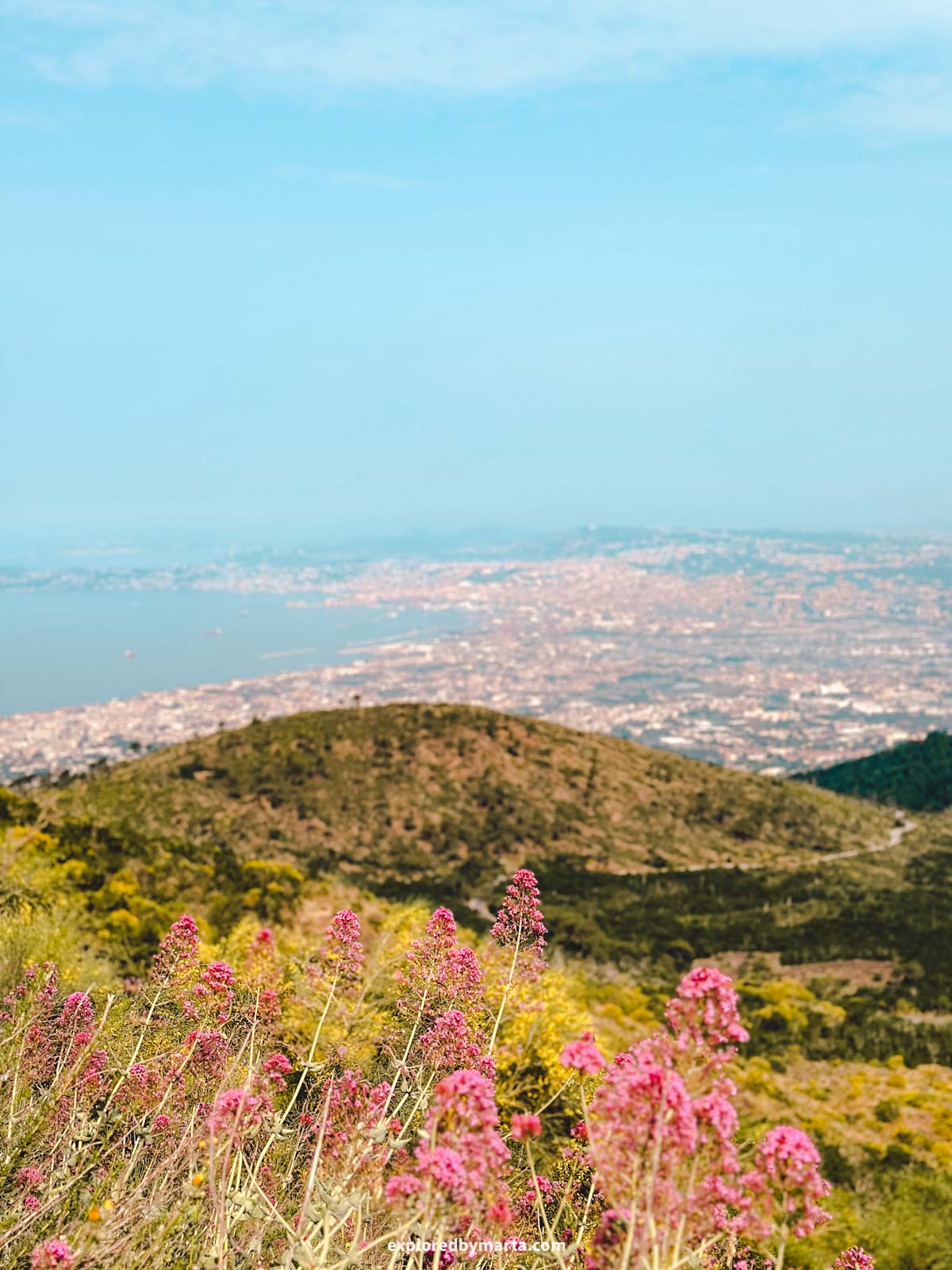
If you are traveling all the way to Naples and the Amalfi Coast, you might as well climb to the summit of Mount Vesuvius, one of the most iconic landmarks in the area!
Access to the crater is restricted, and you can only climb up there during opening hours after purchasing a ticket.
Because we had a car, we visited the volcano individually, but you can join some group tours, if it’s easier for you. See some of the tours below!
For those who rent a car, you’ll have to drive to the Mount Vesuvius parking lot (book your spot in advance!), and then start hiking up from there if you want a longer hike, or jump on a shuttle bus if you want a shorter hike.
We started climbing up from the parking lot, and after 1 hour and 3.6 kilometers or 2.2 miles, we reached the far end of the crater (the furthest we were allowed to go).
The round trip took us just under 2 hours, and we did 7.2 kilometers or 4.5 miles.


However, most of the visitors take a bus up to the ticket office/visitor center and start the hike there.
From there, the hike to the far end of the crater will be 1.7 kilometers or just over 1 mile long and will take about 30 minutes. It is a steeper climb up to the crater!
Best time to hike this? Definitely in the morning, if you can, before the midday heat and before the crowds show up! Climbing Vesuvius is quite a popular activity, and it does get crowded!
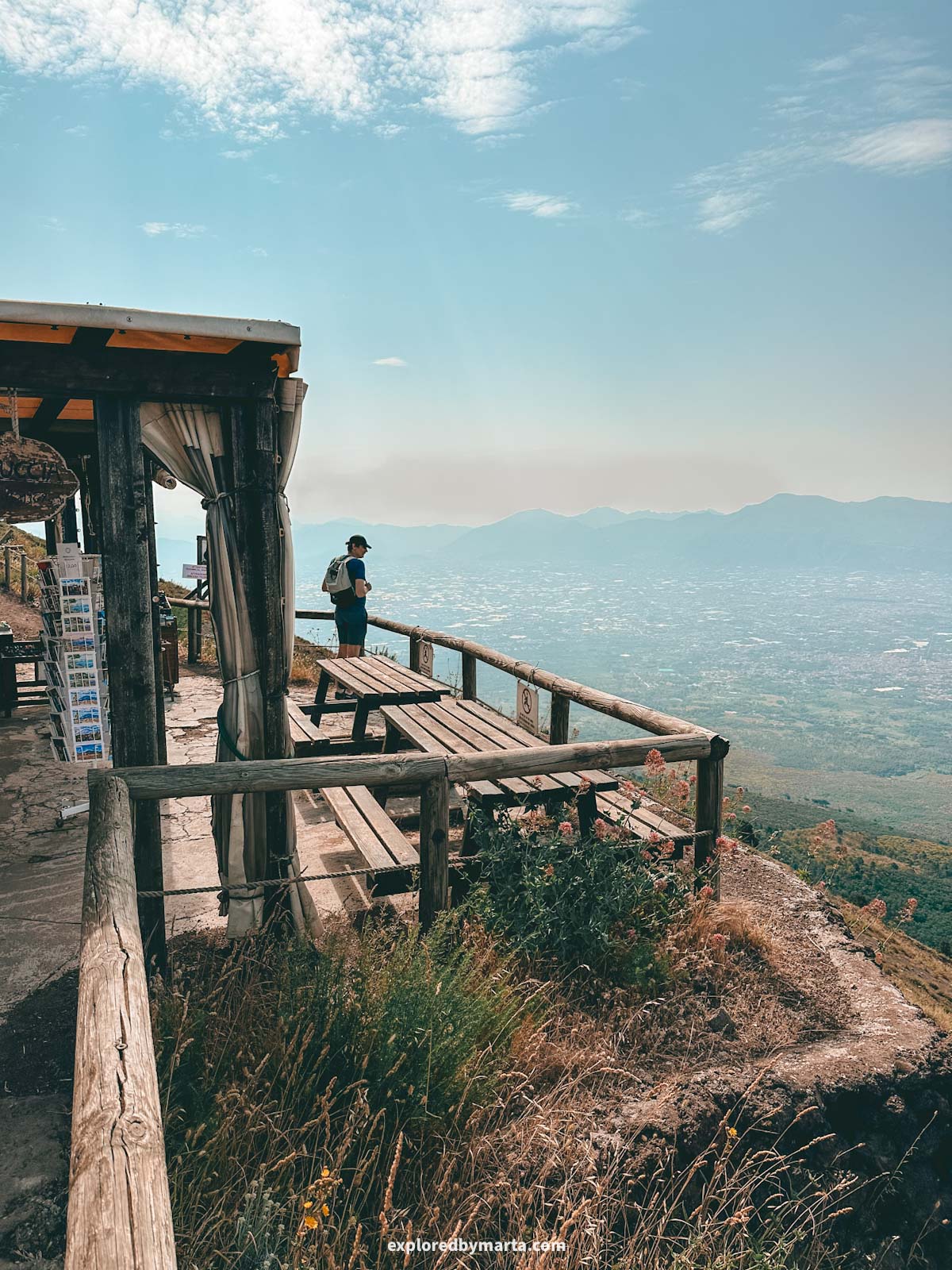
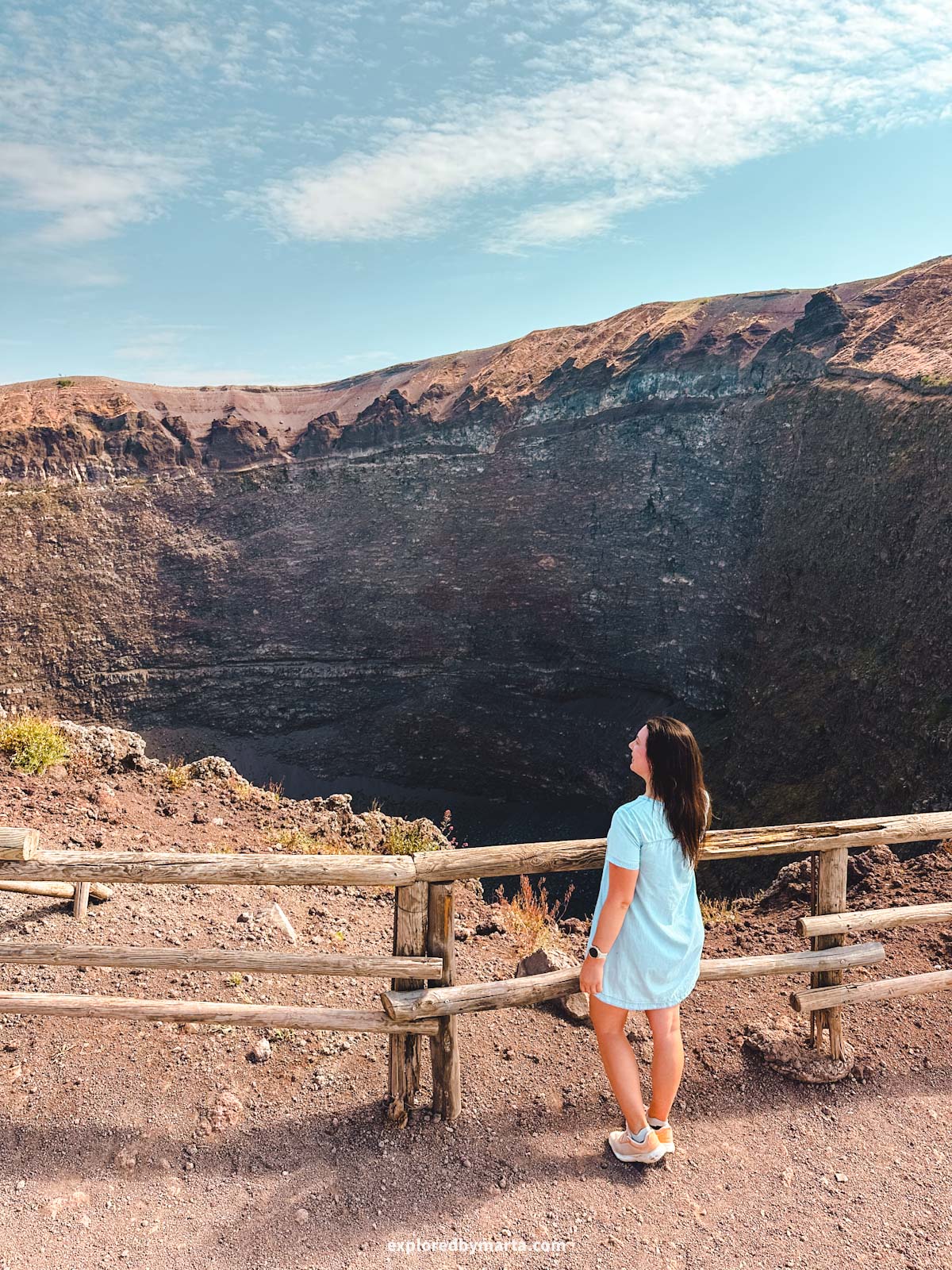
We entered right after it opened and could explore on our own, but I’ve heard that later in the day, they let people inside with 10-minute intervals and in groups.
Nevertheless, this is a once-in-a-lifetime thing to do! I was shocked by how deep the crater was, and we could even smell gases coming out of it. Vesuvius is still an active volcano, after all!
And those views! You can see Naples from above, and you get sea views of the Gulf of Naples, as well as views of the doomed city of Pompeii, if you can find it in the maze below.
Made me realize how powerful the 79 AD eruption was, because Pompeii is quite some distance away from the volcano!
Location: Vesuvius Parking – Vesuvius Crater Access
18. The ancient ghost town of Pompeii

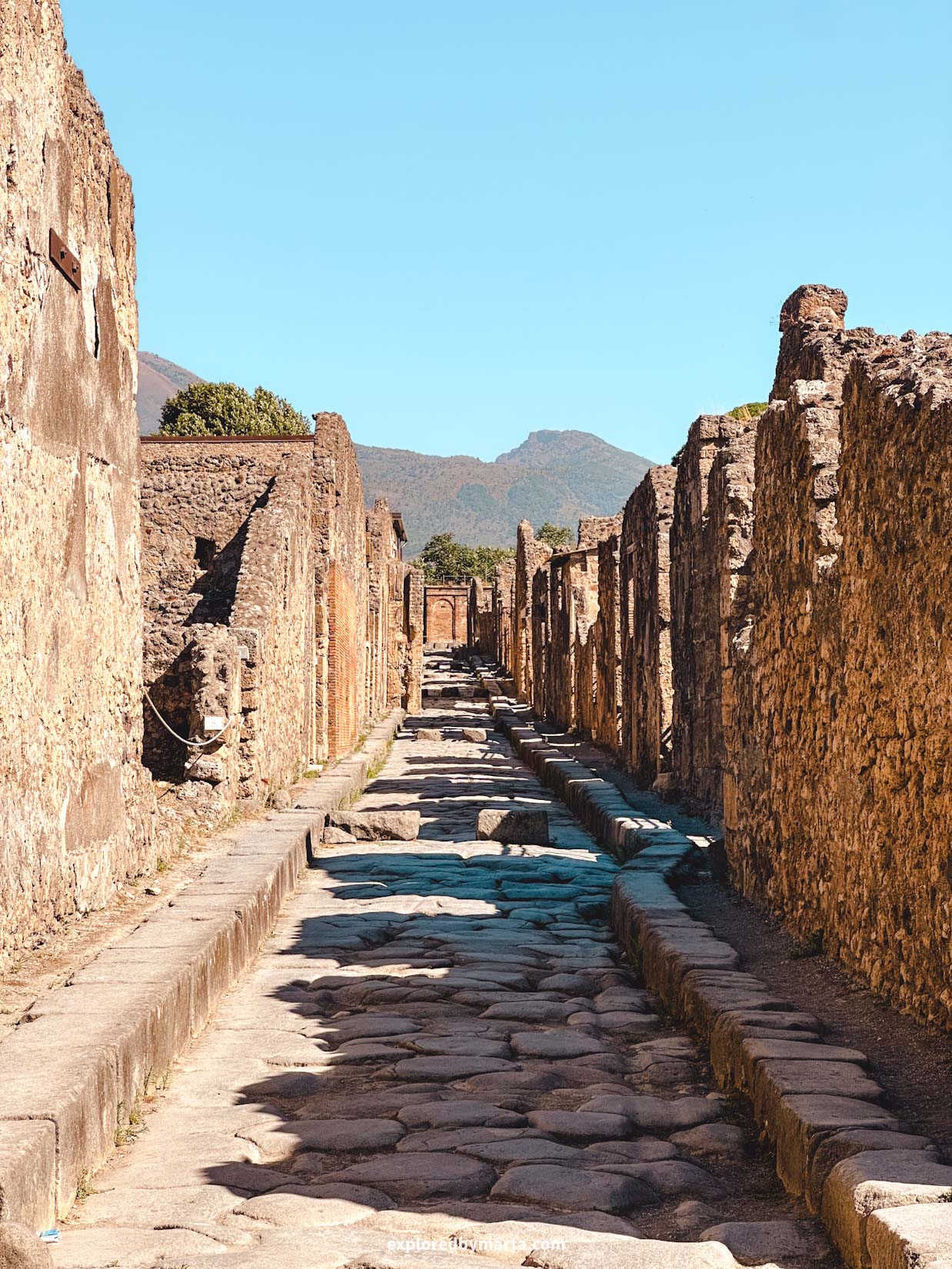
So, if you’re visiting Mount Vesuvius, Pompeii also has to be on your Amalfi Coast itinerary!
Pompeii was once a bustling Roman city of 10 to 15 thousand residents, sitting at the foot of Mount Vesuvius, until one fateful day in 79 AD, when Vesuvius violently erupted.
As a result of this sudden eruption, the city, along with many of its inhabitants, was buried under thick layers of volcanic ash and pumice, effectively freezing it in time. The eruption actually began the day before, which allowed some residents to escape.
You can imagine that at that time, digging out a whole city was no easy task. So, it lay there largely forgotten for centuries, until its rediscovery at the end of the 16th century, and then more significant excavations began in the mid-18th century.
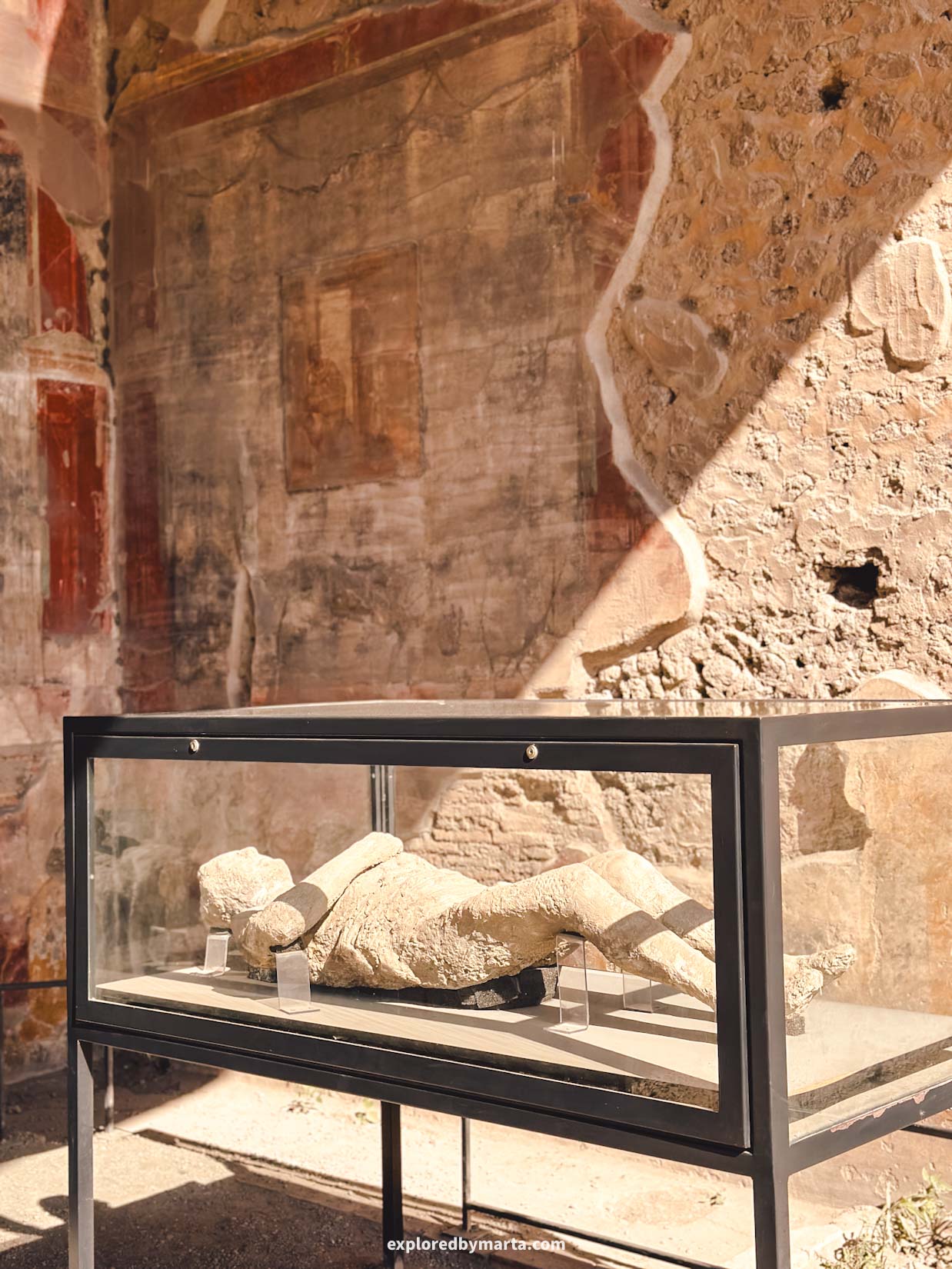
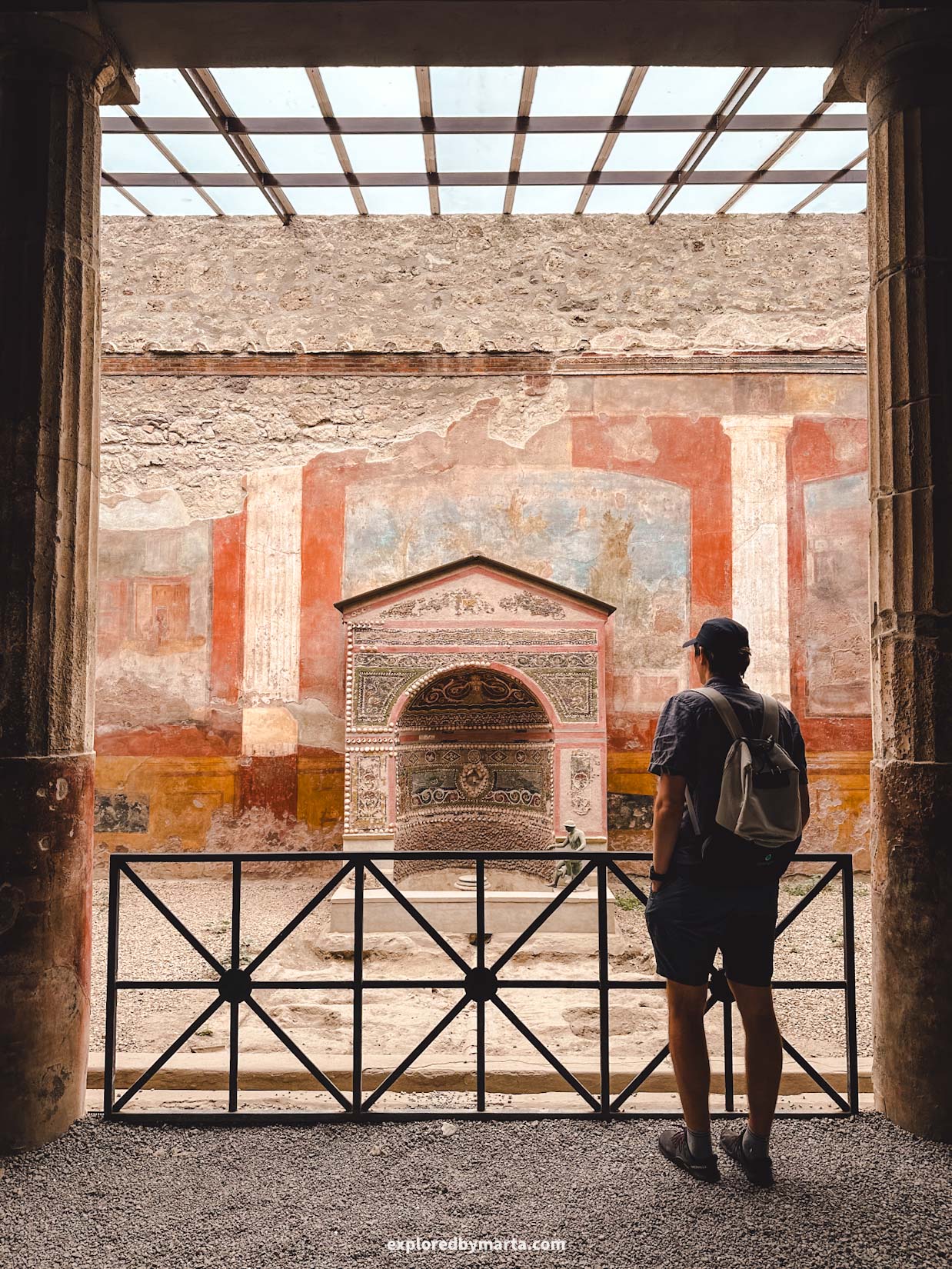
Today, Pompeii, a UNESCO World Heritage Site, stands as the world’s only fully preserved archaeological site where you can witness an entire ancient Roman city. You’ll see exactly how it looked with its shops, bars, villas, streets, squares, temples, and more.
The Pompeii archaeological site is also one of the most visited places in Italy, drawing a couple of million visitors to this ghost town every year, so be prepared for that.
If you’re staying in a place like Sorrento or another town along the Circumvesuviana Railway line, which connects Naples and Sorrento, you can simply hop on the train and go to Pompeii directly. The train station is conveniently located just 100 meters from Pompeii’s entrance.
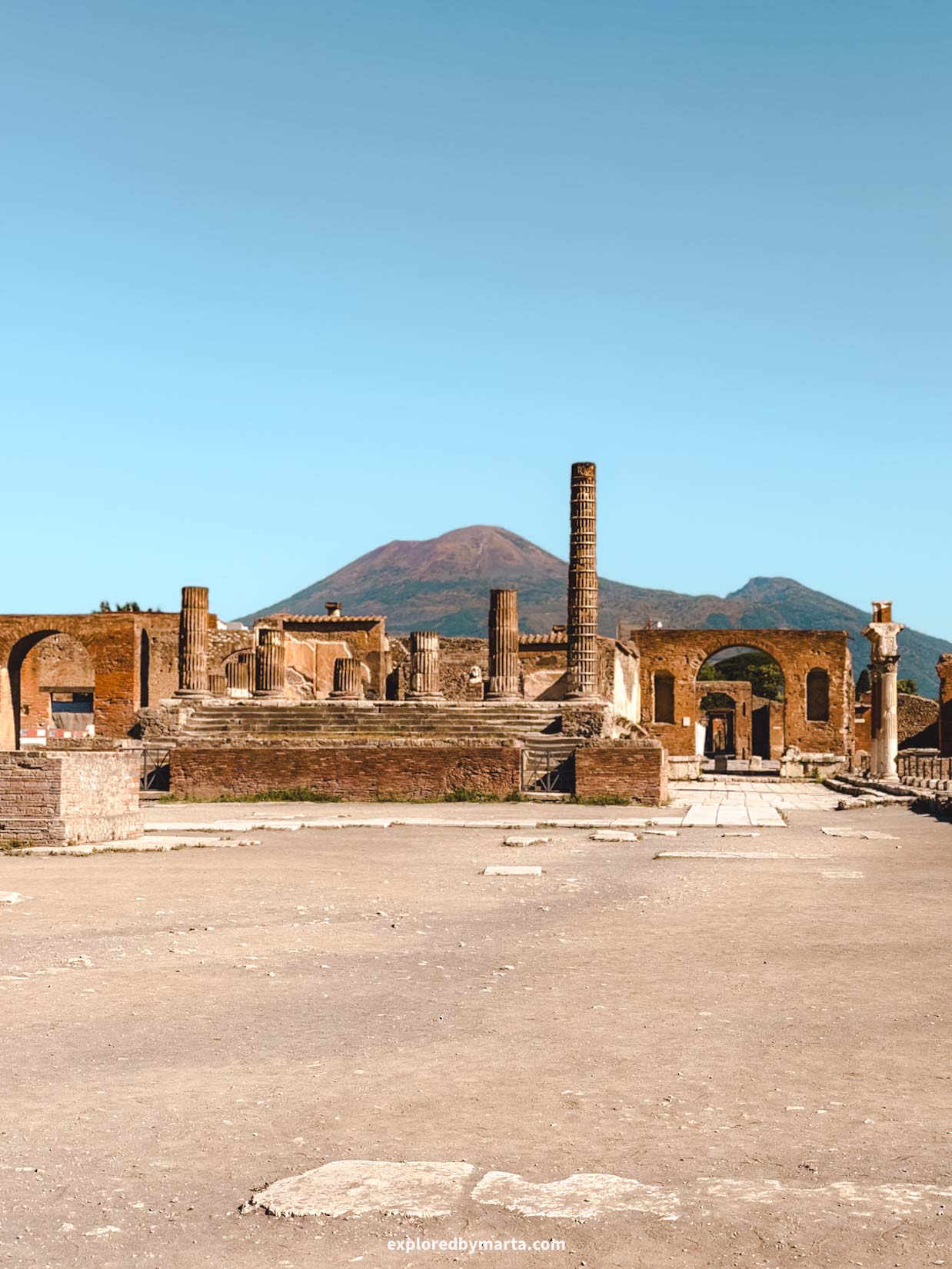
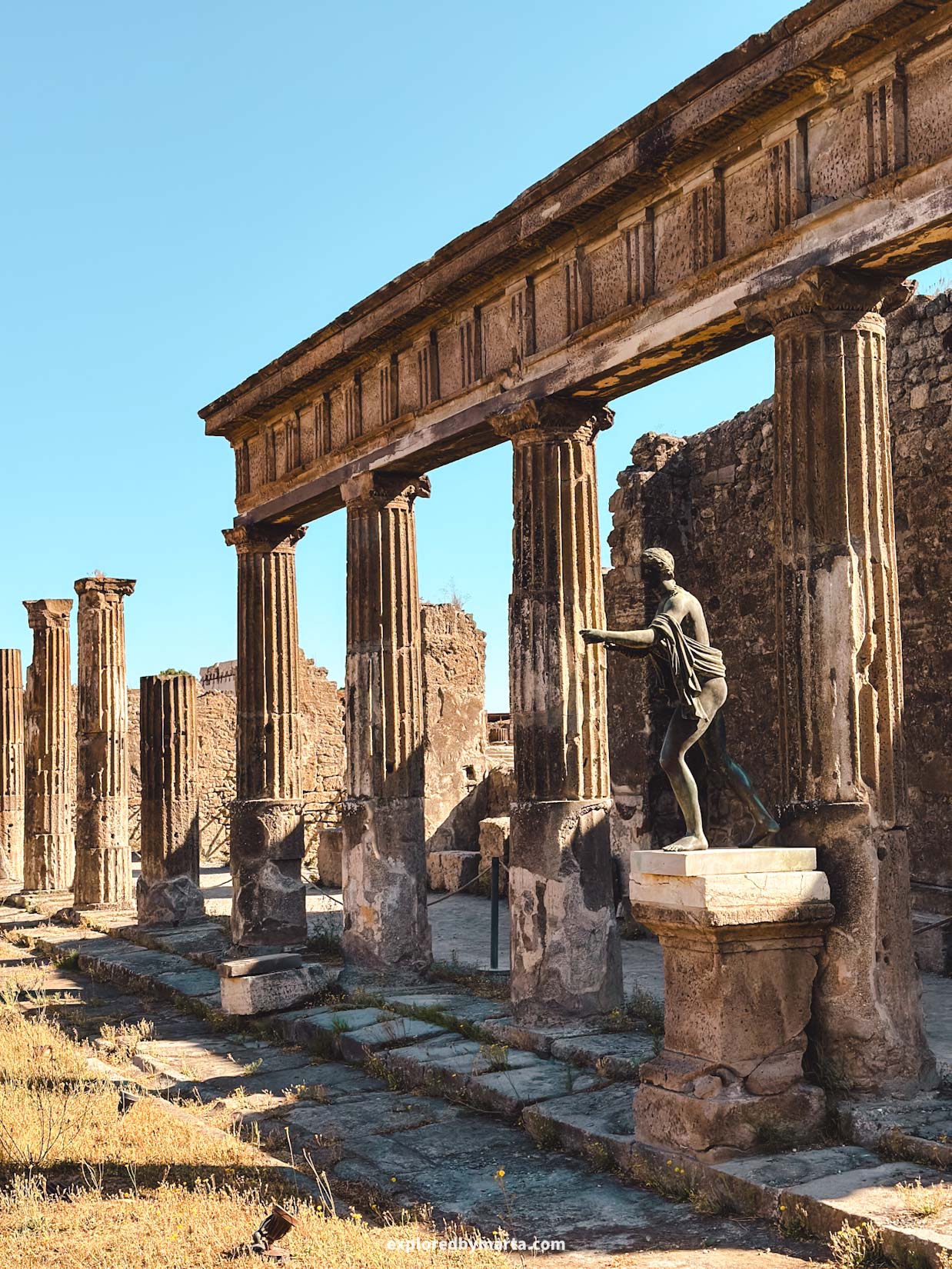
If you don’t live next to the railway, you can check out some of the guided tours that include transfers from hotels. We had a car, so we arrived on our own.
When we arrived at Pompeii in the morning, 90% of the other visitors headed straight for the ticket offices. Thanks to our online tickets, we were able to enter Pompeii as the very first two visitors of the day!
I also highly recommend drawing up a short plan of the key places you want to visit in Pompeii. The city is large, and you could easily find yourself wandering endlessly for hours. You can comfortably cover all the main and most interesting spots in a focused 2-hour visit.
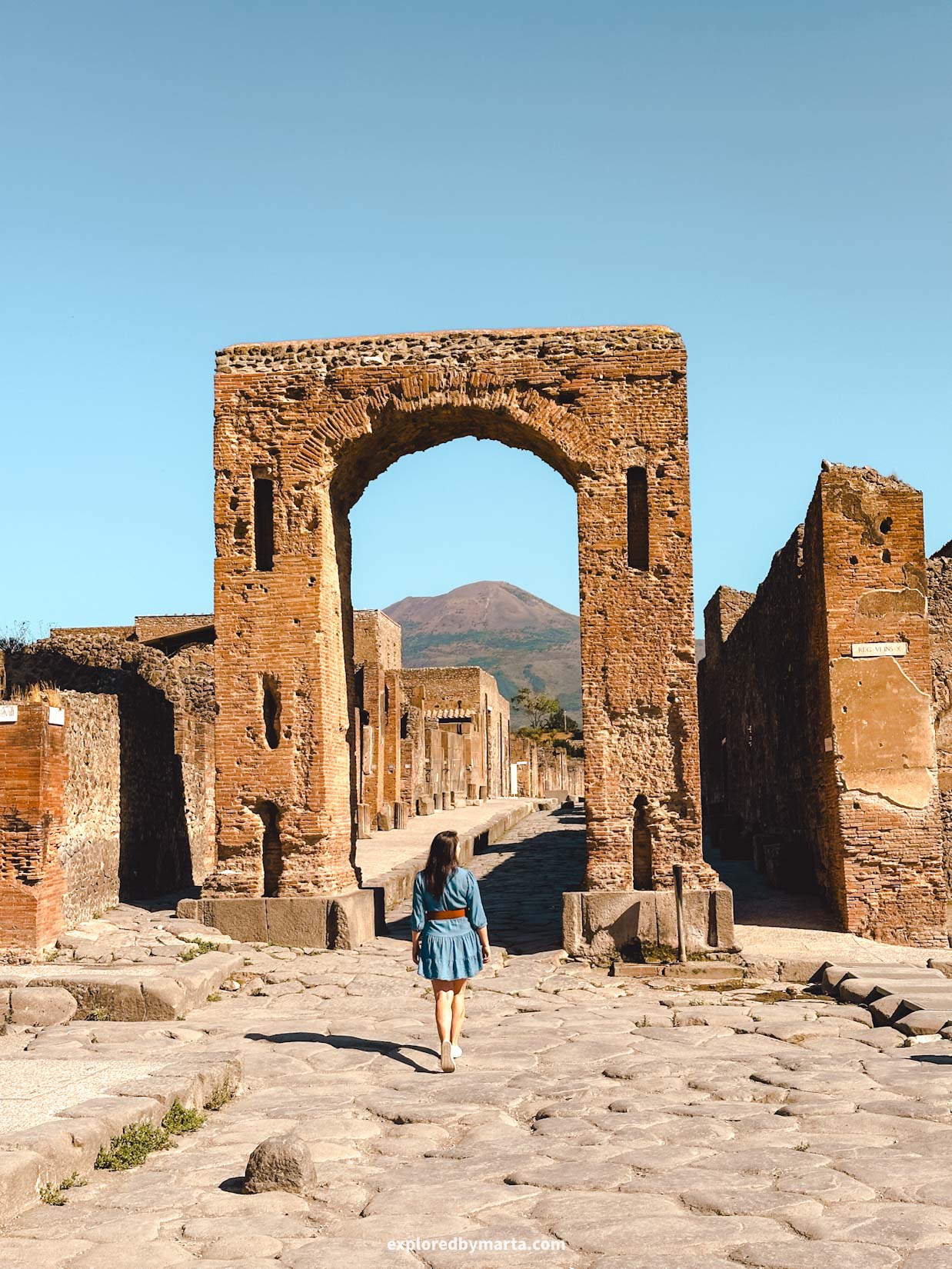
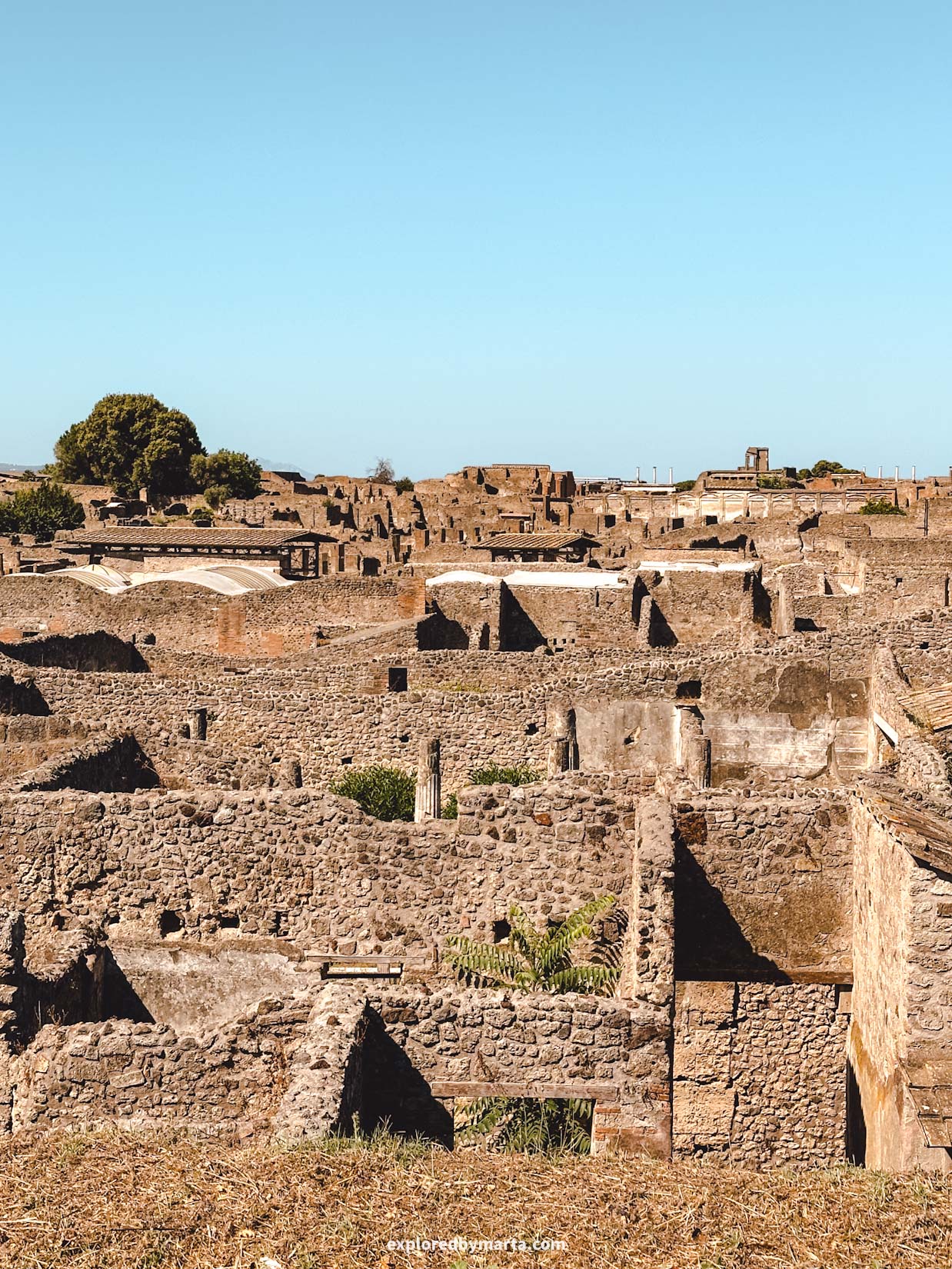
So, the best solution is either to book a guided tour with an archaeologist to truly understand what you’re seeing, or you can save the main highlights on Google Maps and follow your own self-guided route through the city.
My top locations in Pompeii included the historical Basilica, Temple of Apollo, and the massive Forum of Pompeii, with all the buildings surrounding the Forum Square. I also recommend looking into some of the ‘Casa’ buildings you see on Google Maps.
Those are actually 2-thousand-year-old luxury Roman villas with bright frescoes painted on the walls, mosaics covering the floors, and inner courtyards with statues and columns.
My favorite villas were Casa Della Fontana Piccola, Casa dei Dioscuri, Casa del Fauno, the largest house in Pompeii, Casa de Marco Lucrecio en la Via Stabiana, Casa del Menandro, Casa di Ottavio Quartione, and Lupanare di Pompei brothel.
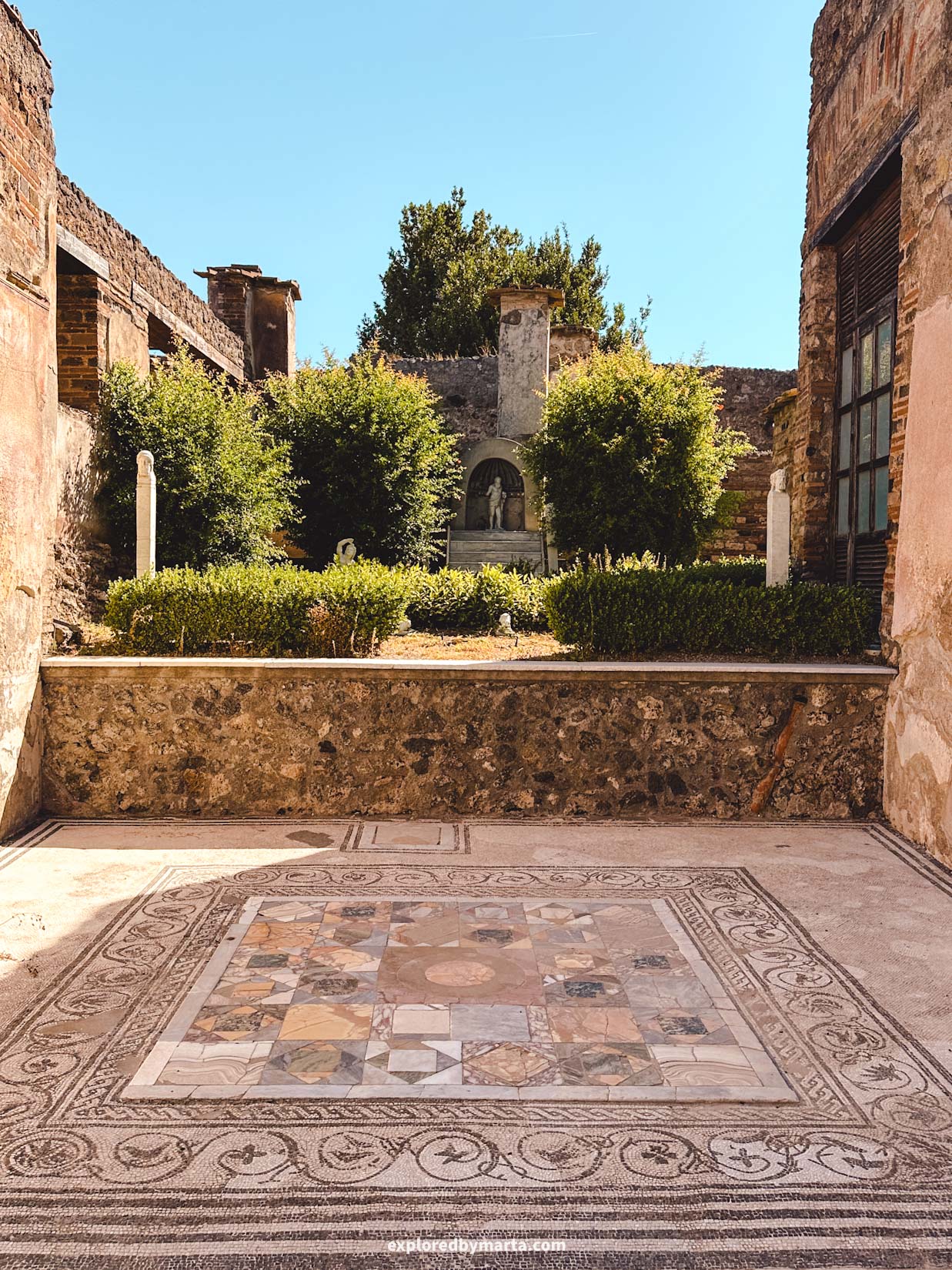

There are even more villas, however, at one point they all start looking the same, so we understood that it was time to finish touring the never-ending Pompeii villas, haha.
If you want to see the horrific sight of plaster casts of victims of the eruption, then try looking into the Macellum market next to the Forum of Pompeii, the Garden of the Fugitives, or Casa di Sirico, where they hold the first victims ever found during the excavations.
We also tried to check out the Amphitheatre of Pompeii and the Teatro Grande, but they were closed for restoration, so we could only see them from the outside. But we did get to see Pompeii from above, from a small hill where you can visit public toilets.
Pompeii is a place we will remember for sure.
Location: Archaeological Park of Pompeii
19. The underground Roman Villa in Positano

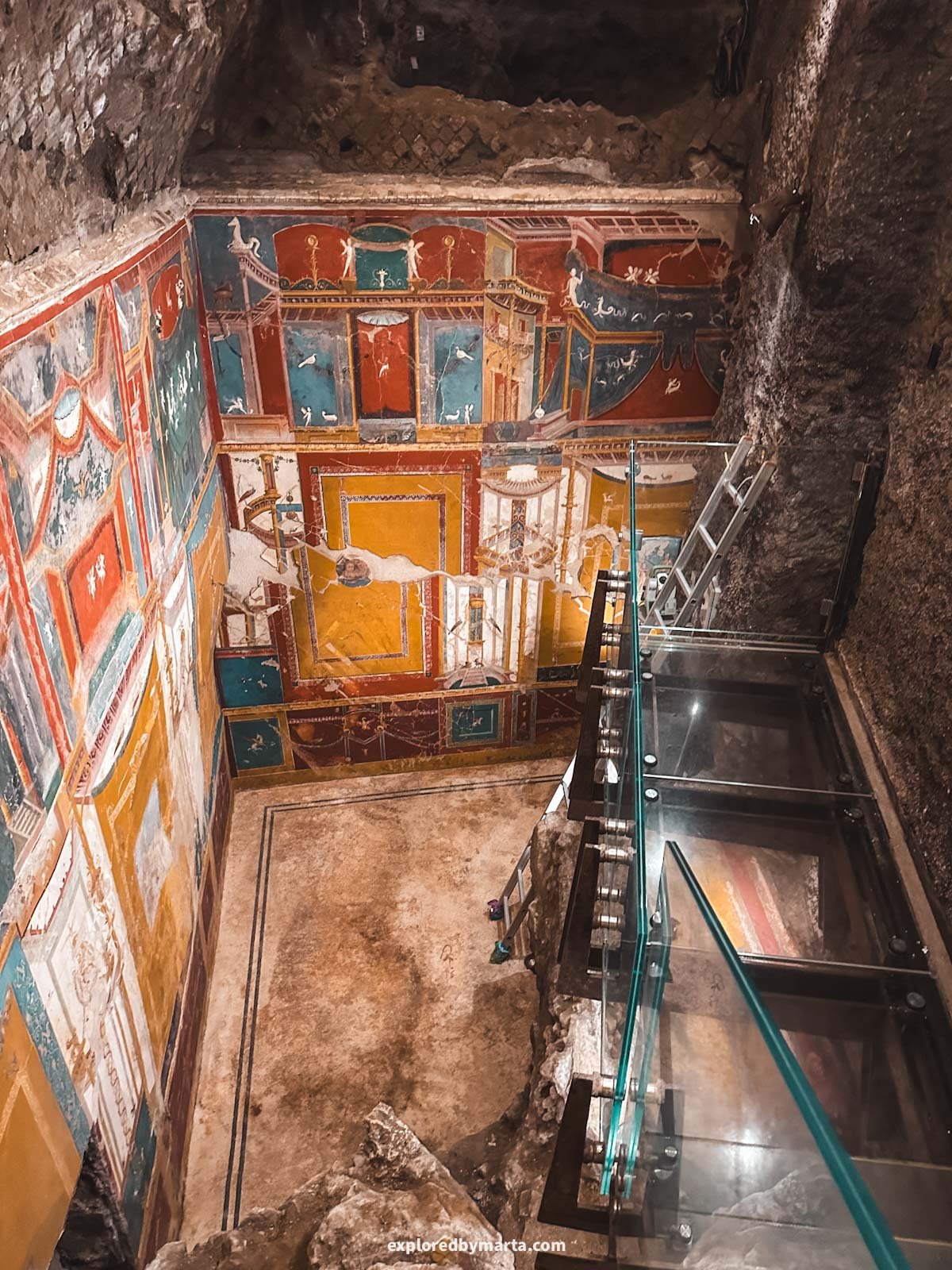
However, to visit ancient lost Roman Villas you don’t necessarily need to explore all of Pompeii. There are a couple of them you can find in the Amalfi Coast! My favorite? In Positano!
Positano is a must-visit destination on the Amalfi Coast, and is very familiar with mass tourism. But, believe it or not, there are still some lesser-known spots hidden from the crowds in Positano.
Where could it possibly be? Well, it is literally underground, and it is definitely one of my favorite hidden gems on the Amalfi Coast.
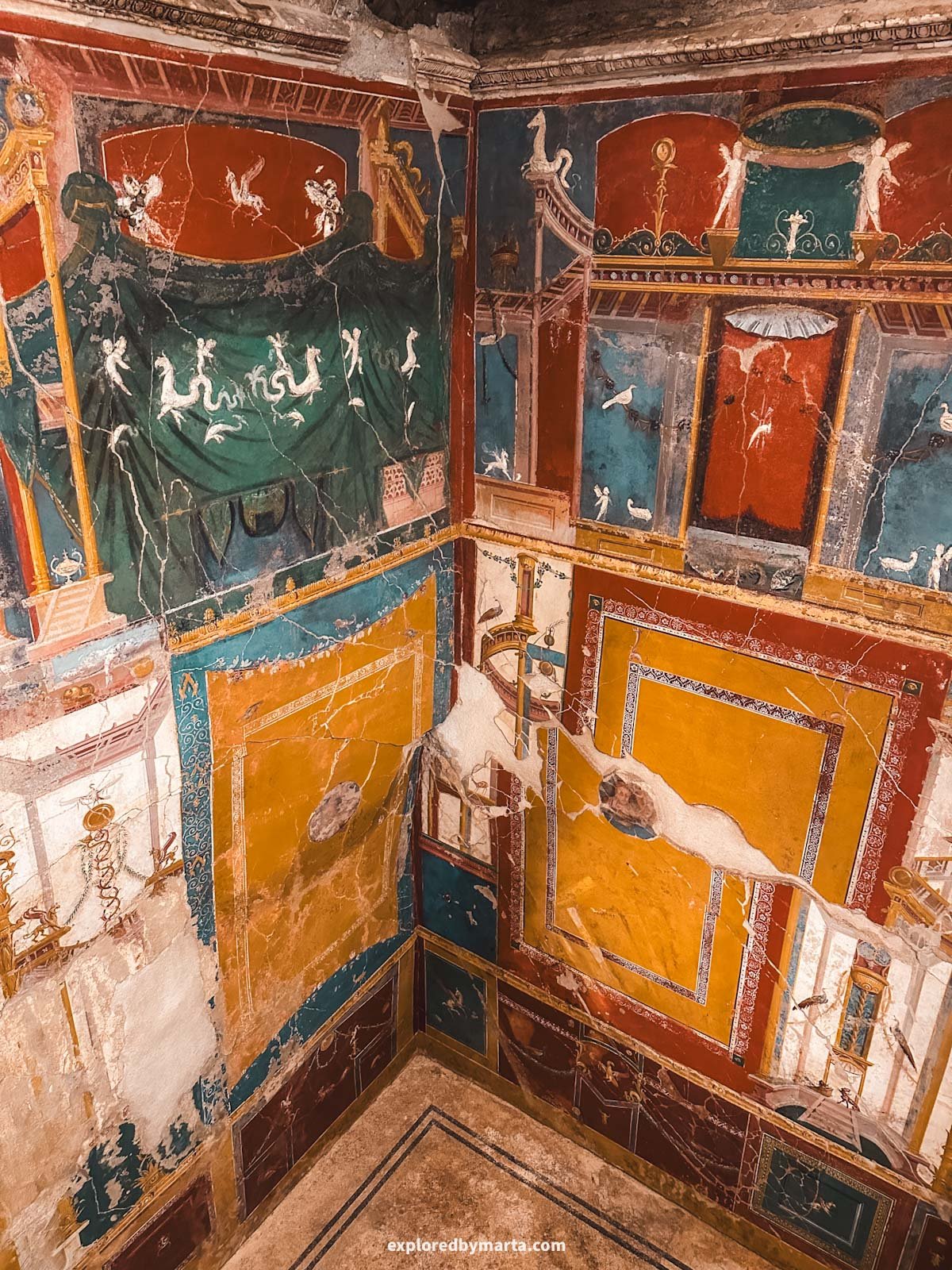
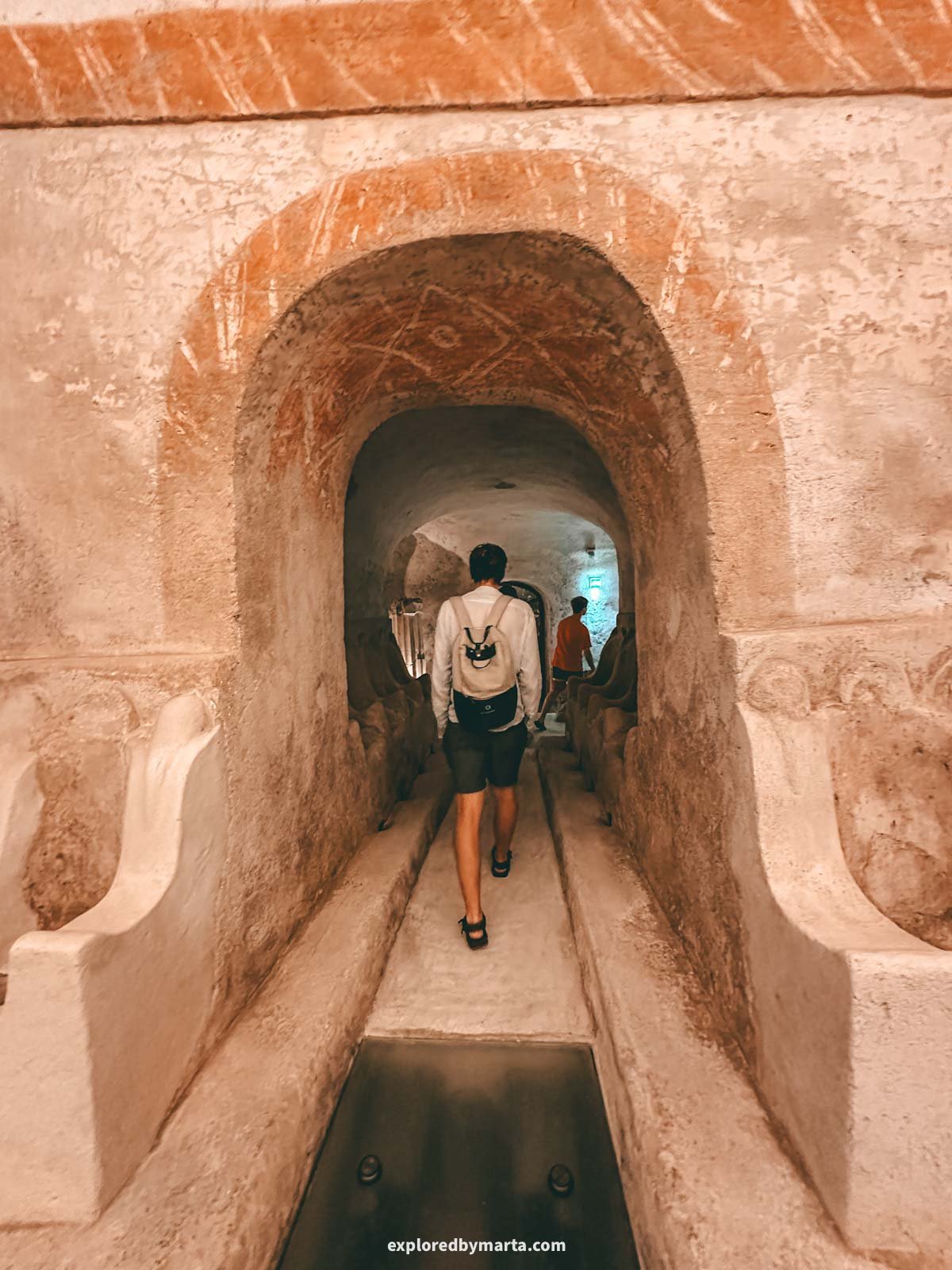
Before it became a famous tourist destination, Positano used to be an ancient fishing village. However, before it was a small fishing village, Positano was home to a large and lavish Roman villa.
Rich Romans, including some Roman Emperors, loved this area and built many summer residences along the Amalfi Coast, the Sorrento Peninsula, as well as Capri Island.
Only relatively recently was it discovered that there are remains of a large 2 thousand-year-old Roman villa under Positano. The villa was destroyed as a result of the infamous Mount Vesuvius eruption back in 79 AD, and was left buried under layers of ash and mud.
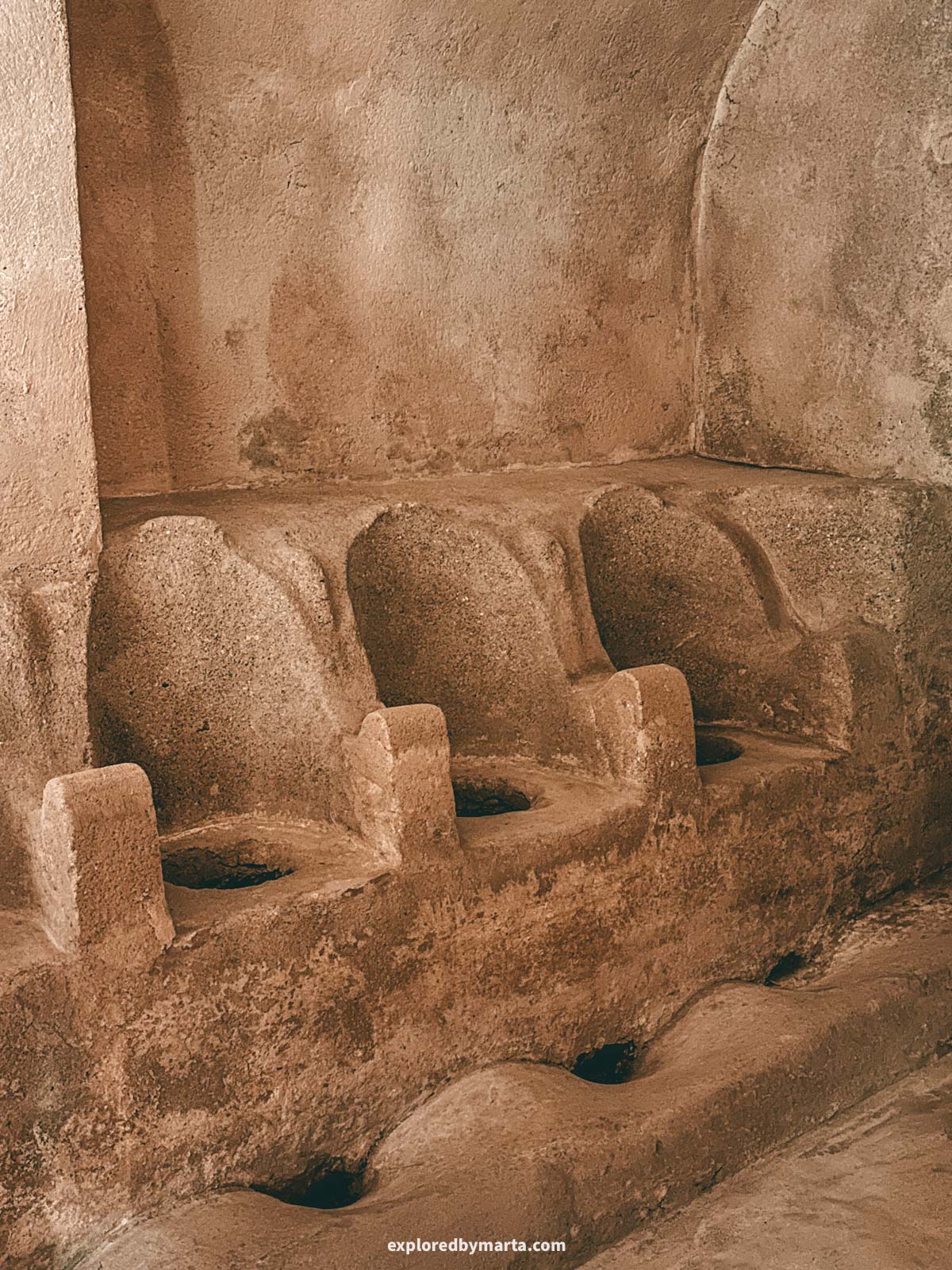
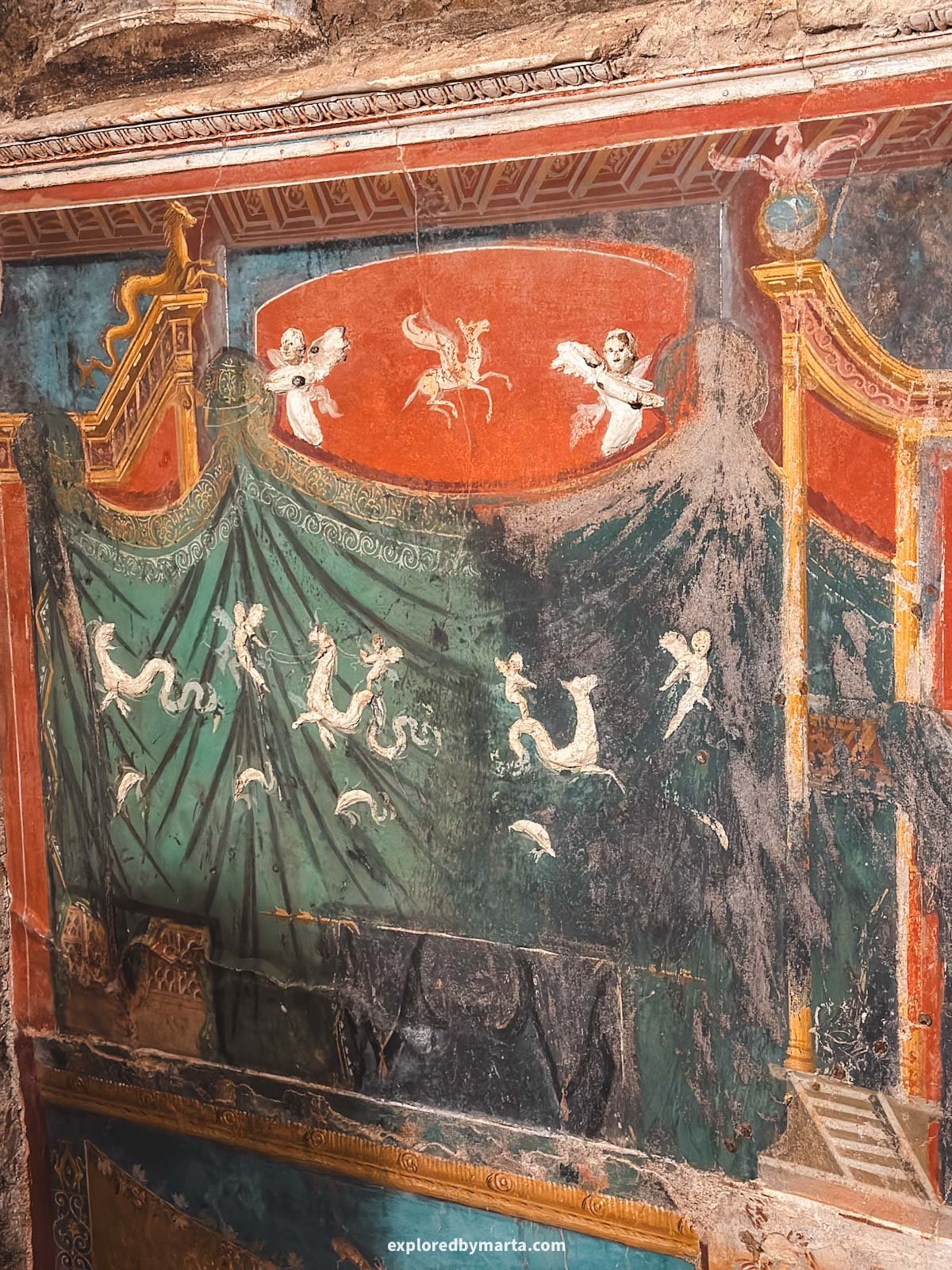
As centuries passed, the Roman villa buried 20 meters underground was forgotten, and a new fishing village formed where Positano is today. It grew bigger and bigger, until it was a town as we see it today.
But the forgotten villa still lies underground in the heart of Positano – right under the main church, Chiesa di Santa Maria Assunta. In recent years, thanks to archaeological excavations, a small part of the villa has been dug out and can be toured with a guide.
This seemed to be a great idea to us, and we joined this tour. The stories they told and places they showed were truly captivating.
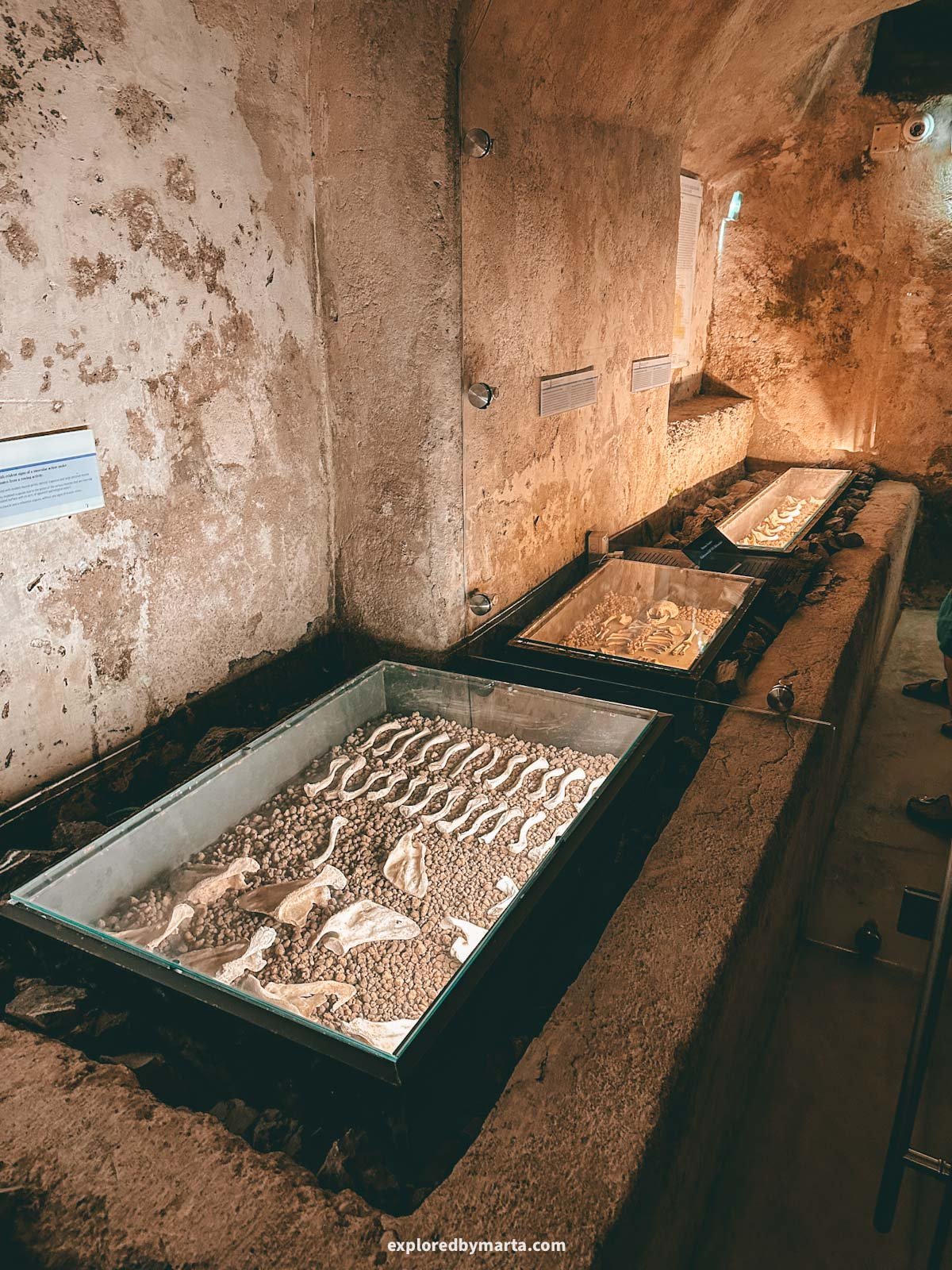
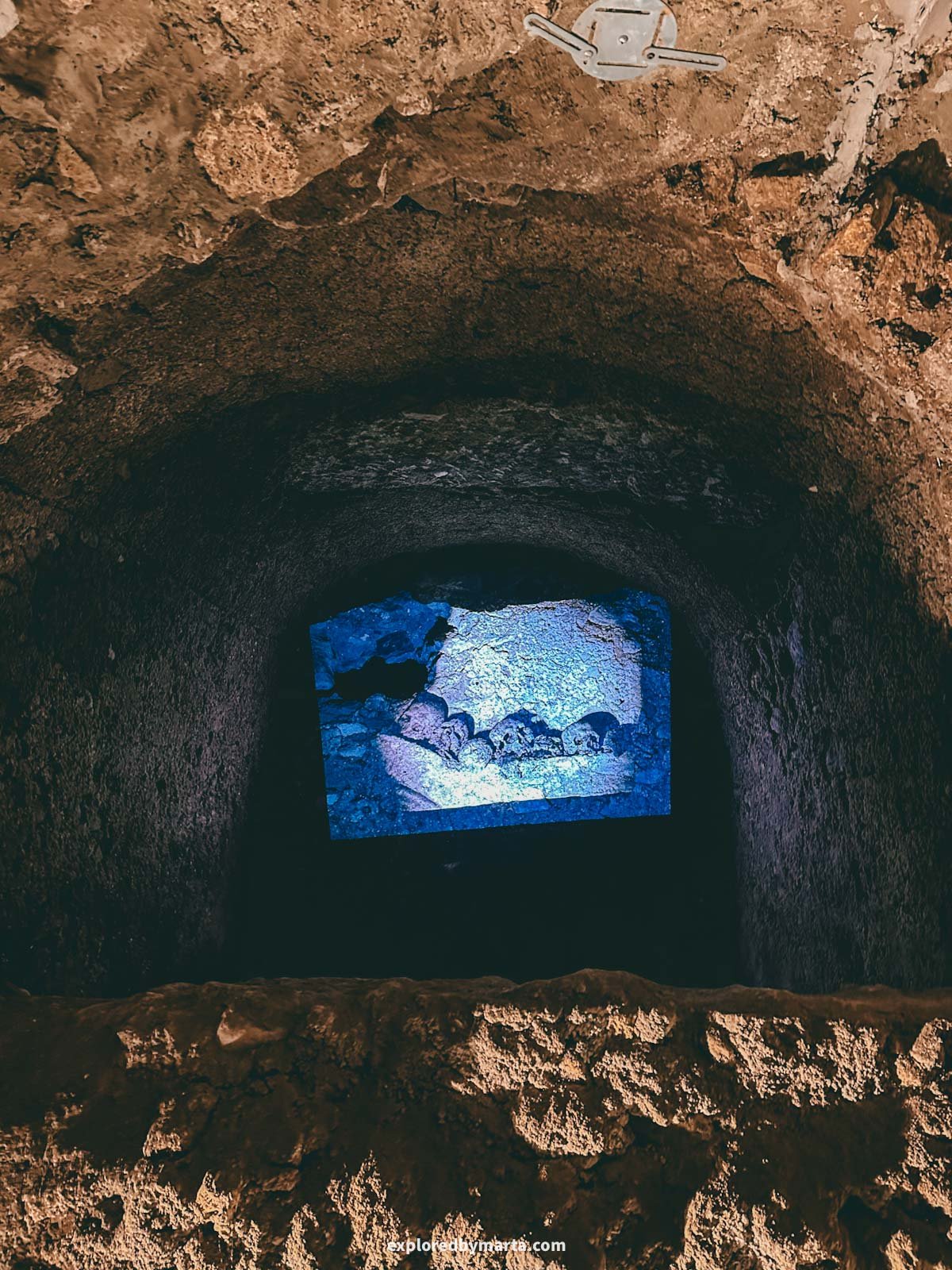
We saw the parts of the Roman Villa, saw many artefacts found in the villa, as well as from the monastery that was built above the villa in later centuries, and also walked around the catacombs where monks were buried in seated positions.
I cannot imagine the faces of archaeologists when they found a whole room of skeletons all sitting in chairs around the room. Yikes! Normally, I am not amused by such tours, but this was truly interesting, informative, surprising, and even shocking at times.
Exploring the lost history of Positano in a small group was unforgettable, definitely one of my favorite things to do in Positano. If you have an hour to spare in Positano, stop buying endless souvenirs and do this tour, hehe. You’re welcome!
Location: Museo Archeologico e Villa Romana
20. The 13th-century Torre Normanna in Maiori
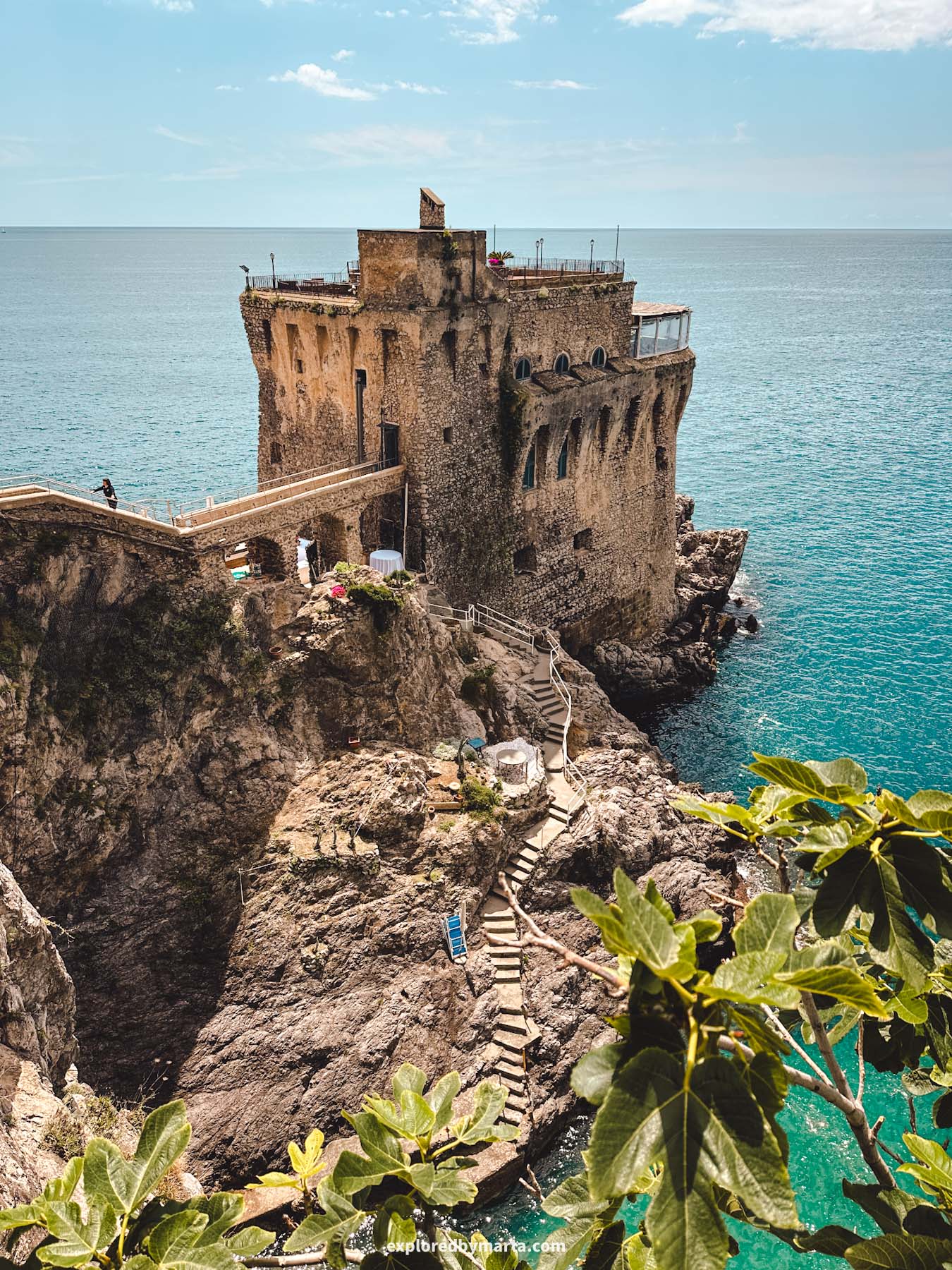
Are you looking for a restaurant with a view? For a special occasion, there’s no better place to celebrate life than at one of Maiori’s most iconic historical landmarks – the 13th-century Torre Normanna watchtower.
This medieval structure is one of several defensive towers built along the Amalfi Coast to protect the villages from pirate attacks. This particular watchtower is the oldest of them all.
Today, the Norman Tower is privately owned and houses a renowned restaurant offering panoramic views of the Mediterranean Sea and the mountains of the Sorrentine Peninsula.
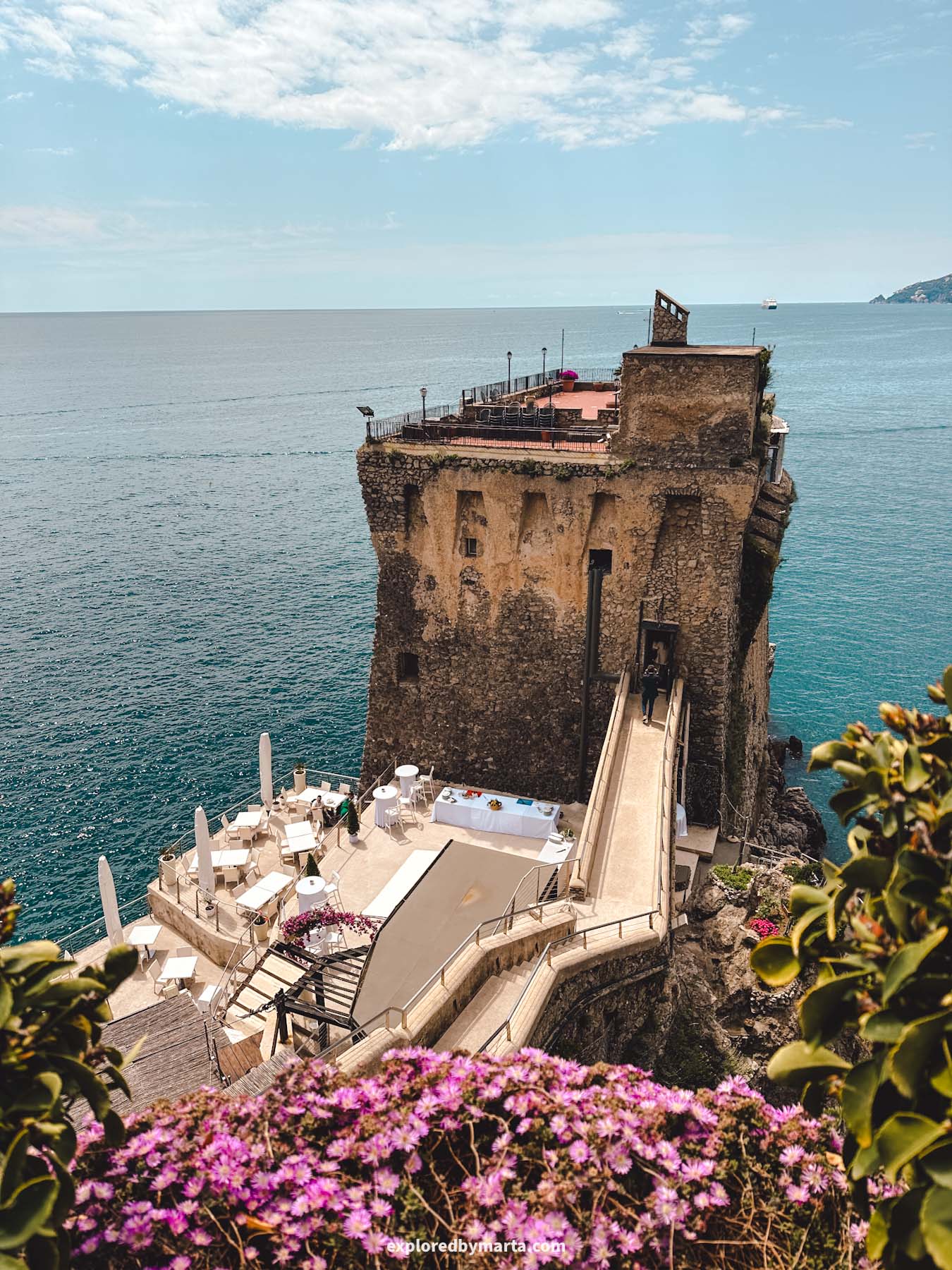
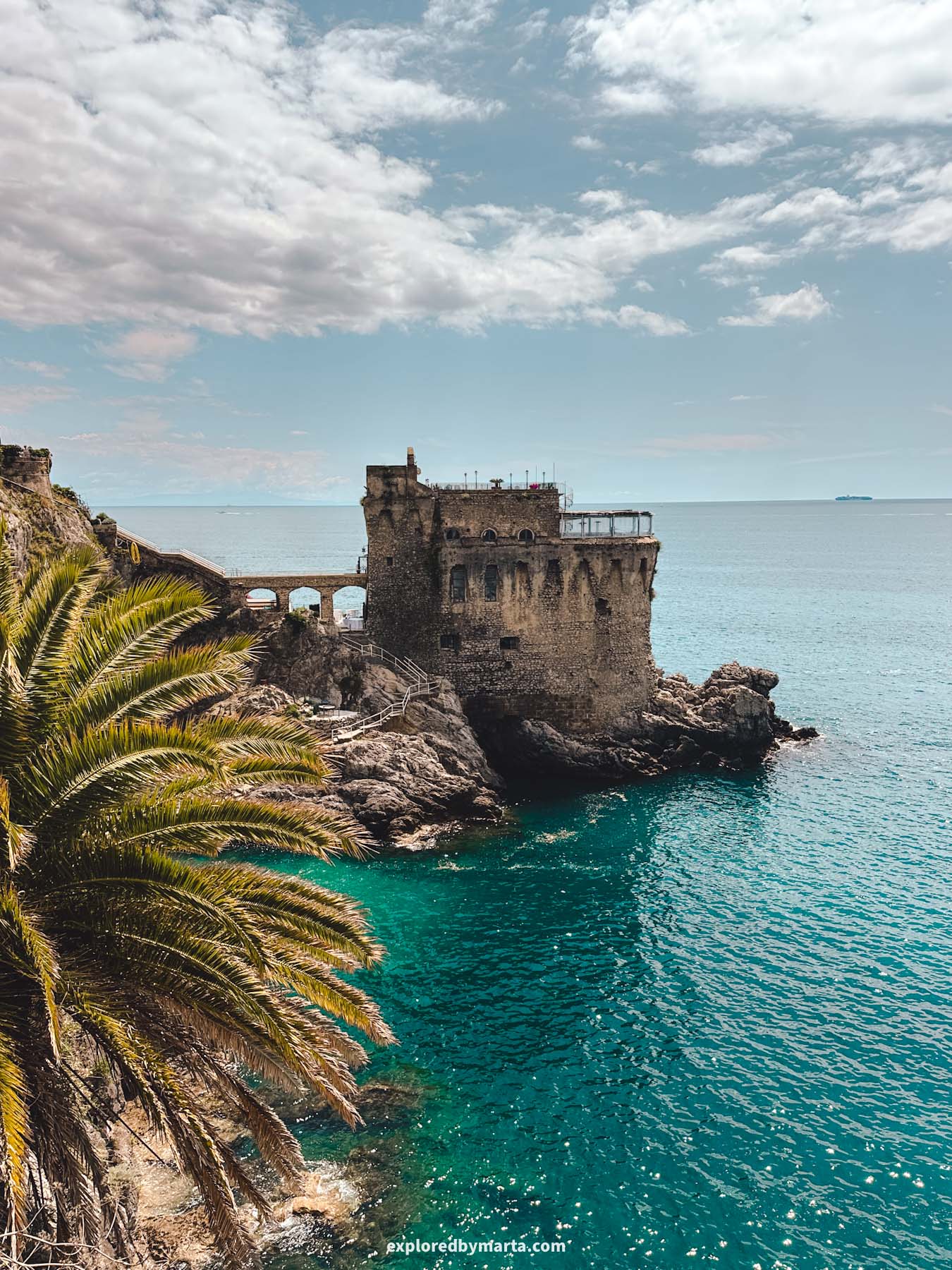
If you’re looking for a scenic lunch spot or have something to celebrate, I highly recommend checking out Ristorante Torre Normanna.
They offer seating on the rooftop, inside the tower, and on terraces closer to the water for a more intimate dining experience.
Just make sure to make a reservation or double-check with them if they’re open before you go! It is a popular place to celebrate weddings and other life events, so it may be closed for private events from time to time.
Location: Ristorante Torre Normanna
21. Paradise Cloister and underground crypt in Amalfi


For those of you who love historic places and centuries-old architecture, I recommend adding Chiostro del Paradiso, or Cloister of Paradise, right next to the Amalfi Cathedral, to your Amalfi itinerary!
The cloister dates back to the 13th century, when it was built and served as a burial place for noble families in the town. Today, you can stroll through and admire the cloister for a couple of euros entrance fee.
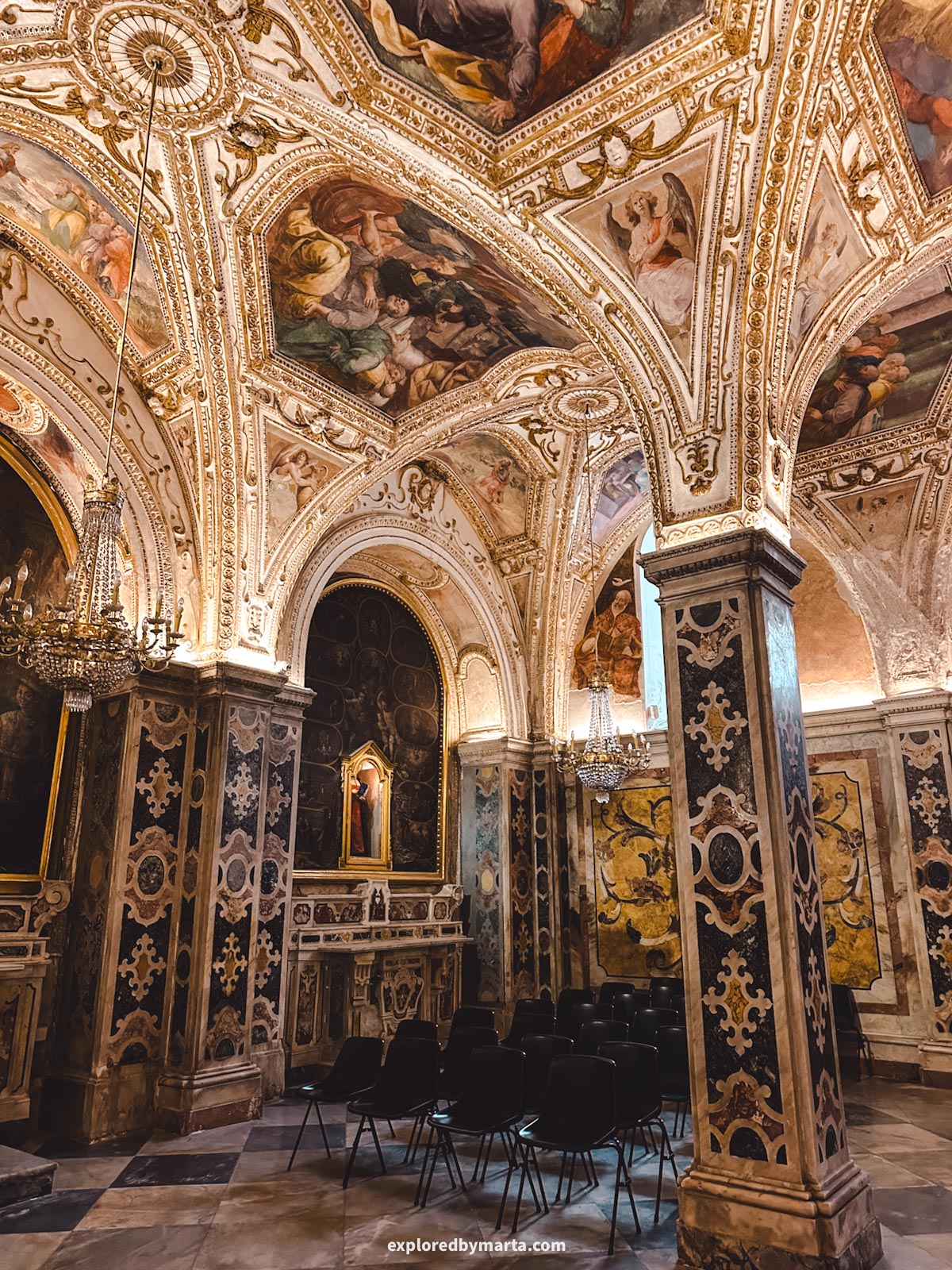

Entrance to the cloister also includes a visit to a stunning underground crypt housing the remains of Saint Andrew the Apostle. His relics were brought here in the 13th century from Constantinople.
As part of the tour, you also get to see the gorgeous interior of the cathedral with gilded columns and an adorned ceiling. Normally, the entrance door to the Amalfi Cathedral is closed.
Overall, it is a rather short visit; however, it is a wonderful and peaceful escape from the hustle and bustle in the Amalfi square. And I quite liked this place – it’s serene, it’s beautiful, and even a bit otherworldly.
Location: Chiostro del Paradiso
22. Chiesa di San Salvatore in Atrani

Here’s another must-visit place for lovers of architecture and historic places – the wonderful and unique Church of Saint Salvador De’ Birecto in the small town of Atrani.
It is one of the most unique churches I have seen, and I only saw it from the outside! Do you see how it is situated above the street with a white staircase to access it? Not many tourists know about this cool place.
The church dates back to the 10th century, and it played an important part during the 10th-11th centuries when the Duchy of Amalfi or the Republic of Amalfi was an independent country.
At that time, the Duchy of Amalfi was ruled by the Duke of Amalfi, who was crowned, right here on these steps! Atrani still celebrates yearly events, with people dressing in medieval gowns and ‘crowning’ the new Duke at the church stairs.
A cool way to preserve history and tradition!
Location: Chiesa di San Salvatore de’ Birecto
23. Marina di Praia in Praiano
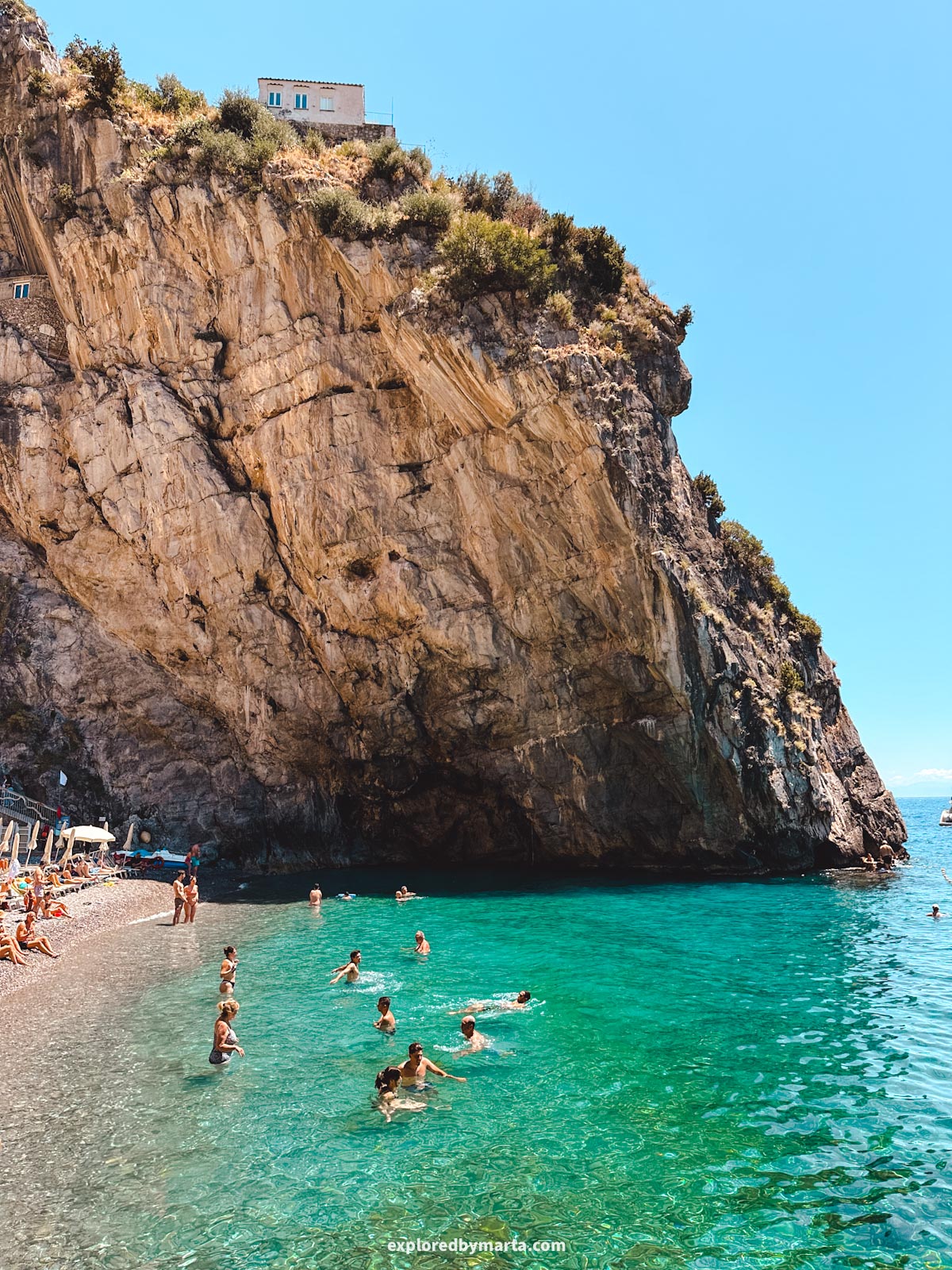

Praiano, one of the most scenic villages on the Amalfi Coast, boasts plenty of beautiful places. That includes Marina di Praia, one of the most beautiful but lesser-known beaches on the Amalfi Coast, with gorgeous, crystal-clear waters.
Not many people talk about this gorgeous place because it is not a central beach in a famous village. Because of that, it often goes unnoticed by the bigger crowds.
And I’m kind of happy about that! Tucked away in a picturesque cove squeezed between dramatic cliffs, Marina di Praia feels like a hidden secret on the Amalfi Coast.
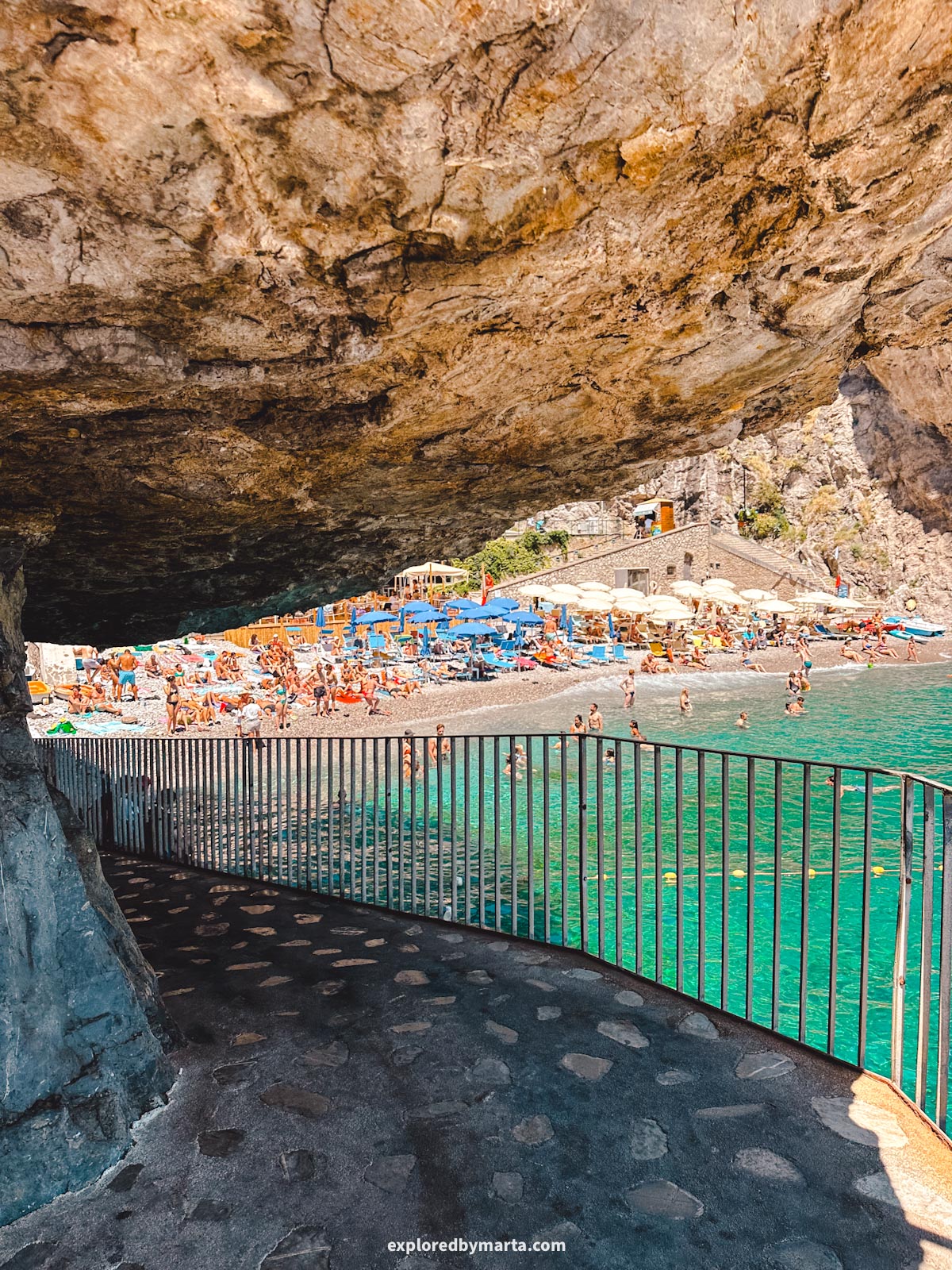

It’s a small pebble beach with crystal-clear waters and a couple of seaside restaurants offering drinks and snacks right by the blue water. People do know about this place, but because of limited space, there can’t be big crowds.
If you’re staying in Praiano or nearby, you must make your way down to Marina di Praia!
Despite its beautiful setting, it is a much more relaxed and chill beach compared to many other beaches you can find in the picturesque towns of the Amalfi Coast.
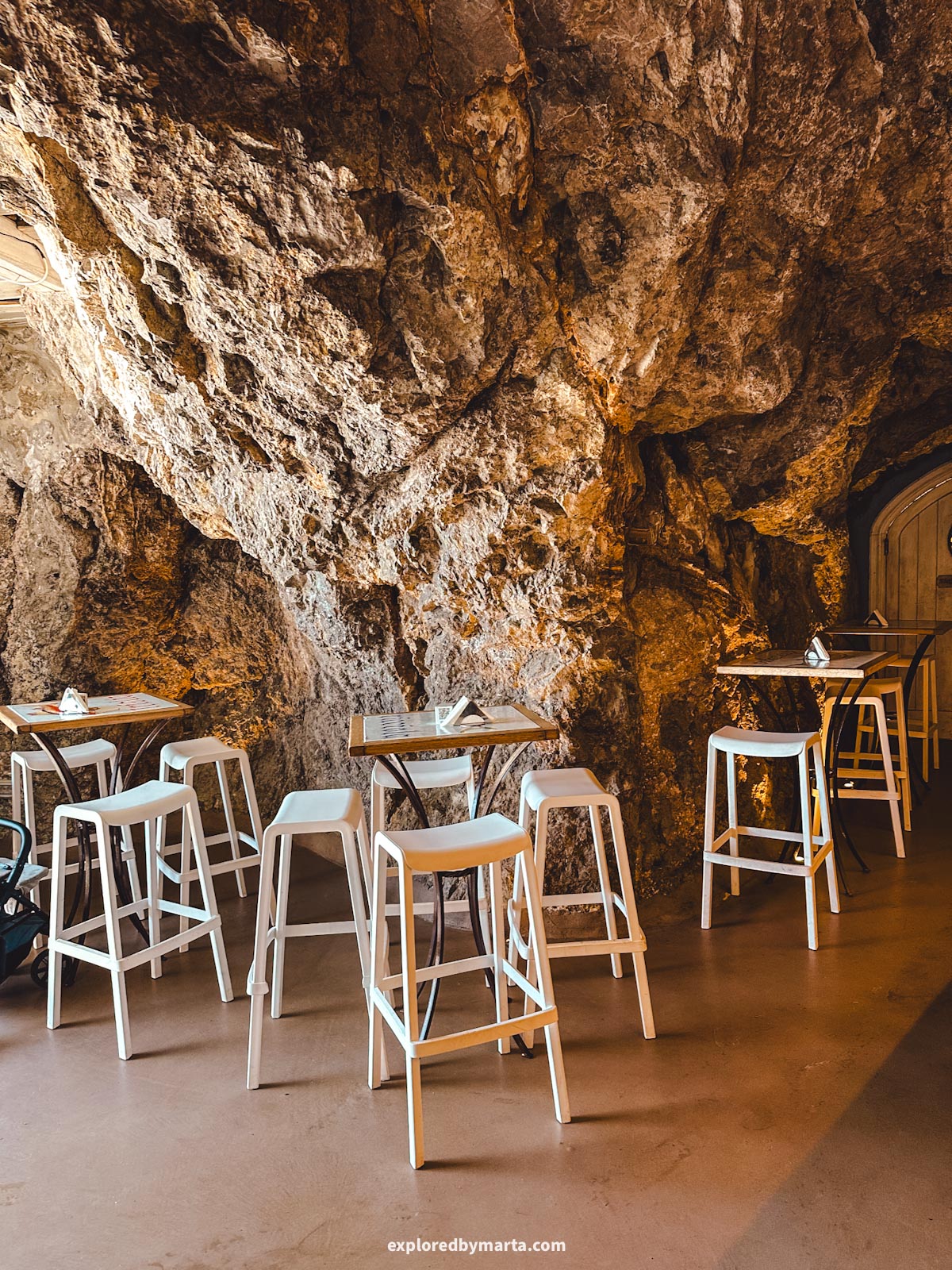
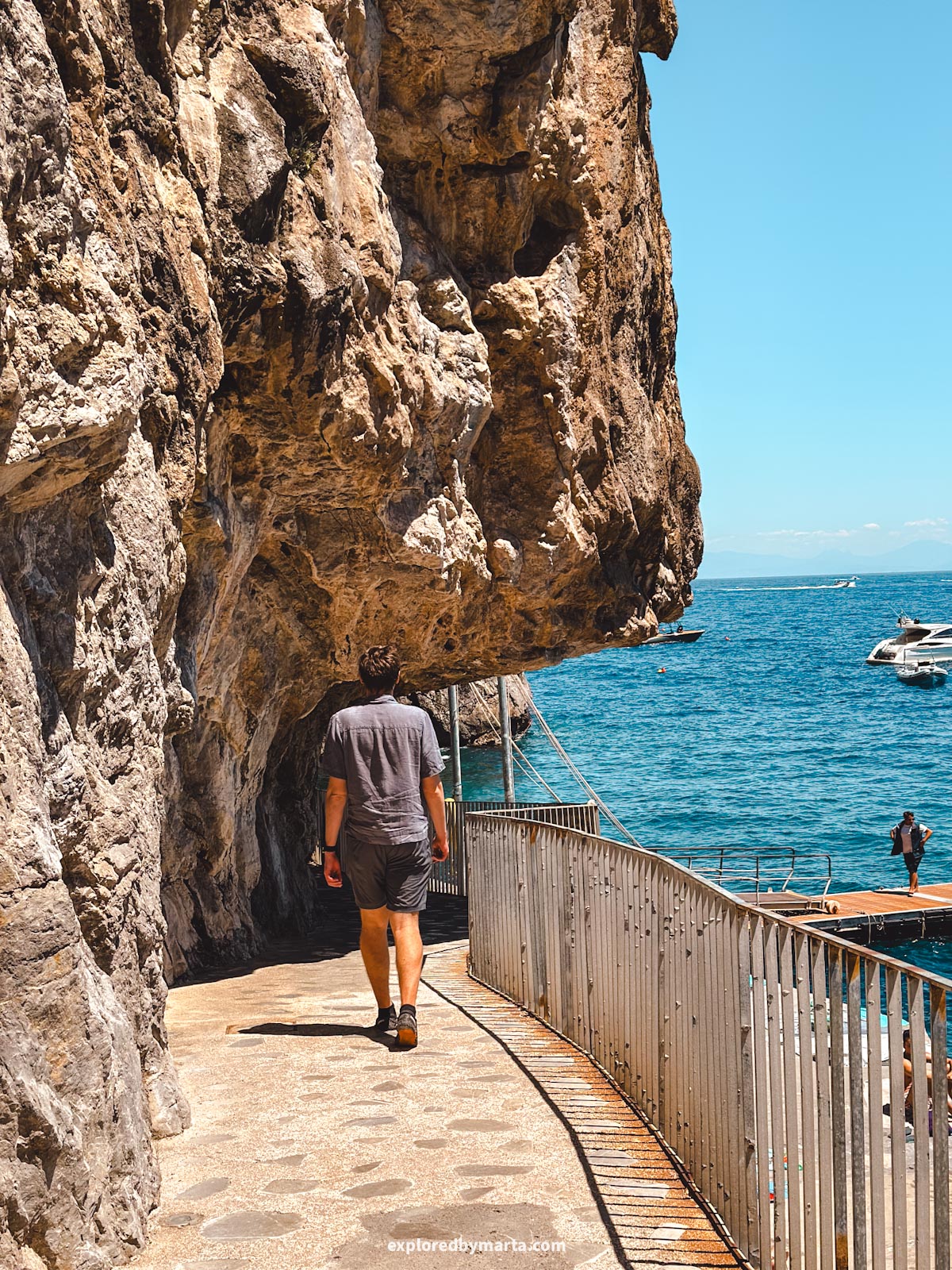
The secret of this beach is a cliffside path carved into rock where you can walk further away to more secluded spots and beach clubs along the shore.
If you walk all the way to the end of the coastal pathway, you’ll reach Torre a Mare, Praiano’s medieval watchtower, which was built to protect the coastline from pirate attacks.
It’s the perfect spot for a beach day and a refreshing swim in the turquoise waters! We stopped by a cool beach club, Il Pirata, where they have a snack bar inside a rock cave. Definitely one of the most unique places on the Amalfi Coast!
Location: Marina di Praia
24. Marina Grande in Sorrento
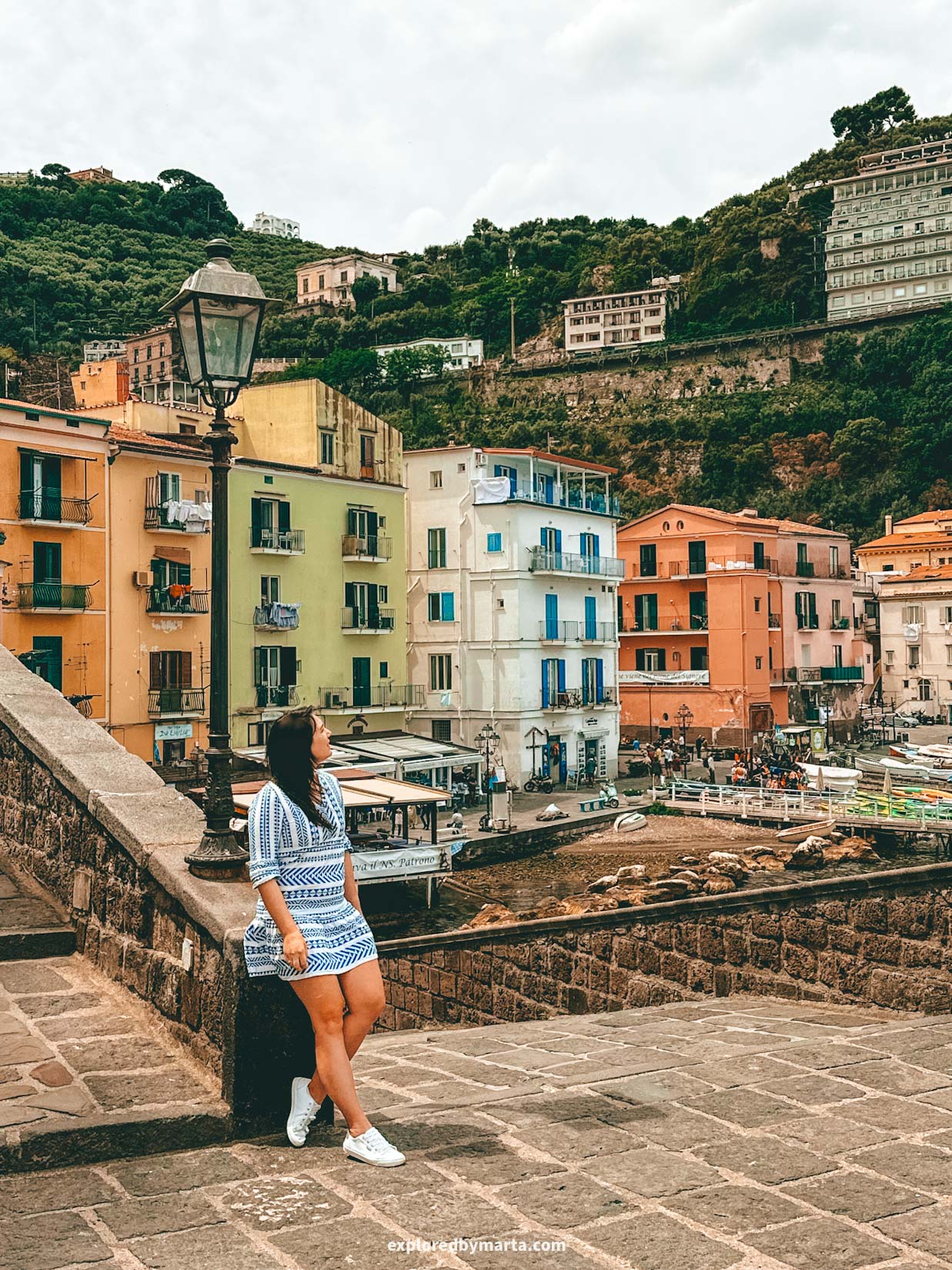
There is another marina that stole my heart – Marina Grande in Sorrento! If you’re visiting or staying in Sorrento, this is a must-visit place!
Marina Grande is a small fishing village adjacent to Sorrento and is known for its relaxed atmosphere, free sandy beach, seaside restaurants, as well as colorful houses lining the shore.
The scenic views, the charming vibes – all of this makes Marina Grande one of the most picturesque places on the peninsula! We spent over a week exploring Sorrento and kept coming back here again and again.
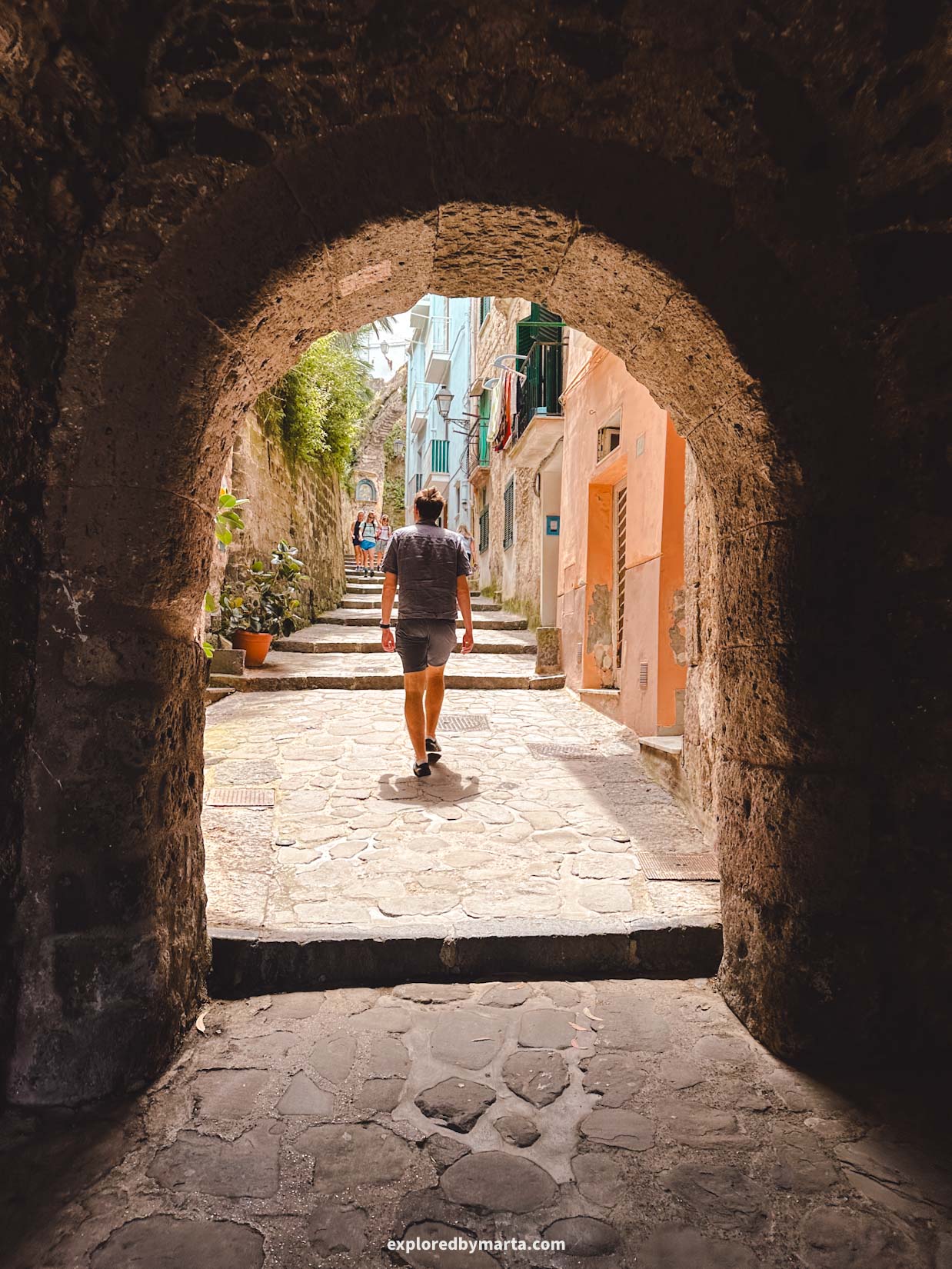
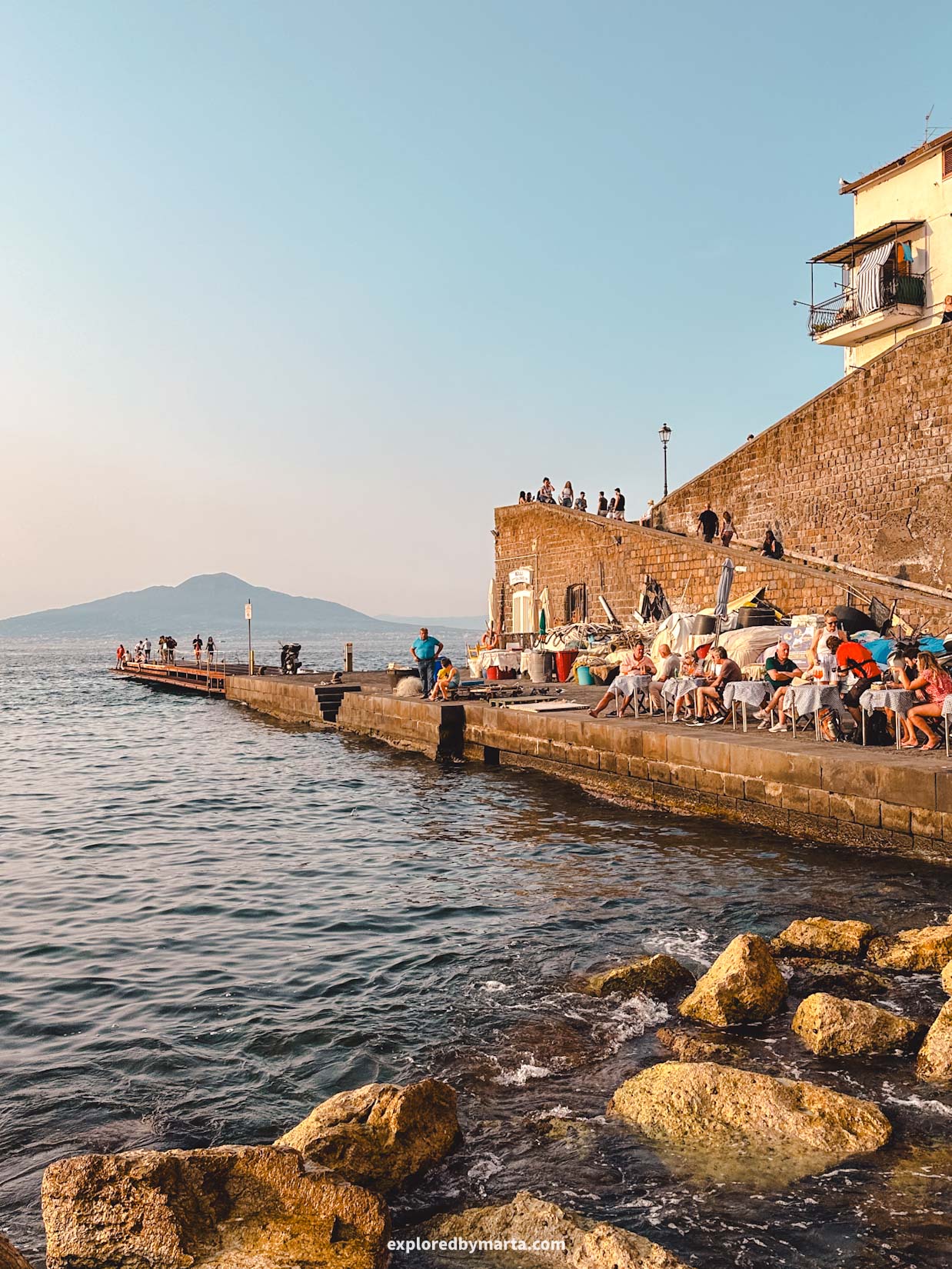
My favorite place? Definitely the stairs on Via Marina Grande right by the sea, where you can see the whole bay with the prettiest colorful houses in the background (see first photo).
Besides charming fishermen’s boats floating in the water, what I liked most about Marina Grande is that there are plenty of seaside restaurants lining the beach, especially places that won’t break the bank.
We came here for dinner right around sunset time, and it was one of my favorite dinners from our trip. The waves were washing the shore, the sun was setting, and we were sipping wine and eating pasta. Pure bliss.
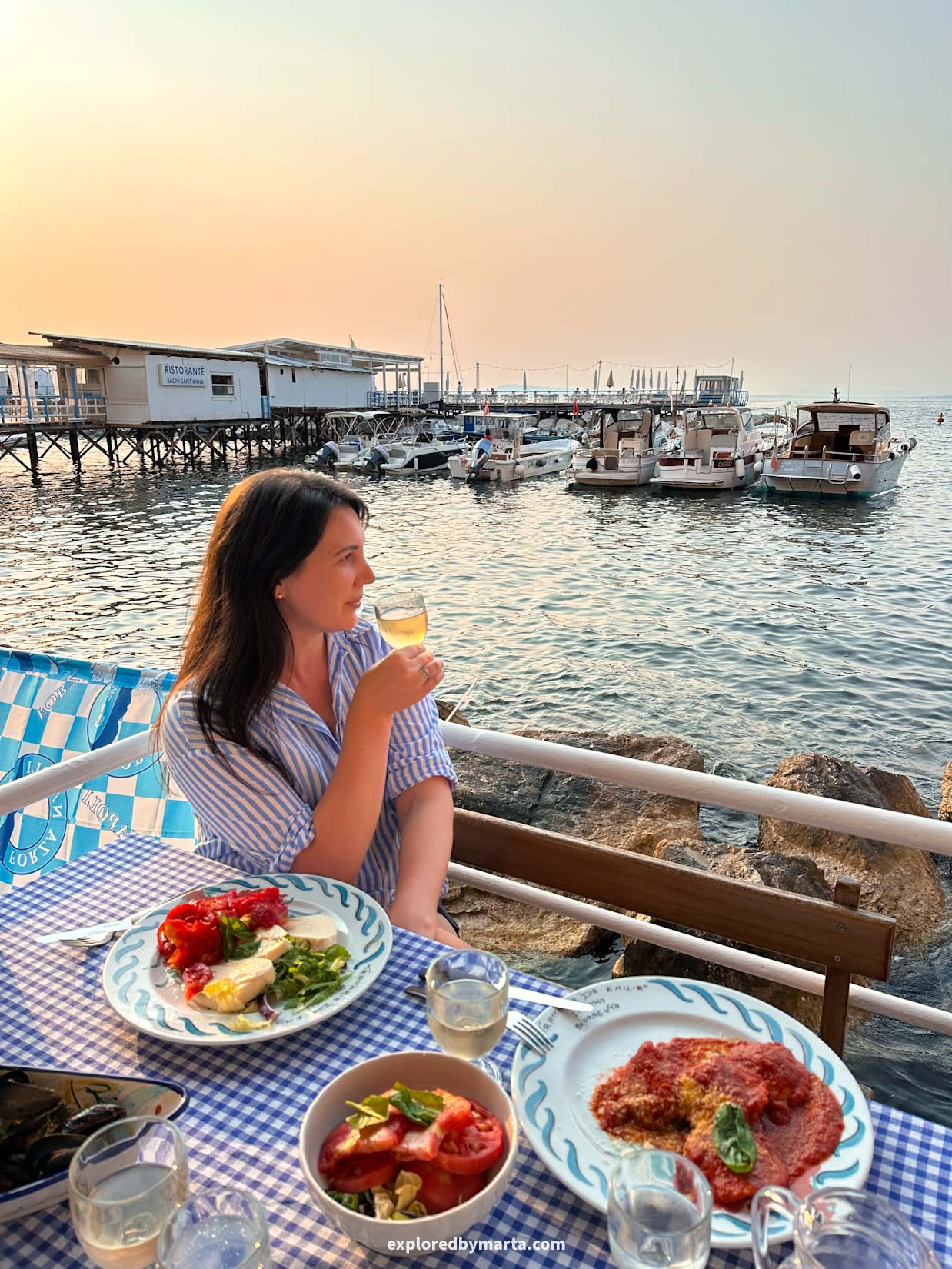
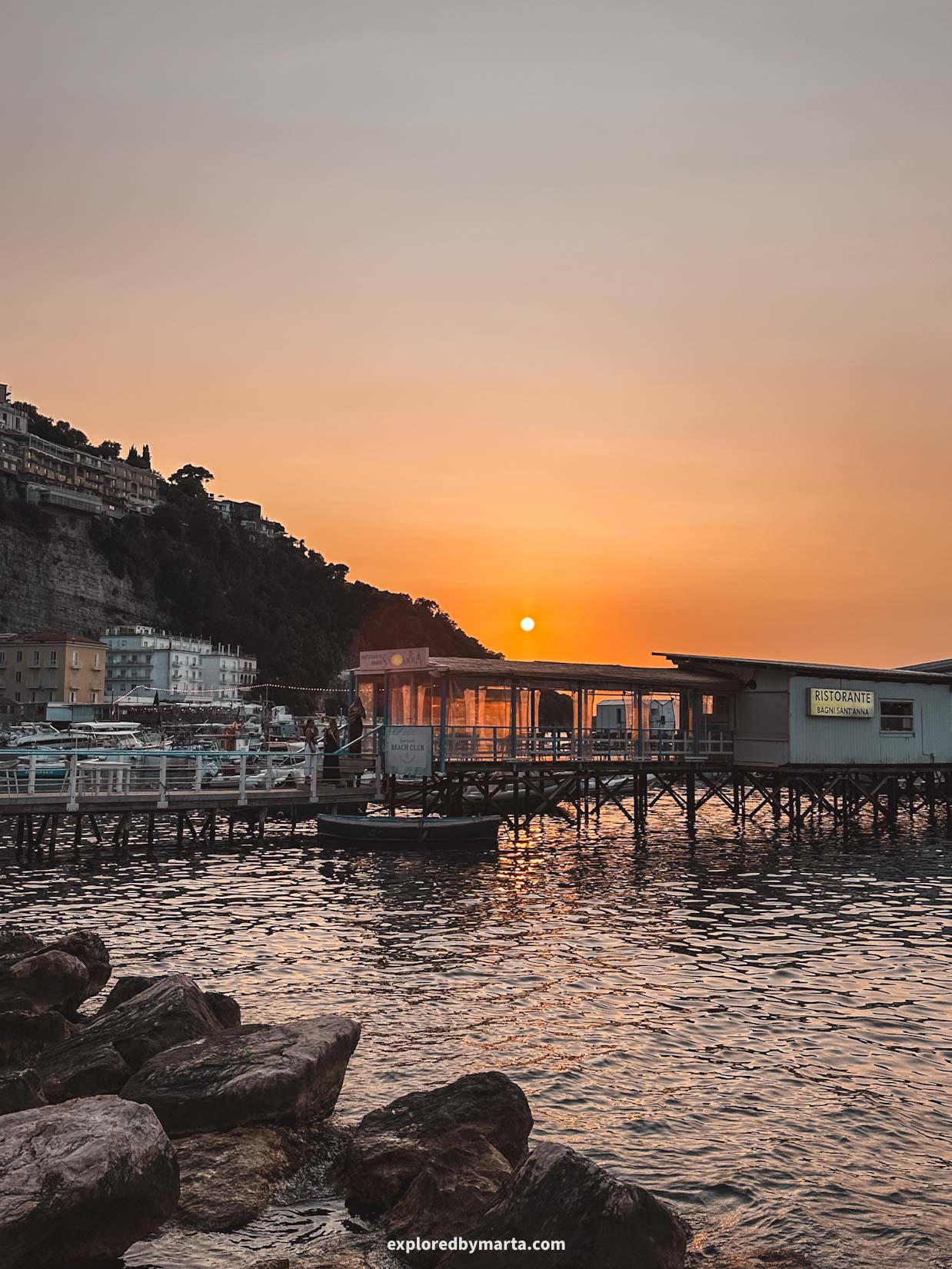
I can’t pinpoint it, but this place just feels really special.
It’s just the quintessential Italian postcard village by the Mediterranean Sea. There is nothing world-famous to see here, but you definitely don’t need that for a place to be absolutely wonderful.
So, in case you find yourself wandering around Sorrento, head straight to Marina Grande. It’s a special place to be with some of the most beautiful postcard views you will find on the coast!
Location: Marina Grande
25. Villa Comunale di Sorrento
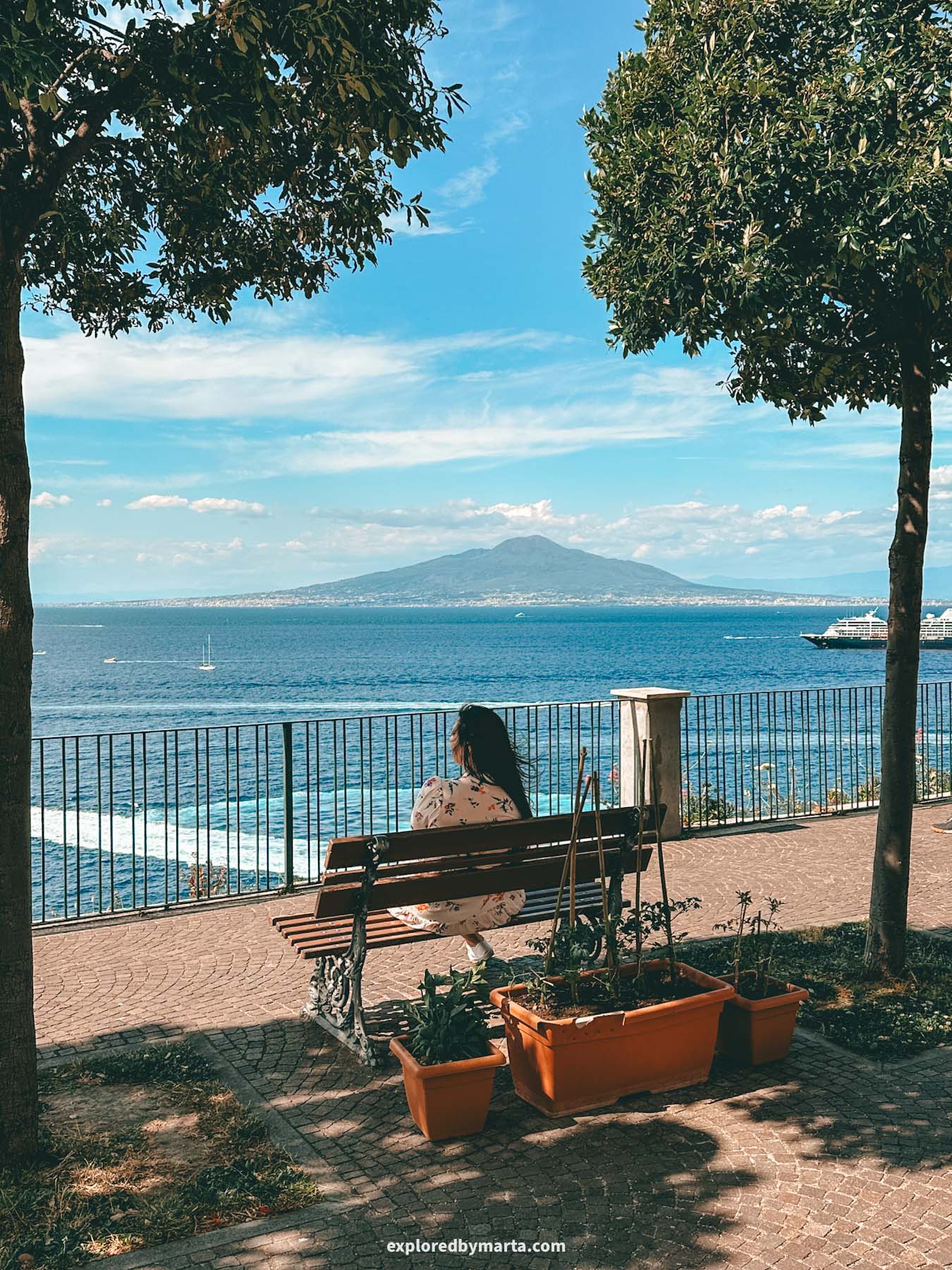
Talking about postcard views…I’m not done with Sorrento. Marina Grande might be my favorite place in Sorrento, but there are definitely some more beautiful spots worth visiting!
For example, one of the most popular places to visit in Sorrento is Villa Comunale di Sorrento. This fantastic 19th-century seaside garden is often referred to as ‘the balcony of the city.’
Once you arrive there, you’ll understand why!

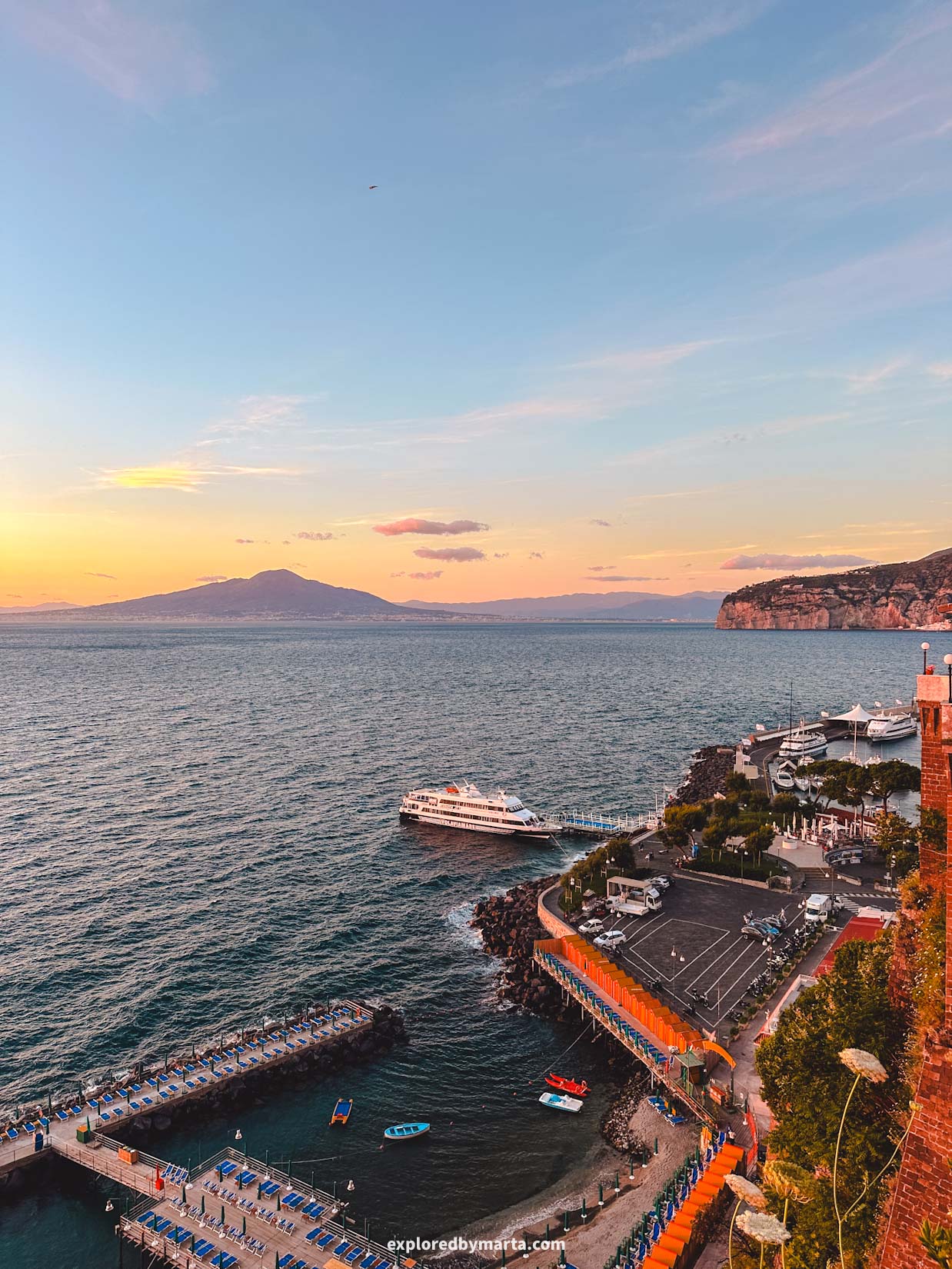
Sorrento sits on a high seaside cliff, and Villa Comunale di Sorrento public park is located right by the cliffside, offering sweeping views of the Bay of Naples, including the majestic Mount Vesuvius volcano.
We came here both during the day and at sunset to watch the sun slide down the horizon and into the Mediterranean Sea (see photos above!). It was magical both during the day and at sunset.
The views from this place are simply unbeatable! However, if Villa Comunale di Sorrento is too crowded, try checking out Piazza della Vittoria right nearby. It’s another charming seaside park and might be less busy!
Location: Villa Comunale di Sorrento
26. The unique Paper Museum in Amalfi


The town of Amalfi has a centuries-old paper-making tradition, and Museo della Carta, or Paper Museum, is the best place to go to experience and learn everything about this unique industry.
The museum, as well as a gift shop, is housed inside a 13th-century paper mill where you can join guided tours through the old mill or simply buy some gifts made of Amalfi’s very own paper (like notebooks, vintage writing tools, wallpapers, etc.).


I didn’t know what to expect from this place and only went there for the sake of this blog, however, it turned out to be a very interactive and interesting visit!
We managed to be the only ones, so we got a private tour through the paper mill.
They showed us all the original machines (and even turned on one of the mill machines), how the paper was dried, pressed, and even let us make a paper sheet.


Amalfi town is located at the bottom of a valley with a river running through the town (today the river goes under the main street!). Thanks to the river, Amalfi’s paper industry could expand. There were numerous paper mills operating in the town throughout the centuries.
Today they only make paper ‘for fun’ – to preserve the legacy and to make unique souvenirs for tourists. Back in those days, every paper had its name, and the one made in Amalfi was called carta bambagina.
The tour lasted about 30 to 40 minutes. After that, you can explore the gift shop and buy Amalfi paper souvenirs like notebooks or paper art. Overall, I really enjoyed this tour around the museum. It’s located just a short walk from Piazza Duomo, so do check it out!
Location: Museo della Carta
27. Church of San Gennaro in Praiano
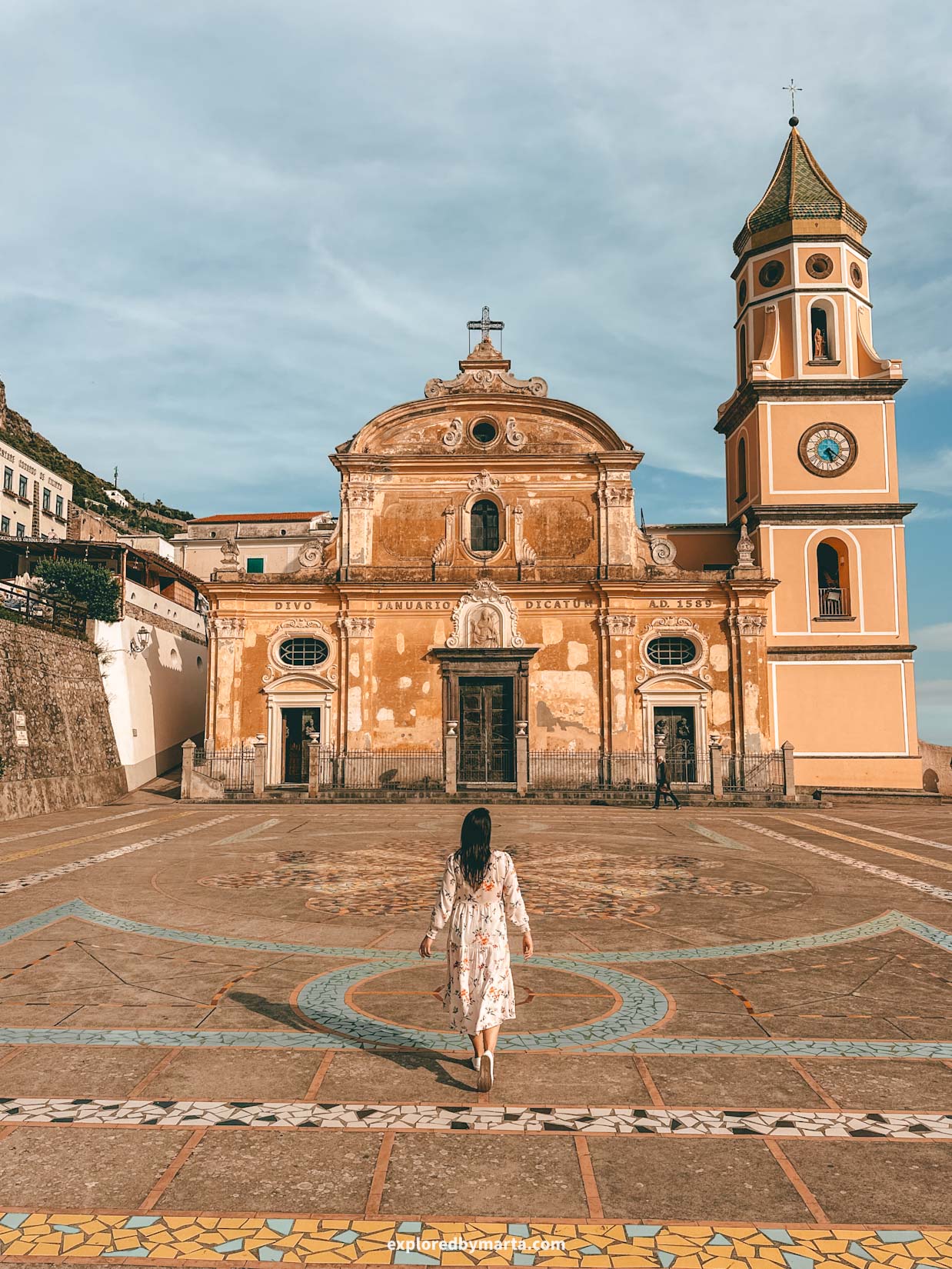
Praiano is a village built on the slopes of a mountain, which means that there’s an abundance of scenic spots around the village offering panoramic views of the Amalfi Coast.
Piazza San Gennaro, next to the majestic Church of San Gennaro, is definitely one of those places.
This square, decorated with beautiful mosaics of majolica tiles, is the most central location in Praiano. This is where all life happens in the village!
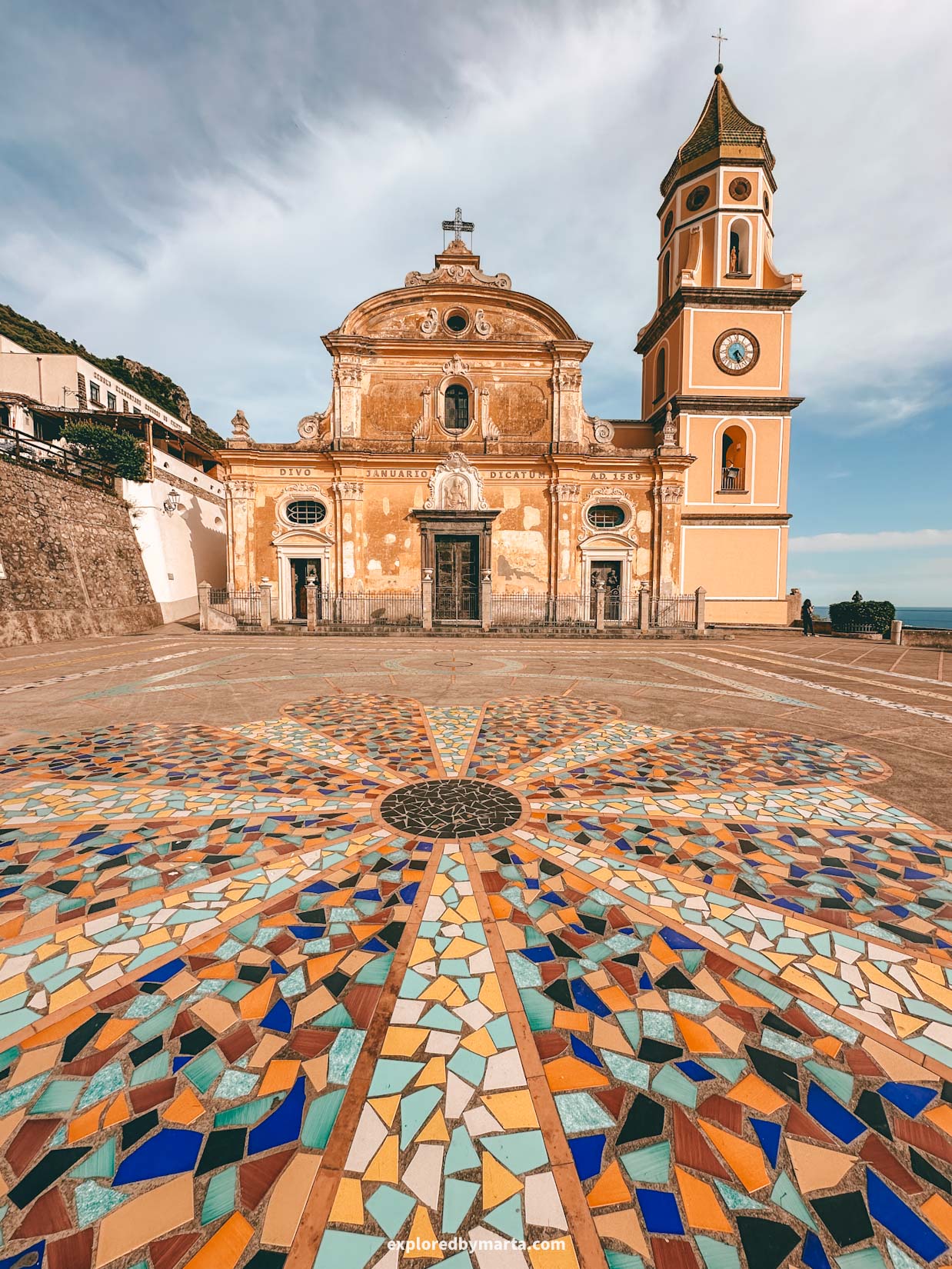
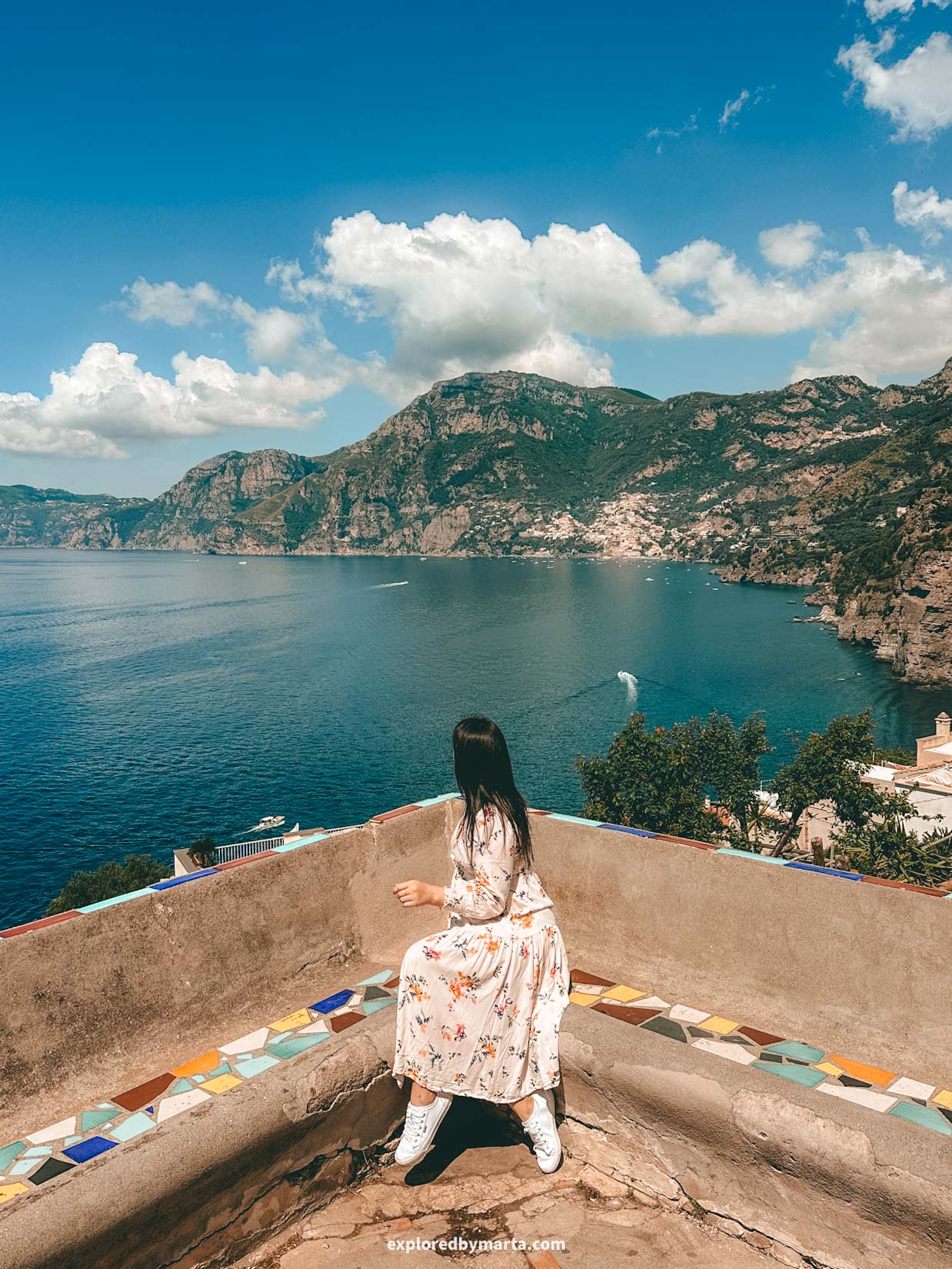
The beautiful square is a popular hangout place for locals and tourists alike, and it offers some of the most panoramic views of the Amalfi Coast. You can easily see Positano and the rest of the coastline from here!
While you’re there, I highly recommend peeking inside the beautiful yellow San Gennaro church! The visit is free, and the church is usually open during the day.
Built on the remains of an old 14th-century church, the building, as we see it today, was constructed and finished back in 1602. The church stands out with its shining majolica dome covered with blue and yellow tiles, which represent the sun and the sea.
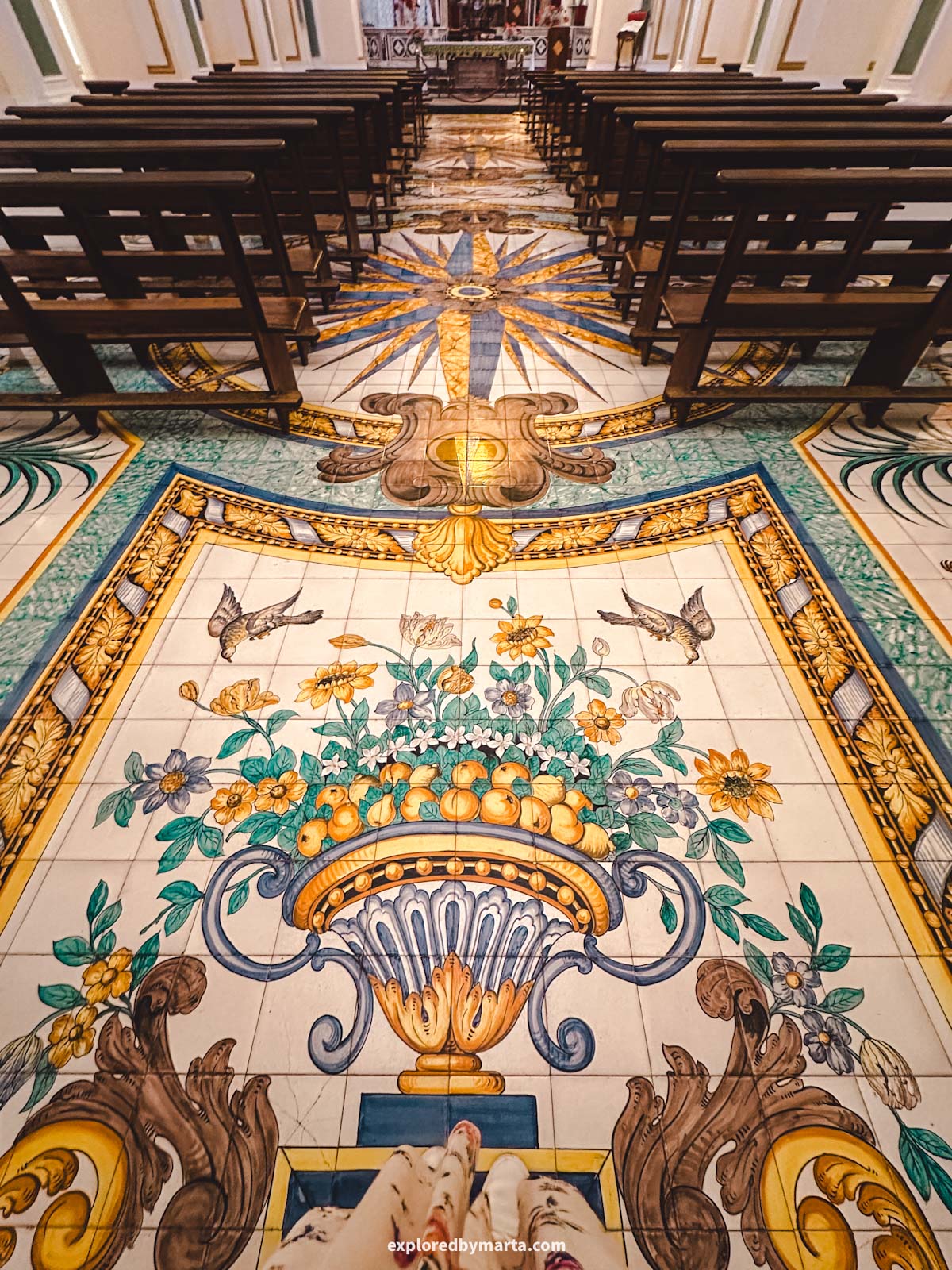
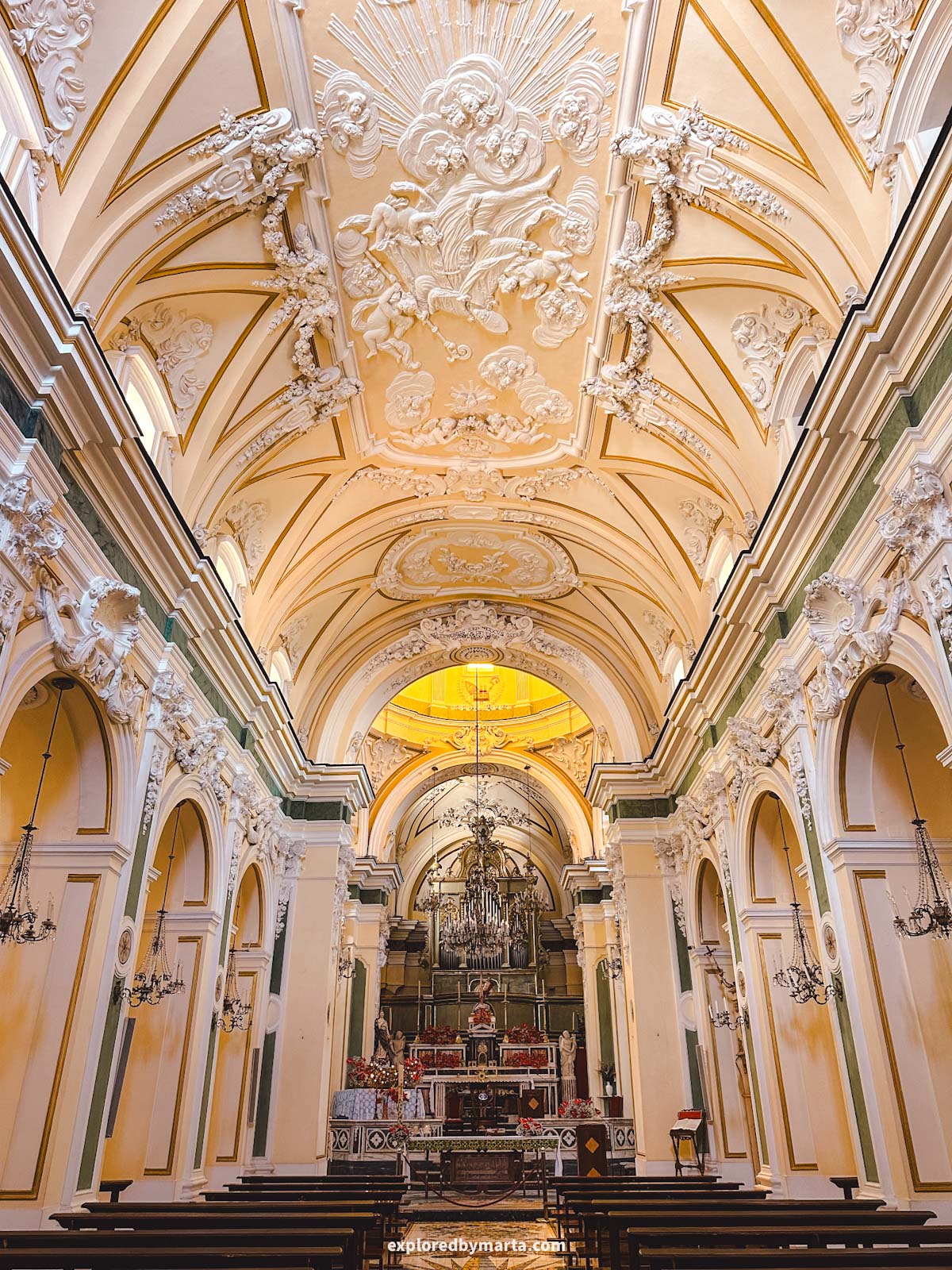
However, the true wonders can be found inside the church! The main nave is beautifully made in a classic Baroque style and painted in yellow and while with green design elements. We spent a few minutes admiring the interior!
But my favorite thing about this church was the floor! It is covered with beautifully painted, colorful ceramic tiles. No surprise there! We are on the Amalfi Coast after all! If the church is open, go take a look inside!
We visited churches in every village and town on the Amalfi Coast, and this was the only church I saw with the whole floor covered with beautifully painted ceramic tiles. So this is a pretty special place, if you ask me!
Location: Chiesa Parrocchiale di San Gennaro
28. Duomo di Salerno and crypt of Matthew the Apostle
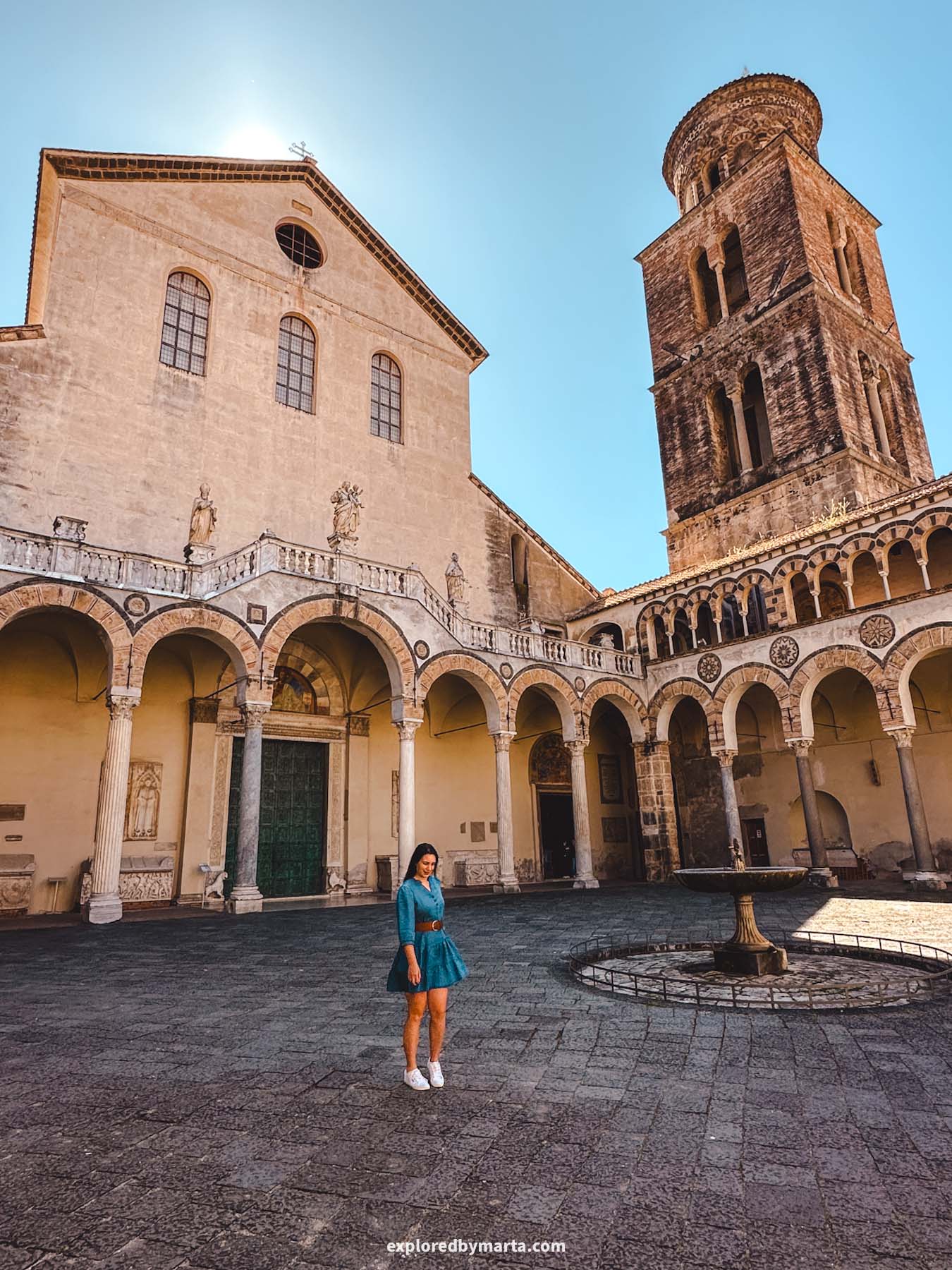
While everyone is obsessing over the famous Amalfi Cathedral, there is another majestic cathedral in the area – in Salerno! I know some travelers choose Salerno as their base for their travels, so if you are one of them, do pay a visit to this marvel!
Duomo di Salerno, or Cathedral of Salerno, is a true masterpiece and was my favorite landmark in the city!
Built in the 11th century, the cathedral has become one of the most important pilgrimage destinations in the world. And for good reason – the remains of Saint Matthew, one of the Twelve Apostles, are buried in its crypt.
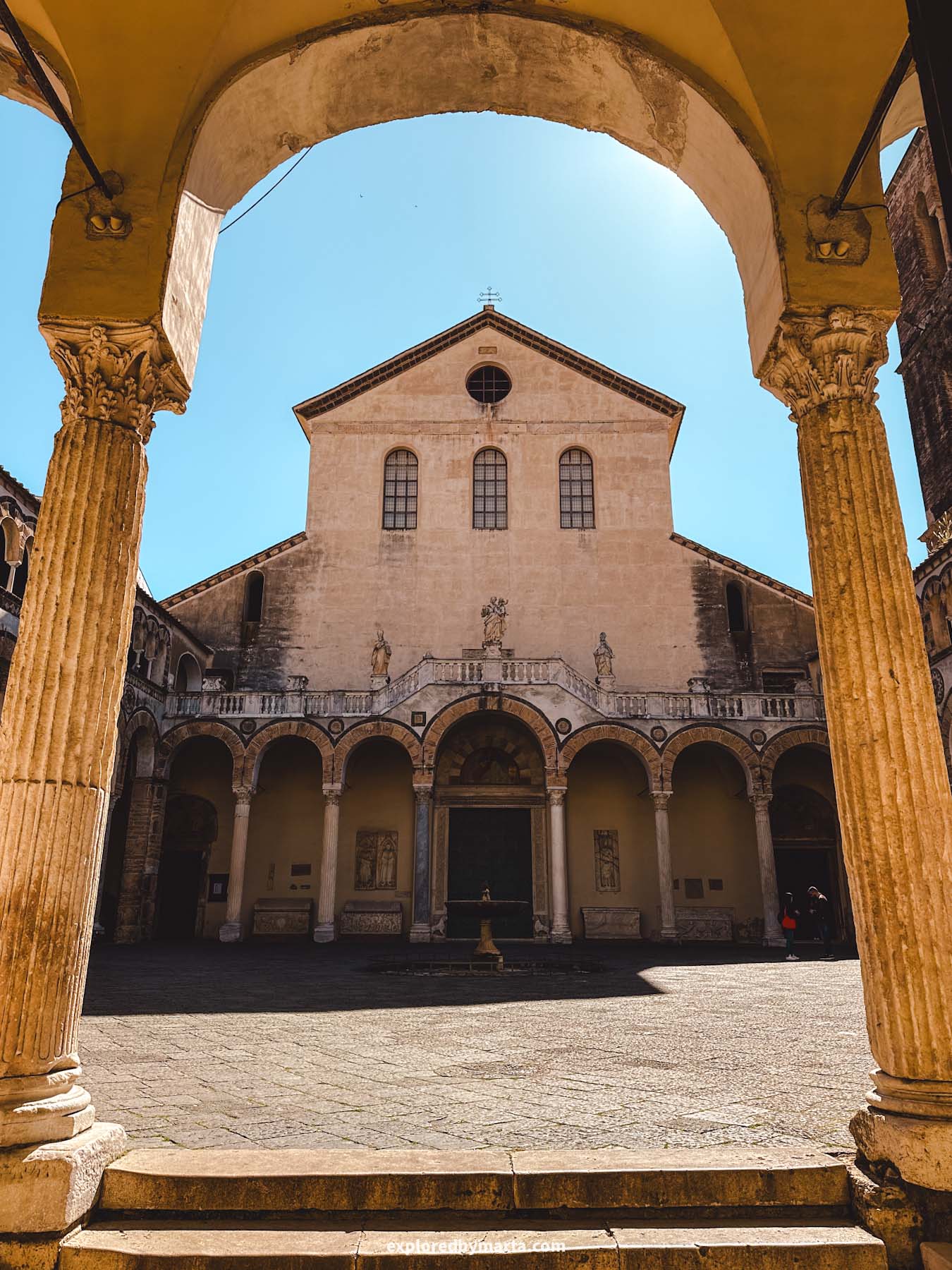
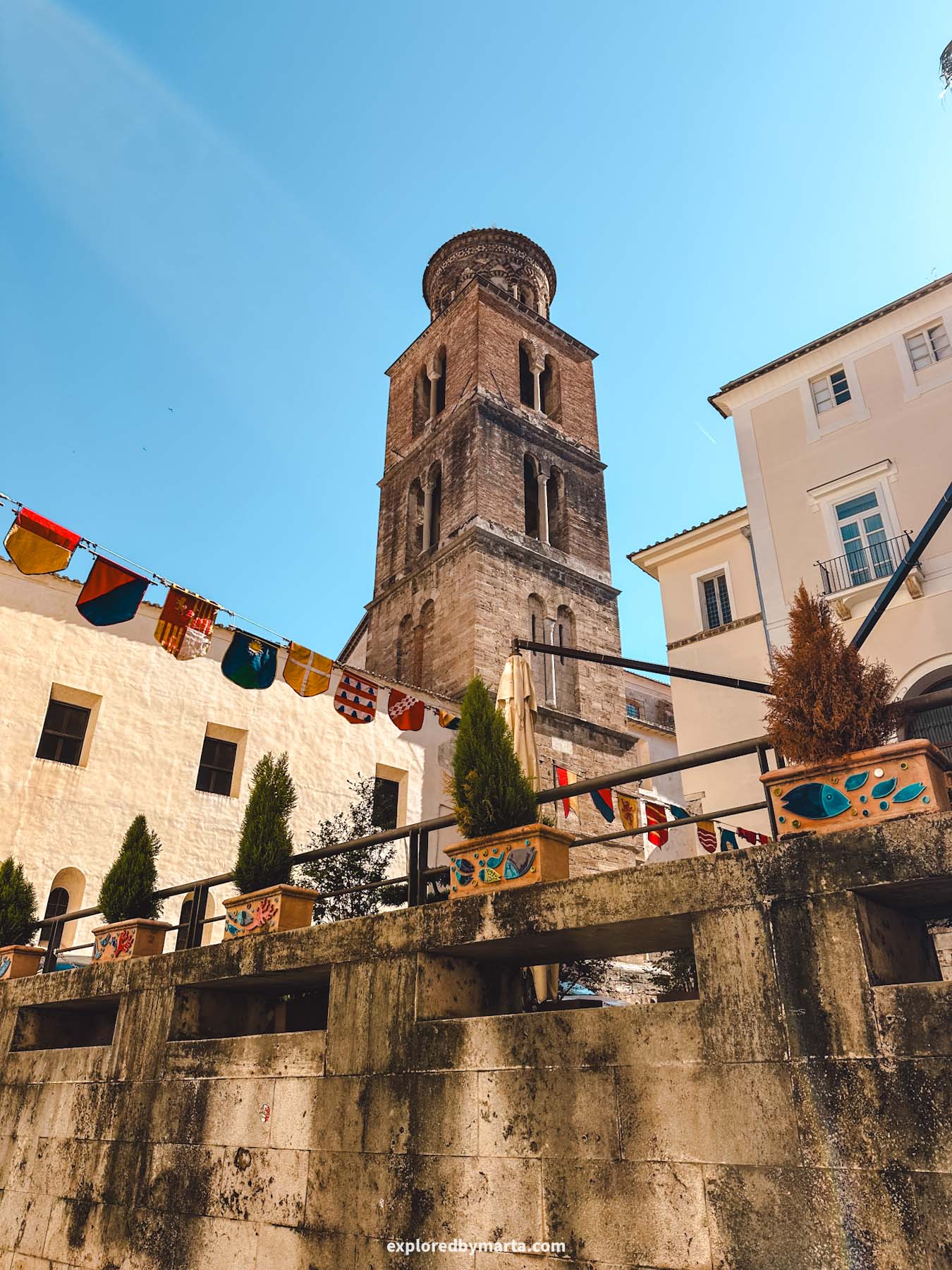
Saint Matthew’s crypt in Salerno is considered one of the most beautiful crypts in all of Italy! It is lavishly decorated with gilded columns, frescoes, and marble.
But the crypt isn’t the only reason to visit. The cathedral also features a striking 12th-century bell tower that pierces Salerno’s skyline and a beautiful courtyard lined with Roman columns.
Inside the cathedral, you’ll find a grand nave, impressive frescoes, artworks, and a Baroque-style ceiling. But the richly decorated altar is the central element inside the cathedral.


We spent quite some time walking around the crypt, admiring its marble busts, gilded columns, and stunning frescoes. The crypt was renovated in the 17th century in Baroque style, and you can definitely tell they didn’t hold back!
While you can visit the church’s courtyard for free during working hours, you need to purchase a ticket to visit the interior of the cathedral and the crypt.
While the interior of the cathedral was not as impressive as I thought it would be, the crypt truly took my breath away, and is definitely worth the entrance fee!
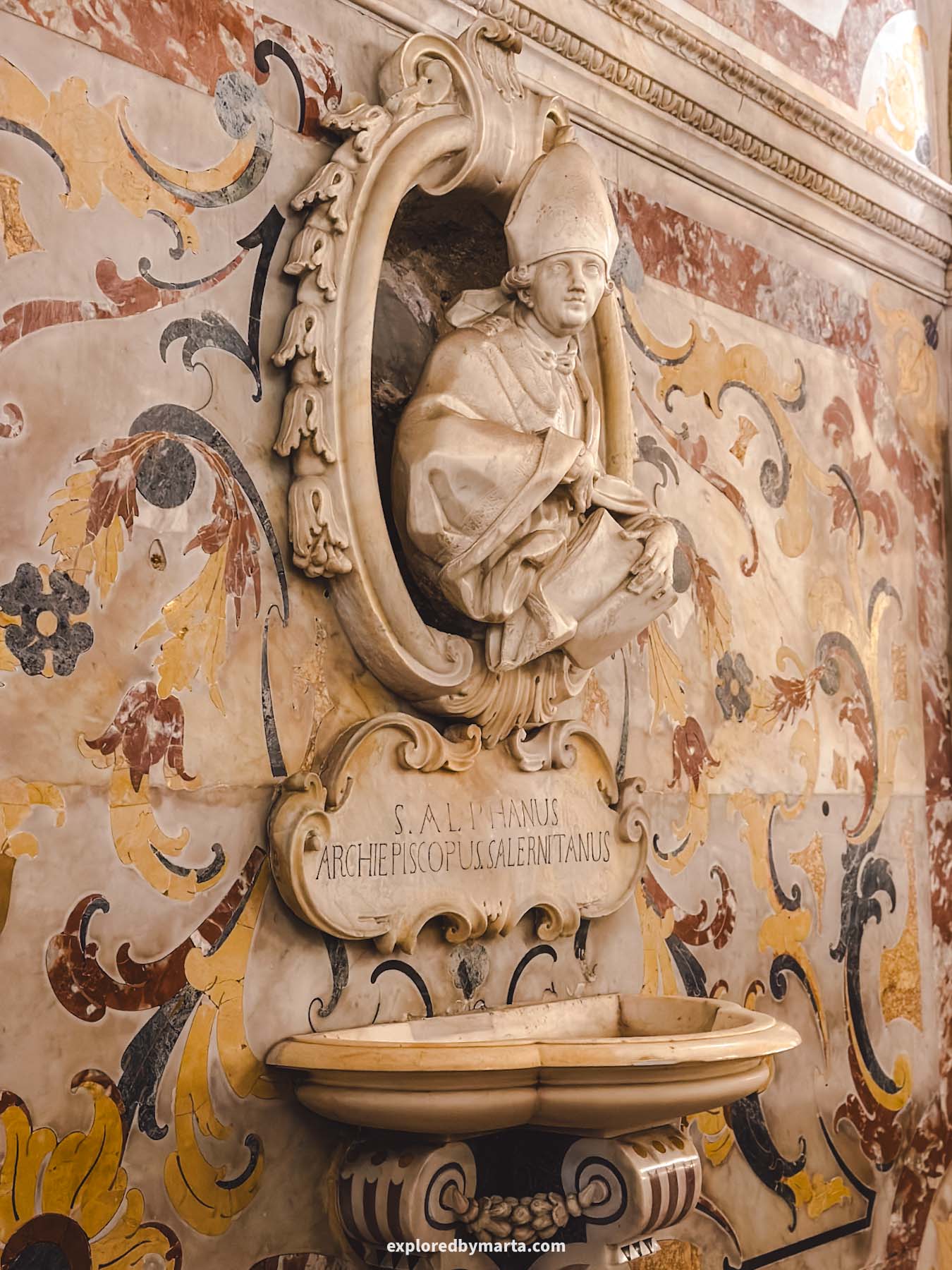

But there’s more to visiting the cathedral. At the ticket office, we were offered a full ticket that also included entry to Salerno’s Diocesan Museum of San Matteo and entry to the Church of St. George.
We visited both of these bonus spots. While the museum felt a bit dull (unless you’re really into religious artifacts and paintings), the Church of St. George was absolutely jaw-dropping (see photos below). And it is located just a stone’s throw from the cathedral!
The Church of St. George completely surprised us with its breathtaking Baroque interior. Honestly, even the cathedral can’t compete with this absolute marvel!
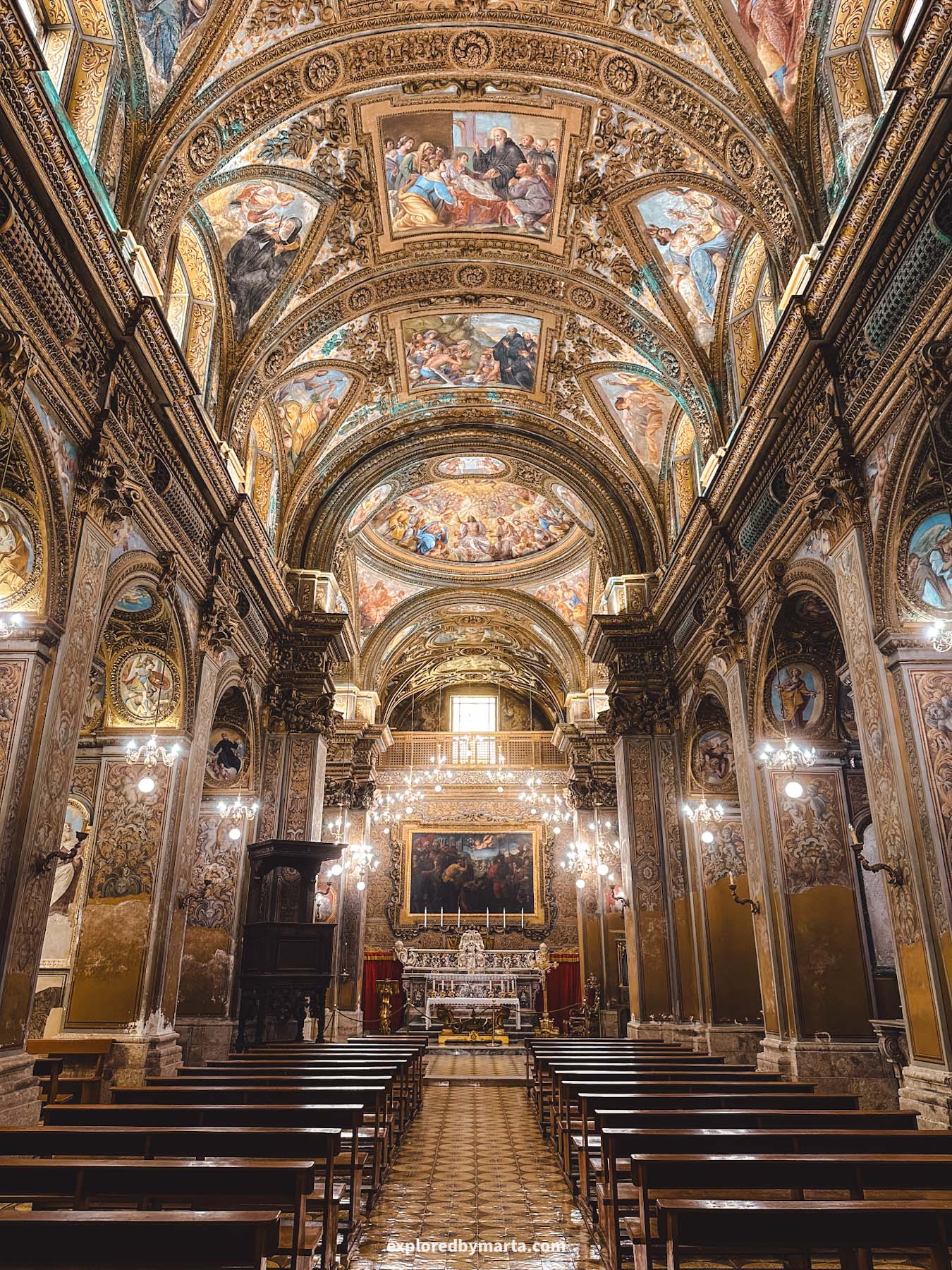
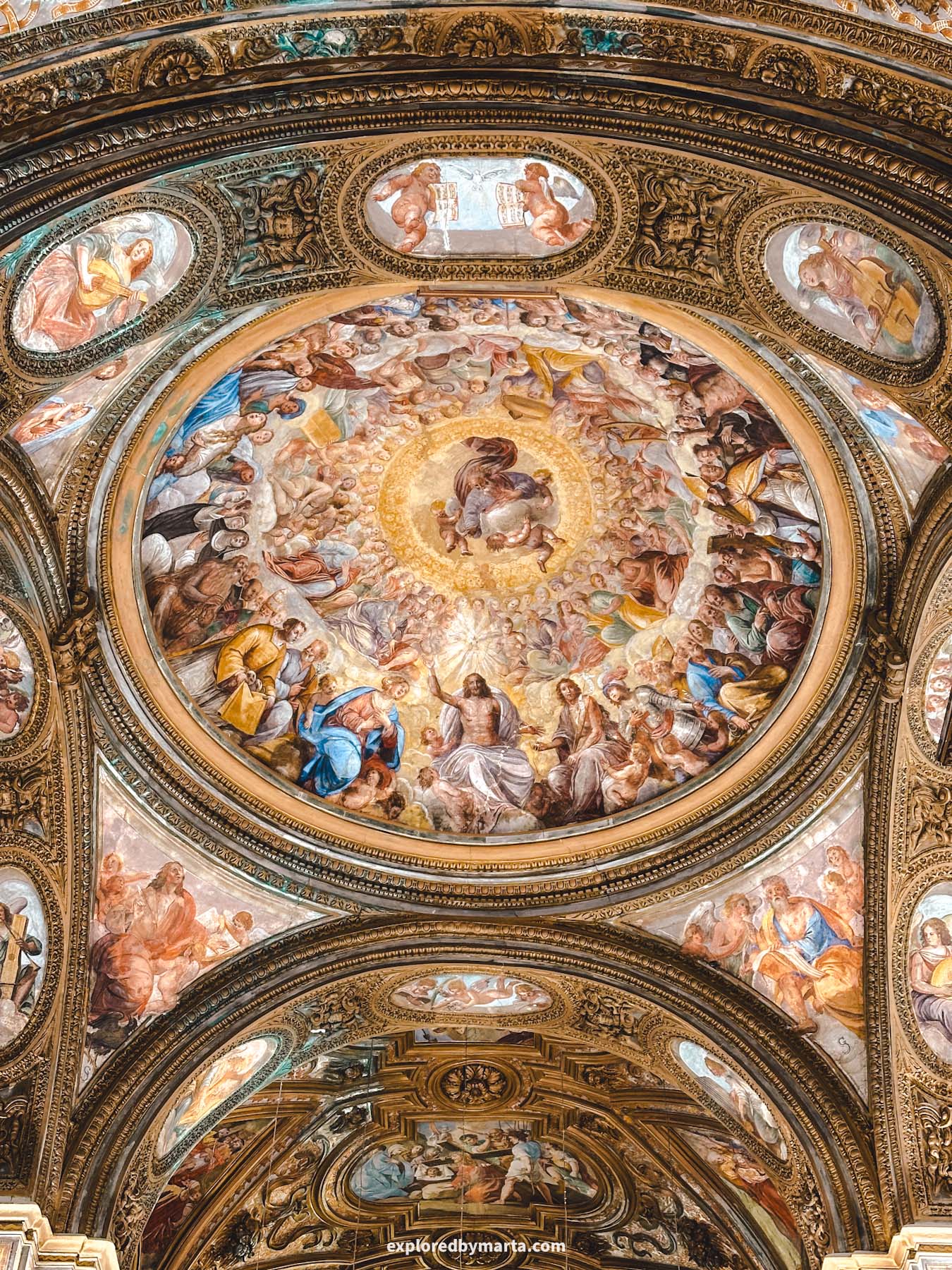
Imagine taking Saint Matthew’s crypt and making it much larger and even more elaborate – that’s the Church of St. George for you!
I had to sit down for a few minutes just to take it all in and truly comprehend the incredible craftsmanship that went into creating such a stunning building.
Originally a Benedictine monastery church, it was built in the early Middle Ages, but much of its magnificent Baroque splendor dates back to the 17th century.
I highly recommend spending those few extra euros to upgrade to the full ticket and setting aside some time to peek into this masterpiece. It’s so worth it!
Location: Duomo di Salerno – Church of St. George
29. Castello di Arechi in Salerno
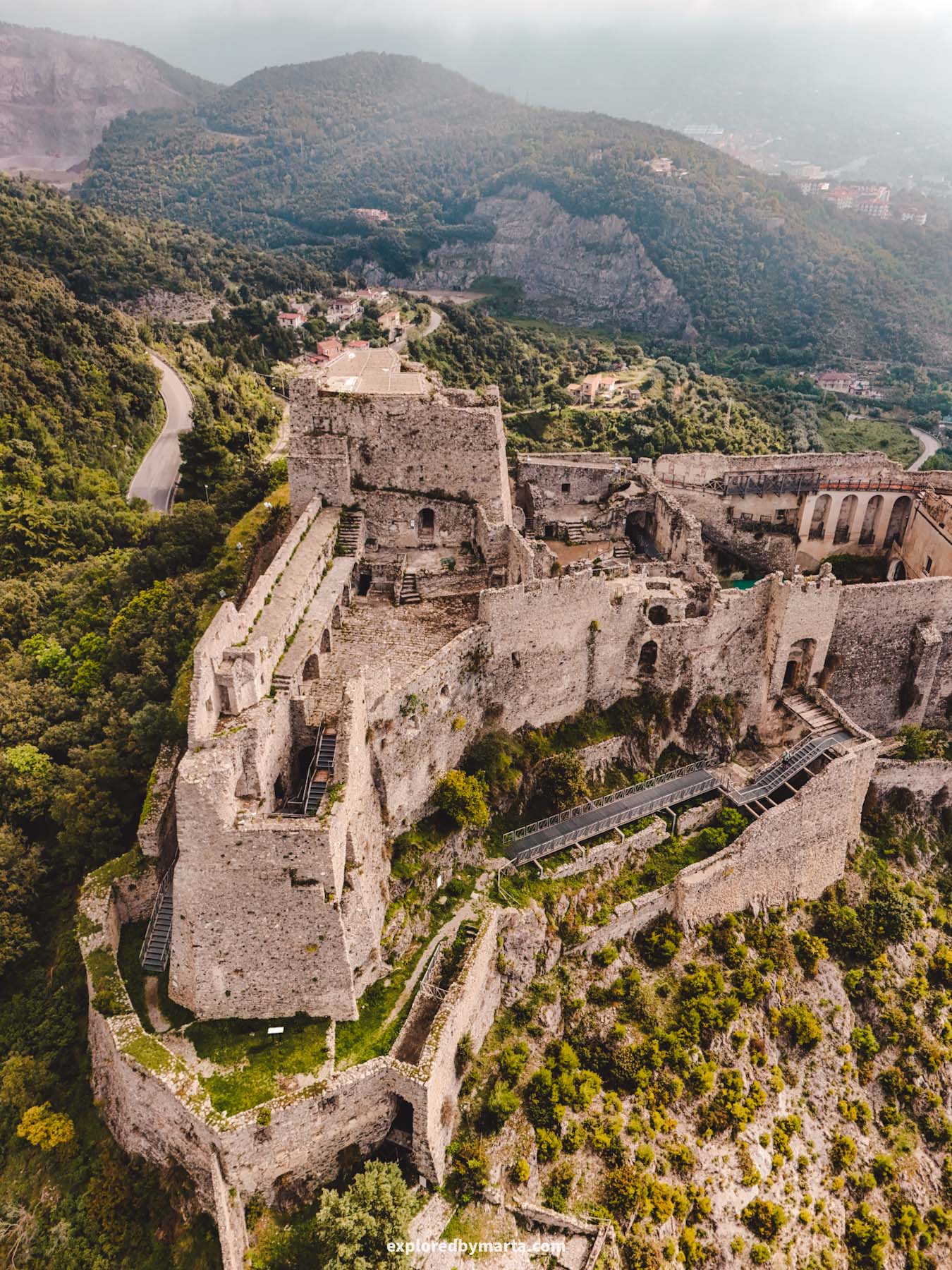

I’m not done with Salerno! Standing about 360 meters above sea level on Mount Bonadies, next to Salerno, is Castello di Arechi, or Arechi Castle, one of the most significant historical landmarks in the region.
The oldest parts of this medieval fortress date back as far as the 6th century, although most of the structure was built over the following centuries.
Castello di Arechi was one of my favorite places we visited in Salerno. Not only is it a great spot to explore historic artifacts, but it also offers panoramic views of the Amalfi Coast, Salerno, and the Gulf of Salerno.

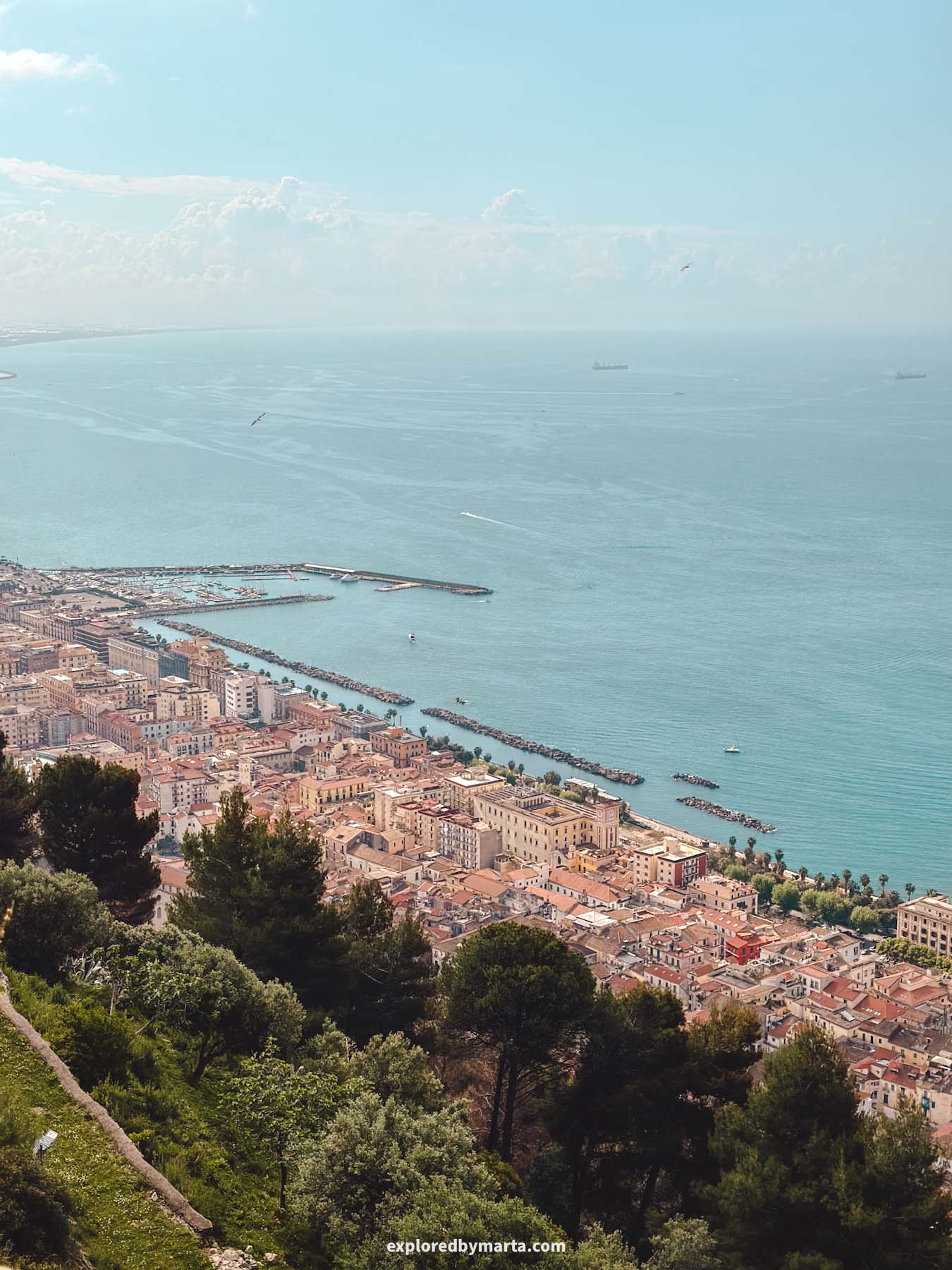
The castle is surrounded by a lush forest, making the visit a peaceful walk filled with fresh air and stunning scenery. I highly recommend adding this hidden medieval gem to your itinerary if you are staying somewhere nearby!
You can reach the castle by hiking, though it’s a steep and challenging climb from Salerno, or by car (there’s parking available near the entrance), taxi, or bus. A regular bus route goes directly from Salerno to the castle.
The best part? You can explore the outside of the castle for free.
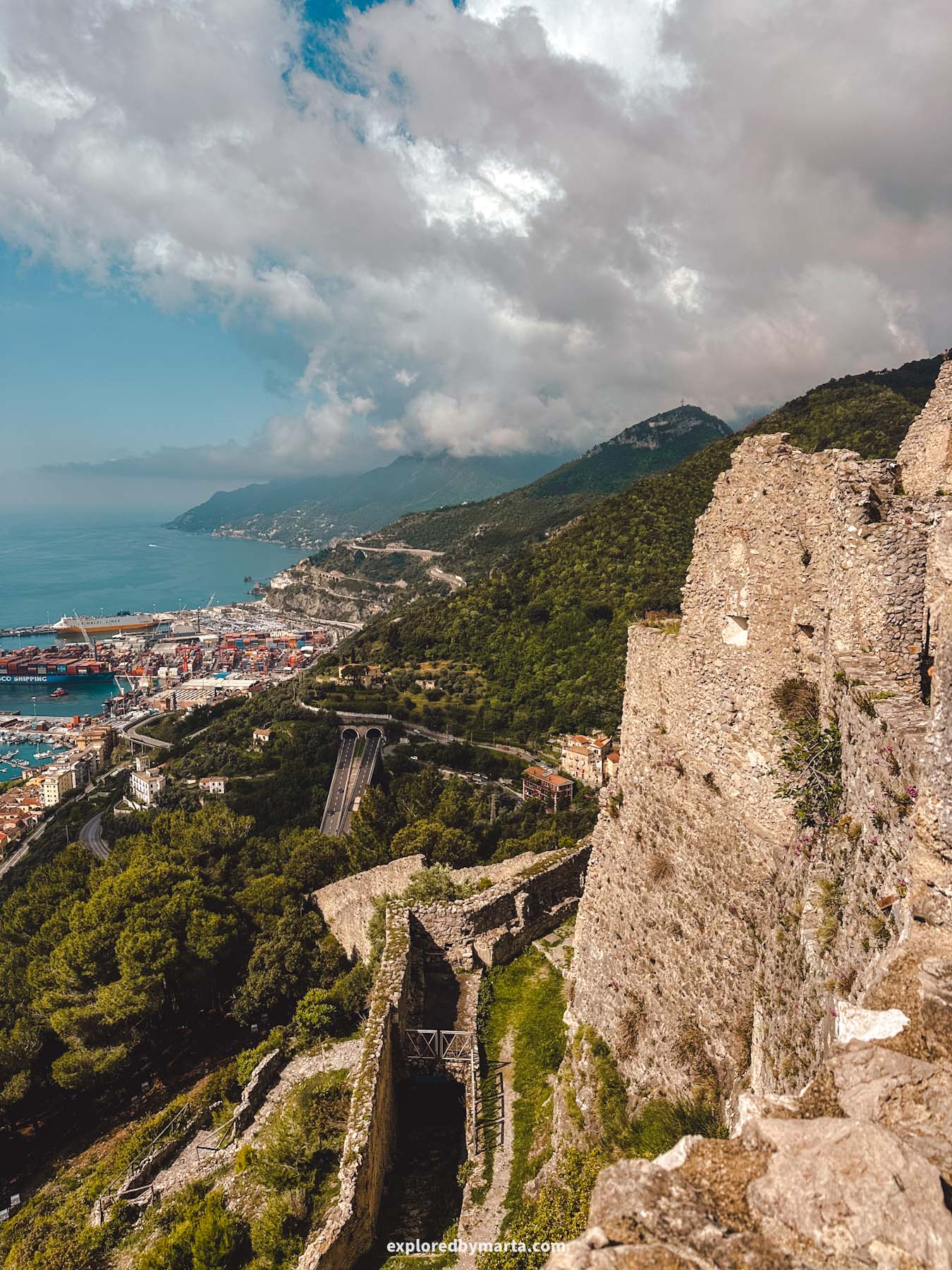

If you’d like to see the interior, there’s a small entrance fee. Inside, you’ll find a museum showcasing artifacts such as coins, tools, and other historical items found in the castle and its surrounding area.
The castle is named after Arechi II, a Lombard prince, but over the centuries, it was occupied by various groups – including the Byzantines, Normans, Aragonese, and others – each leaving their mark on the structure and its defenses.
We loved exploring the castle! On a clear day, you can see the whole Sorrento Peninsula and its mountains. We had some clouds on the day we visited, but the views were beautiful either way.
Location: Castello di Arechi
30. Ancient Greek temples in Paestum

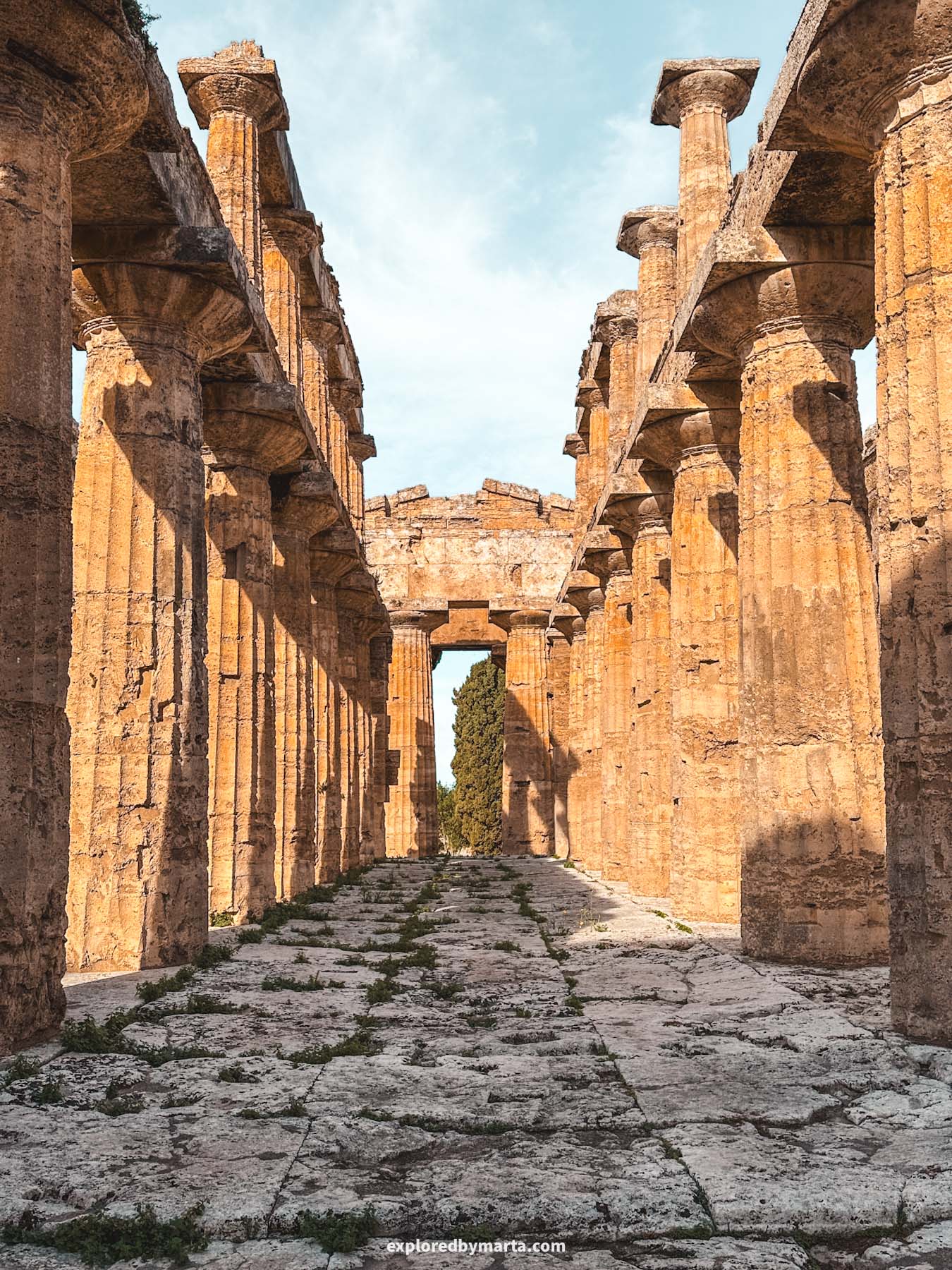
For those of you who rent a car, I cannot recommend this place enough! While every tourist visits Pompeii, this absolute hidden marvel in Paestum, less than an hour’s drive from Salerno, truly took my breath away!
So, what’s special about this place?
The area around the Mediterranean Sea is often referred to as the cradle of Western civilization. The sea connected civilizations from Europe, Asia, and Africa, allowing ancient empires to thrive and develop at a rapid pace.
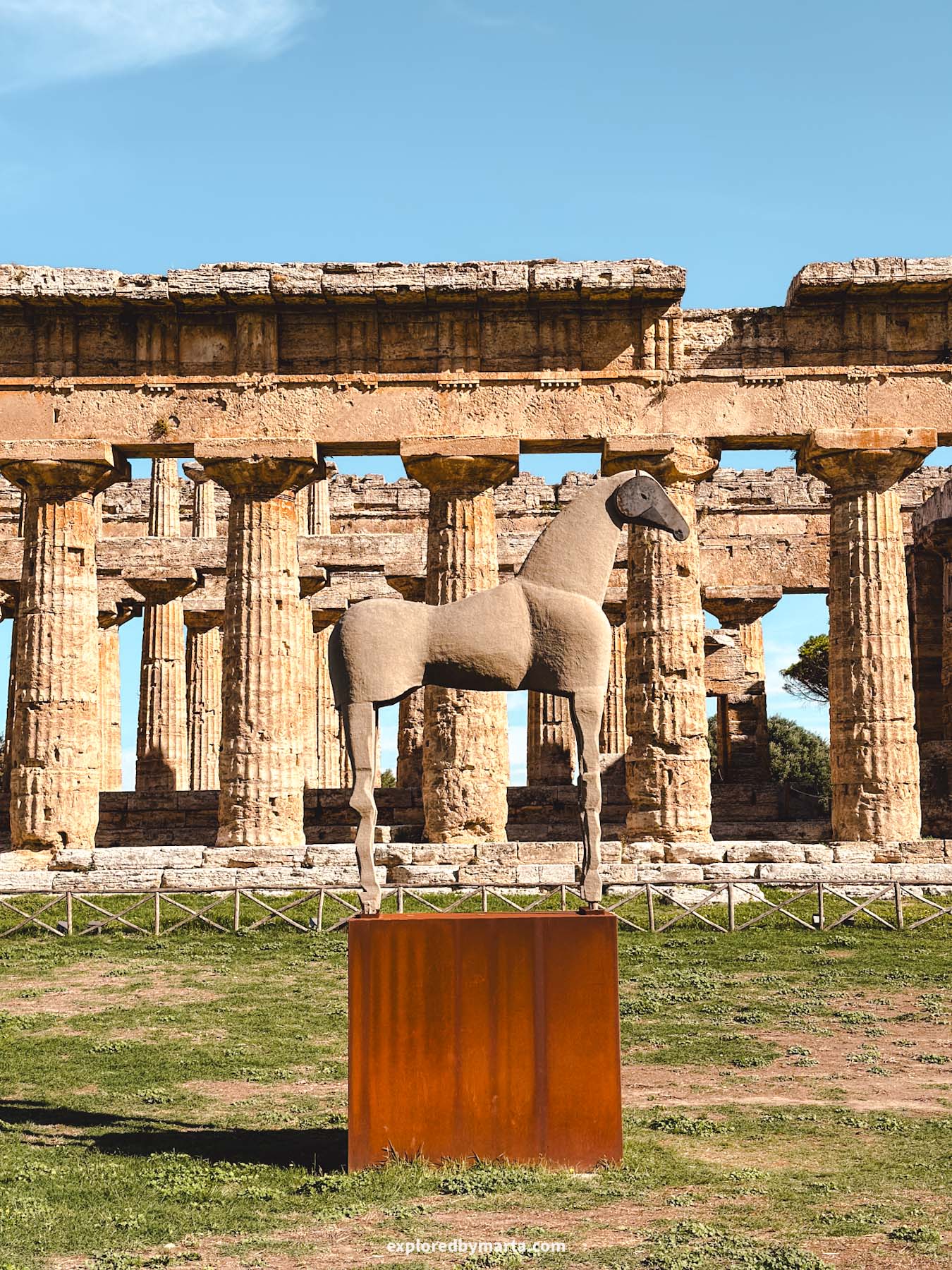

This also meant that territories around the Mediterranean changed rulers many times throughout the centuries. As one empire fell, another rose and continued building and developing the cities.
As a result, in many Mediterranean countries today, you can still see historic landmarks left behind by different civilizations.
In the case of Salerno, there’s an ancient place called Paestum, where you can see Greek temples over 2,500 years old. And, trust me, this place is absolutely spectacular!

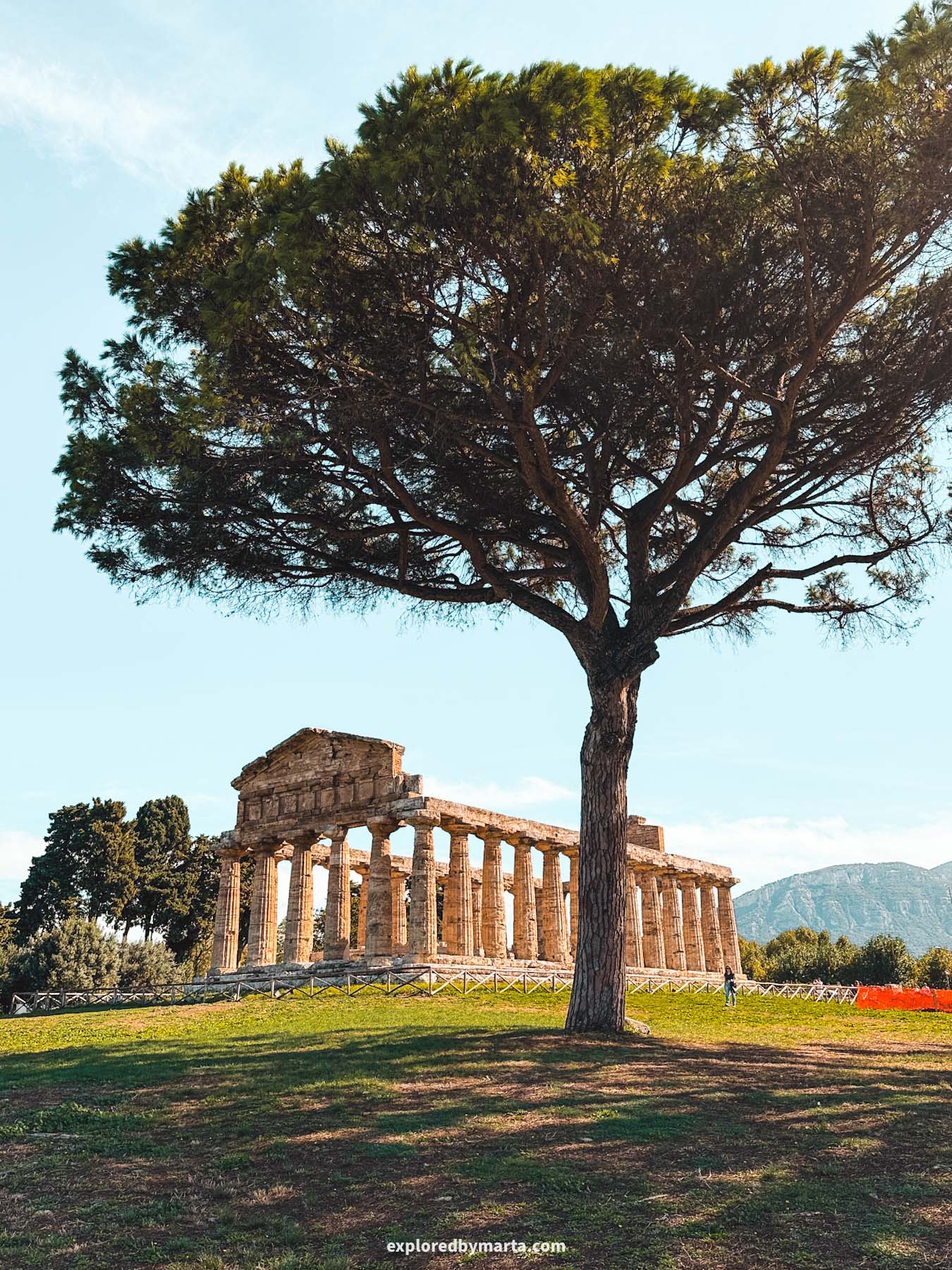
Visiting the Archaeological Park of Paestum was one of my favorite experiences during our travels around the Amalfi Coast.
The massive archaeological site is absolutely jaw-dropping, and, surprisingly, it is one of the lesser-known tourist attractions in the area. If you have a few hours to spare, you need to visit Paestum!
I didn’t expect much to be left of a 2,500-year-old place, but I was so wrong! This ancient UNESCO World Heritage Site is a must-visit place in Southern Italy.

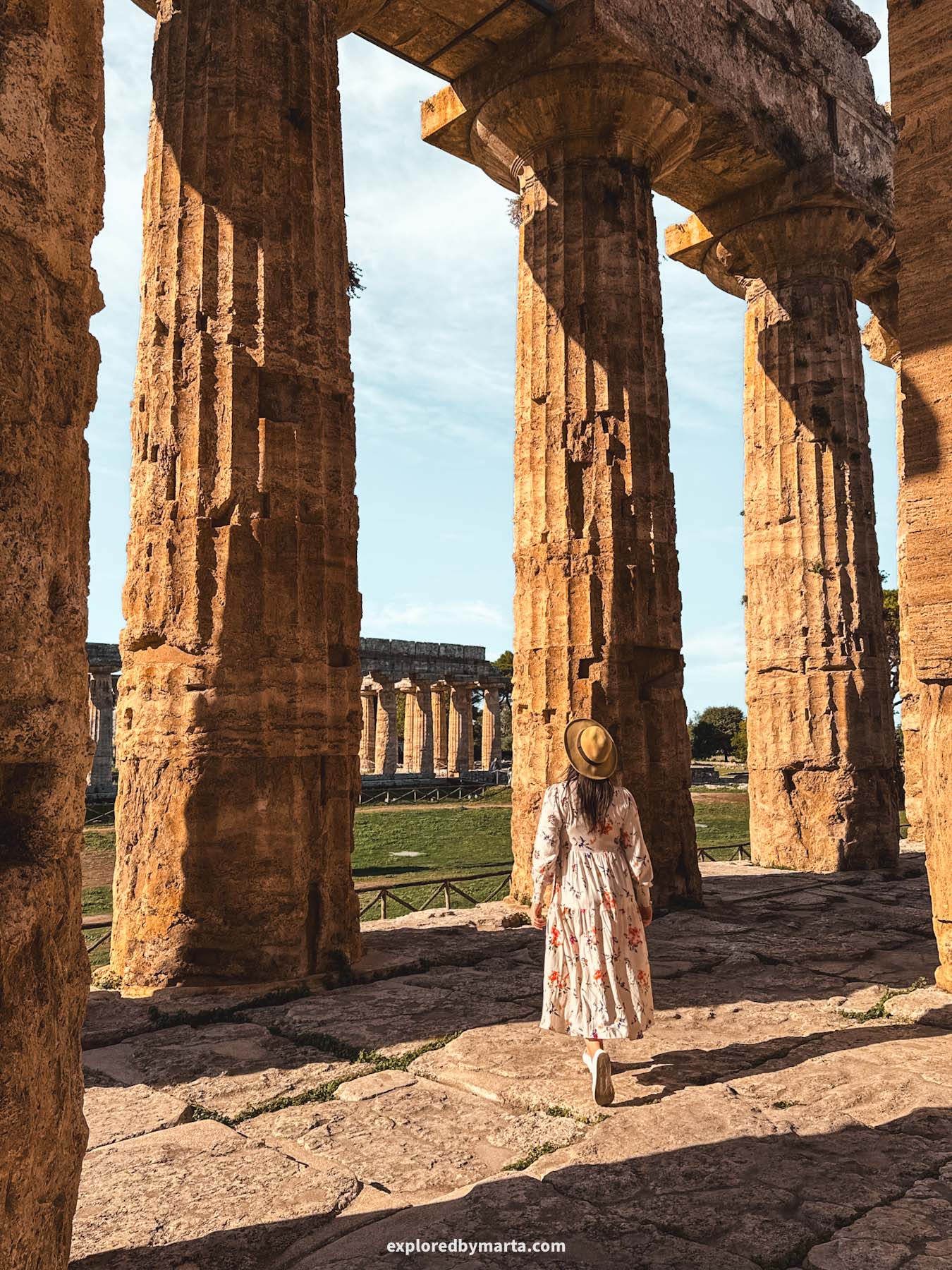
Paestum features multiple large Greek temples dedicated to deities like Hera, Athena, and Poseidon. These are some of the best-preserved Greek temples in the world, even better than many you might find in Greece!
The best part? You can walk inside the temples, touch the columns, and literally step where the ancient Greeks once walked thousands of years ago.
I absolutely loved this place. Honestly, I’d argue that the experience even surpasses visiting the Acropolis in Athens, but you’ll have to judge that for yourself!
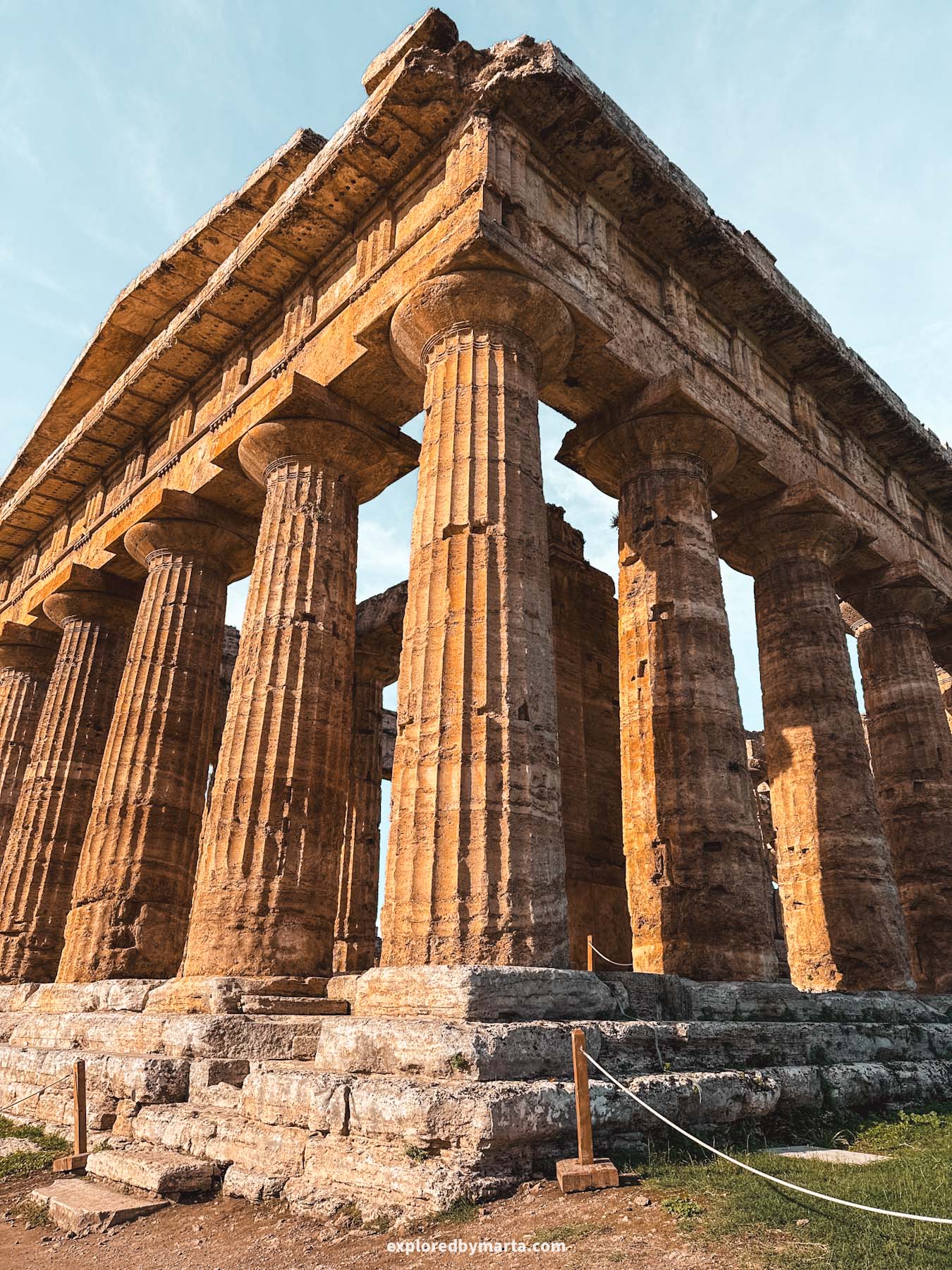

I know that it might feel strange visiting ancient Greek temples while you’re in Italy, but the history of the Mediterranean is deep, diverse, and intertwined. The Greeks did live here, built cities, and left a remarkable mark on this region.
If you’re one of the many history buffs or love sites like Pompeii, the Archaeological Park of Paestum should be high on your list of places to visit in the Campania region of Italy.
I never expected to love this place so much, but I’m quite sure you will completely understand when you see Paestum with your own eyes! It is a true marvel!
Location: Archaeological Park of Paestum
Happy exploring!
The Amalfi Coast, a UNESCO World Heritage Site, is known for its natural beauty, scenic views, and beautiful architecture. I haven’t been everywhere, but it has to be one of the most beautiful places on our planet!
We spent half a year living in and exploring the area on and around the Amalfi Coast. It’s easy to see why this region has drawn everyone from simple fishermen to Roman emperors to its shores for thousands of years.
I hope you find some travel inspiration in this Amalfi Coast guide, and that you enjoy your time on Italy’s Divine Coast as much as we did. The beaches, the views, the villages, the food… It’s a place you’ll never forget!
PIN FOR LATER!


